

Yacht vs Catamaran: Which Boat is Right for You?
- On October 23, 2023
- No Comments
When it comes to leisure boating, two of the most popular options are yachts and catamarans. But what exactly is the difference, and which one is better suited for your needs?
In this comprehensive guide, I’ll compare the key characteristics between monohull yachts and twin-hulled catamarans.
Visual Comparison of Catamaran and Yacht Designs
How they differ in handling and performance, onboard living spaces and amenities, ownership and operating costs, which boat is right for you, defining catamarans and yachts.
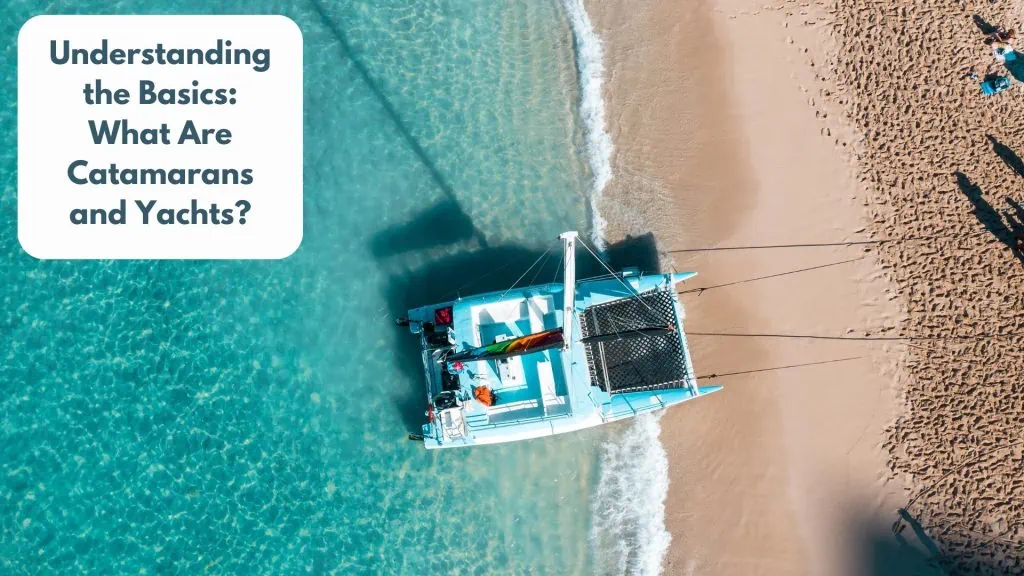
A catamaran is a type of multihull boat featuring two parallel hulls connected by a central deck. This twin-hull design provides more stability, expansive interior space, and shallow draft.
Yachts, on the other hand, have a single continuous hull and are known for their elegant aesthetics, lavish amenities, and versatility for long-range cruising.
Here’s a quick visual comparison of the general shapes and hull configurations:
| Category | Catamaran | Yacht |
|---|---|---|
| Hulls | Two parallel hulls connected by deck | Single continuous hull |
| Shape | Wider, more beamy | Sleeker, narrower |
| Stability | Very stable with minimal rolling | More susceptible to rolling motion |
| Draft | Shallow draft to get closer to shore | Deeper draft requiring deeper waters |
| Living Space | Very spacious, open floor plans | More confined spaces |
Catamarans typically range anywhere from 40 to 70 feet in length, while yachts can be as small as 30 feet or over 100 feet for superyacht models.
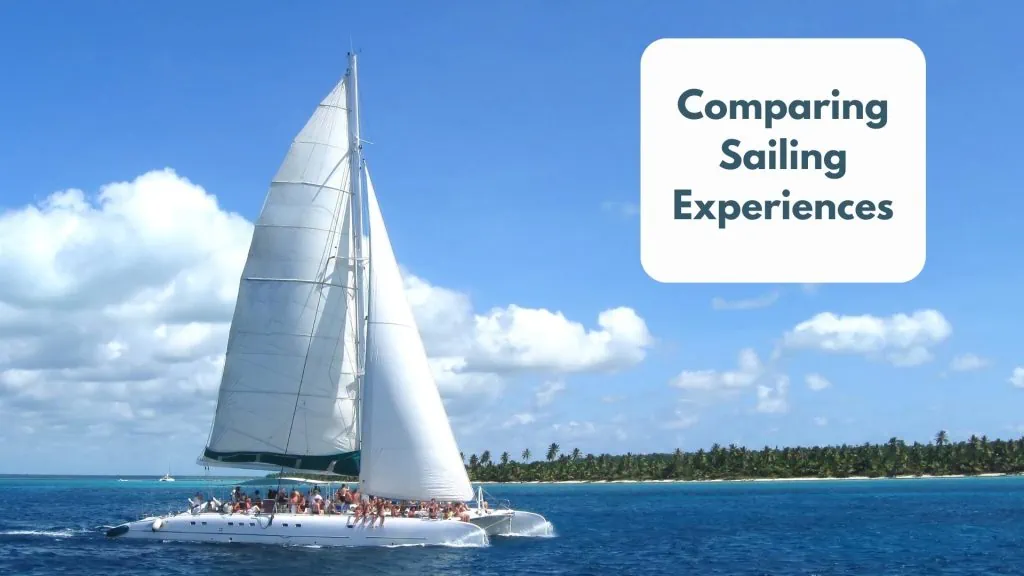
When it comes to maneuverability and sailing dynamics, there are some key distinctions between catamarans and yachts:
- Speed – Catamarans are lighter and have reduced drag, making them significantly faster than yachts. Top speeds can reach up to 25 knots.
- Stability – With their twin hulls, catamarans offer unmatched stability and minimal rocking motion in rougher seas. This also reduces seasickness.
- Maneuverability – Yachts take more skill to maneuver tight spaces, while catamarans can turn 360 degrees within their own length.
- Windward Performance – Yachts point higher into the wind and sail more efficiently upwind. Catamarans excel on reaches and downwind sailing.
So for performance-oriented sailing, monohull yachts have some advantages. But catamarans trade maneuverability for supreme stability and comfort on the water.
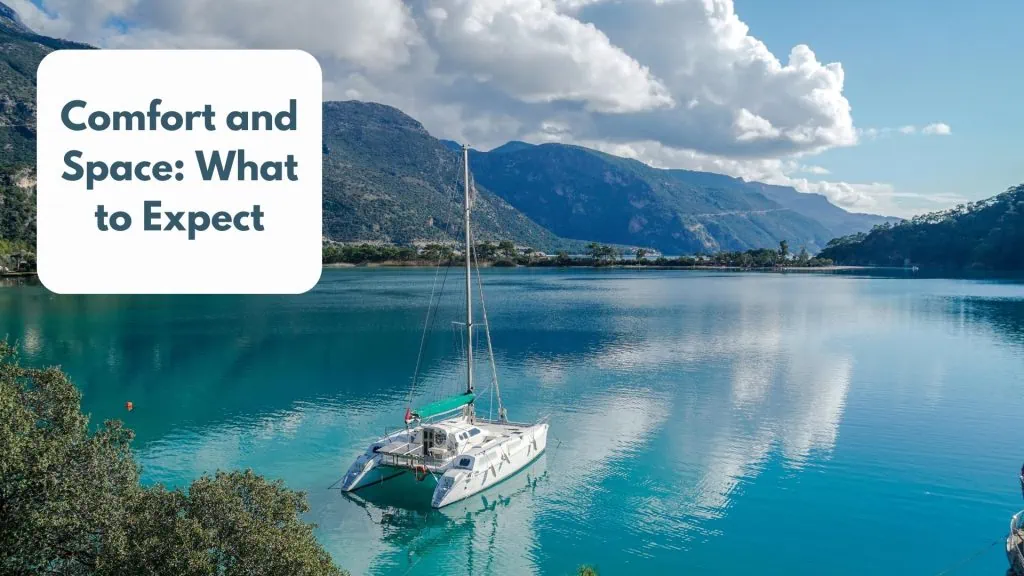
One major differentiation between these two boat types is the onboard living spaces and amenities. Some key comparisons:
- Deck Space – With their spacious bridge deck, catamarans offer ample lounging and relaxation space for large groups. Yachts have more confined deck space.
- Cabins – Catamaran cabins are typically larger and more comfortable. But yachts allow for more privacy when chartering with other couples or guests.
- Entertainment – Yachts focus more on lavish entertainment amenities like high-end sound systems, theaters, and bars. Catamarans offer more outdoor fun.
- Overall Comfort – For stability, living accommodations, and seasickness reduction, catamarans are vastly more comfortable boats.
So catamarans excel when it comes to providing generous living areas for group getaways and family vacations. But yachts are tailored more for couples charters and luxury amenities.
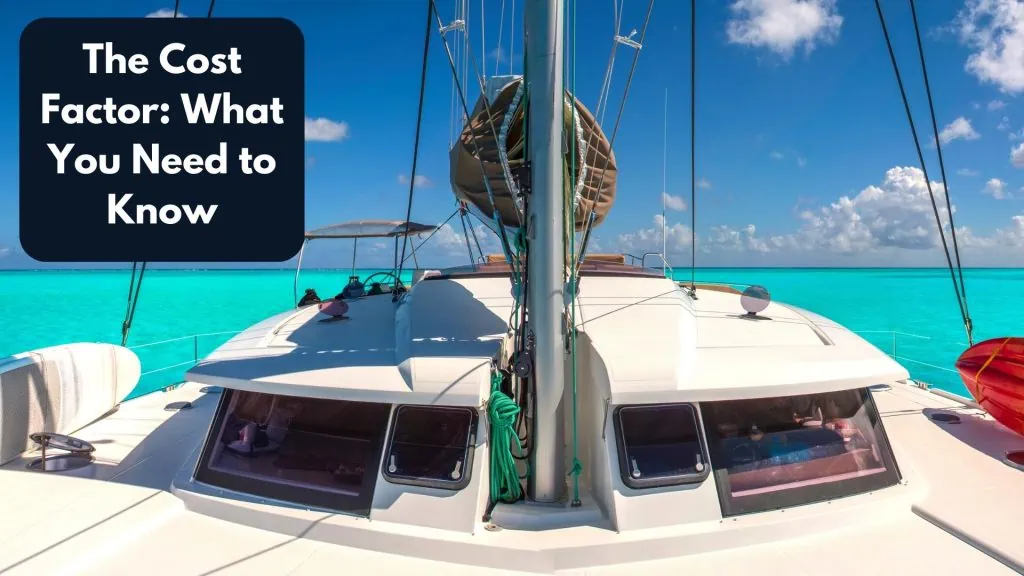
A significant factor to weigh is the overall ownership costs between catamarans and yachts:
- Purchase Price – Due to larger size and dual engines, catamarans come at a higher initial purchase cost. Yachts are more affordable for comparable lengths.
- Fuel Efficiency – With two engines to power, catamarans use almost twice as much fuel to operate. Yachts are more efficient.
- Docking and Marina Fees – Catamarans incur higher fees because they take up more dock space, especially in high-traffic areas.
- Maintenance – More complex systems and dual engines onboard catamarans equate to higher lifetime maintenance costs.
- Resale Value – Depreciation varies widely, but yachts tend to retain resale value better in the pre-owned market.
Clearly, the costs of owning and operating a catamaran are substantially higher compared to a similar-sized yacht. Being aware of these expenses will help determine the right boat for your budget.
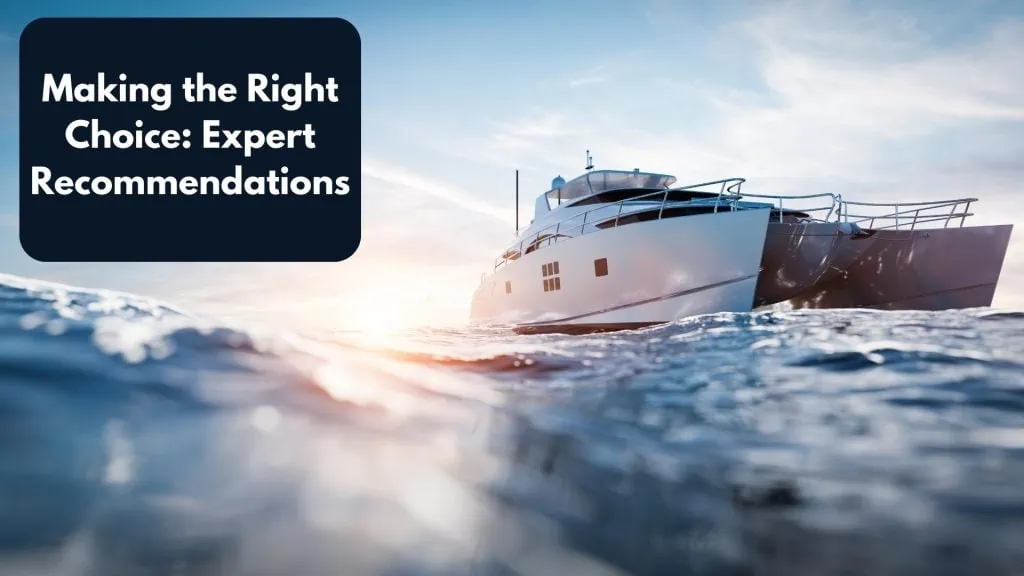
We’ve covered a lot of comparisons, so which boat type is the best choice? Here are some quick recommendations based on needs:
- For comfort, stability, and spaciousness on extended cruising trips – Catamaran
- For performance-focused sailing and nimble maneuverability – Yacht
- For luxurious amenities and entertaining small groups – Yacht
- For exhilarating speed and family-friendly features – Catamaran
- For affordable purchase and lower operating costs – Yacht
Of course, it depends on your individual priorities and boating style. Charter both for a test run to see which you enjoy more. At the end of the day, the right boat is the one that fulfills your needs and invites you to experience the magic of the open water.
Hopefully this guide has provided a helpful overview of the core differences between catamarans and yachts. Let the voyage begin!
- https://catamaranguru.com/catamaran-vs-monohull-we-changed-should-you/
- https://blog.cancunsailing.com/en/diferencia-entre-yate-y-catamaran
- https://www.mbcyachts.com/types-of-yachts-and-their-pros-and-cons/
- https://makaiyachts.com/power-catamaran-vs-monohull/
You might also be interested in reading:

The Top 3 Boat History Report Websites Reviewed
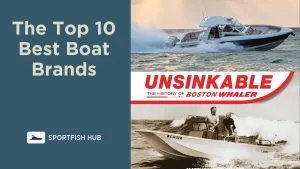
The Top 10 Best Boat Brands
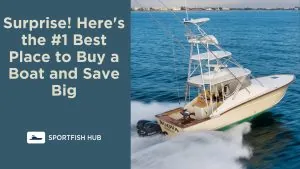
Best Place to Buy a Boat
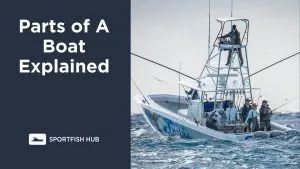
Parts of A Boat Explained
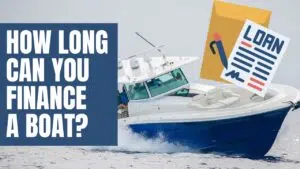
How Long Can You Finance A Boat

Steve Momot
Steve is an accomplished professional photographer and marketer who specializes in the Fishing, Yacht, and Boating industry. With a strong presence as an influencer and marketing expert in the Marine Industry, he has made a significant impact in the field. Additionally, Steve is the original creator and co-founder of Sportfishtrader. Prior to his career as a marine photographer, he gained extensive experience as a licensed boat and car dealer in South Florida.
Leave a Reply Cancel reply
Your email address will not be published. Required fields are marked *
You might also like.

Who Makes The Biggest Sport Fishing Boat?

Fishing Memes

What is Sportfishing?

Sportfish Hub was founded with a clear and unwavering mission in mind: To provide boaters and fishermen with the highest quality content, offering invaluable insights, tips, and resources.
- Terms of Service
- Privacy Policy
SOCial Media
Get in touch, © 2023 | all rights reserved.
Catamaran Vs Yacht
Learn the difference between a catamaran vs yacht charter, what yacht should you charter catamaran vs monohull, what is better to charter a catamaran vs yacht.
Those new to yacht charter and catamaran charter will often ask, what is Better to charter – a Catamaran or Yacht? To assess the catamaran vs yacht question, we need to understand the main differences. A catamaran is, strictly speaking, a yacht with two hulls and a yacht in this context and a sailing vessel with one hull, otherwise known as a monohull.
It’s easily arguable that a sailing yacht was more fun to sail, takes up less room when mooring, and is cheaper per berth than a catamaran. Alternatively, a more stable catamaran offers more space and is cheaper per sq. foot of space.
Until recently, the advent of catamarans in the America’s Cup competitions would show that catamarans are not the slowcoaches they were when you consider the c atamaran vs yacht debate. All catamarans are very nice to sail just off the wind, which will leave some saying that my characterisation is a little skewed. Yet, I would say, in general, for charter catamarans vs charter yachts, the comparison holds.
Your Answer Will Depend on Many Different Variables Such as:
- Advantages of Catamaran Vs Yacht
- Disadvantages of Catamaran Vs Yacht
- Getting Into The Detail
- Thoughts on a Monohull Charter
- How to Book
Here are our 5 Reasons to Hire a Catamaran Vs Yacht
The Pros of a Catamaran Vs Yacht
The 5 reasons to hire a catamaran versus a yacht.
- Space. When weighing the Catamaran Vs Yacht debate, space is one of the key factors by far, but you’ll also see this appoear in our list of disadvantages too. In terms of squarefootage, if you like to pack generaously, or have planty of space for sunbathing, then Catamarans vs Yacht is for you.
- Cabins. Along the same theme, Cabins are generally much more spacious than monohulls. The locker storage space is always much greater than that of a monohull. The greatest advantage is the considerably larger ports (windows), which, when sailing in August, not only gives you a great view but comes in super handy to let in the breeze.
- Stability. Catamarans are notoriously more stable than that their counterpart. This can be beneficial for new or inexperienced sailors who haven’t got their sea legs yet or are prone to seasickness. Due to their two hull design, cats do not heel over more than 5 degrees. This means you don’t have to check that plates are not sliding off the table continuously!
- Draft. Catamaran’s shallow draft (depth of the hull and keel under the water) has some advantages. This is a particular advantage in areas with shallow waters, thus allowing you to anchor closer to shore.
- Power. Catamarans have twin engines. This, combined with the shallow draft, allows the yacht to cruise at higher speeds, whether under sail or using its engines. The two engines also allow greater manoeuvrability in confined areas or spaces, great in marinas or when picking up mooring buoys.
The Cons of Catamaran Vs Yacht
Four things you might want to consider with a catamaran vs yacht.
- Mooring . Due to the width (and size) of a catamaran, often, you have to pay a lot more to book a berth in a harbour for the night. However, some authors can be quoted as saying that anchoring in a cat is easier.
- Upwind Sailing. Catamarans don’t sail up-wind well! Performance cats make up for this with boat speed and by employing daggerboards to prevent leeway (sideways movement). It will be fun trying to sail upwind, but you might not make much progress!
- Steering. Sailors have noted that the helm (be it the tiller or a wheel) is not as responsive as a monohull, you don’t get the same feedback (weather helm) on a cat, and it can feel ‘limp’ to sail.
- The Feel. Most charter cats are built for comfort, so the sailing can be a little disappointing unless you’re on a beam reach.
The Pros of a Yacht vs Catamaran
Getting into the detaila - monohull vs catamaran advantages.
Monohulls offer the ultimate sailing experience for many sailors. Here’s why:
- Dynamic. When considering a monohull vs catamaran, remember monohulls can tack quickly, thus making them a lot more manoeuvrable than a cat. Nothing beats the rhythmic feeling of sailing whilst heeling over.
- Responsive. They are also fairly responsive to the helm.
- Up-Wind. These vessels are much more capable up-wind than most catamarans. They can sail much closer angle to the wind than a cat.
- Budget. Monohulls are cheaper to buy (fewer materials) than catamarans, often aimed at the luxury market and significantly less to charter. Berth for berth, cabin for cabin, a monohull is usually better value for money.
- Berthing costs. With twin engines, expect to put a little more fuel in your cat. The cost of berthing in a harbour or at a marina tends to be significantly lower due to the reduced beam (width).
The Last Case for a Monohull!
There are good reasons to consider a catamaran vs yacht, but if you love being up close and personal with your crew and you love dynamic sailing, here’s the big advantages.
- Snug. Modern charter monohulls are wide with high ceilings and have plenty of space in cabins and for stowage. That said, the usable space on a monohull is much less than that of a catamaran.
- Heeling. The boat heeling or “leaning” over is perfectly normal and something you get used to quickly. This can be tricky for the young and old and makes handling the boat a little more adventurous.
- Draft. Due to the deeper keel (the stabilising fin below the yacht), you cannot sail in shallow waters and must be more vigilant of your depth.
Learn More About Chartering a Catamaran Vs Monohull
As you can see, there are many pros and cons to consider when deciding between a catamaran vs yacht. Whilst the debate between monohull sailors and multi-hull fanatics will rage, it largely depends on what you are using the boat for, where, your budget, and your crew.
If you have the opportunity to decide if you prefer a catamaran vs monohull, by sailing both types of boats, then take it so you can assess the benefits of both wonderful sailing boats.
If you are planning a sailing trip and are a little unsure, why not get in touch, and we can help you decide what is best for your location and crew.
Amazing Sailing Experiences
Our amazing customers.
I didn't think sailing with my family would be so much fun...
Sailing for the first time.

Everything went smooth, the paper processing, special requests and the specs of tht check-in procedure. Boat was also in good shape, so no complaints and a worry free holiday...
We had a great experience with booking through sailchecker.
Informative and looked for the best value for our family. Very good customer service on this side and in Greece. Great boat and skipper...
Fantastic holiday from start to finish.
They were very responsive and very quick to answer questions via email and instant chat. They had extensive knowledge of the area...
We will most definitely use their services for our next bareboat sailing vacation.

Sailchecker were professional from start to finish - and were awesome dealing with a problem! Our first Yacht had serious issues and sail checker helped us to resolve it...
They are easy to deal with, straightforward and honest and I would recommend them to anyone planning a charter holiday.

During the Coronavirus pandemic, Kate and her colleagues at Sailchecker have performed brilliantly. They have been considerate and highly efficient in re-organising our Turkey charter and also provided lots of assistance in getting our Yacht Security Deposit insurance policy transferred to match our revised charter dates.
Truly worthy of a 5 star rating!

Would I go sailing again? OMG yes! Sailing is the perfect family holiday. Boys loved the activities, I enjoy relaxing as well...
Sailchecker.com arranged a sailing cruise her family of 2 sons, daughter & hubby in the BVI with their own.

It was sail in the day… party at night. We couldn't have wanted a better skipper or a Spring Break! Good times...
Arranged for 6 friends to sail Spring Break in the British Virgin Islands for under $500 each.

All bookings and confirmations was always accurate with no delays. Our boat was also fabulously maintained and the Skipper new the area extremely well...
Everything was down to the tee.

Rated 4.9 out of 5 based on 215 reviews on Trustpilot
Got a Burning Question About Catamaran Vs Yacht?
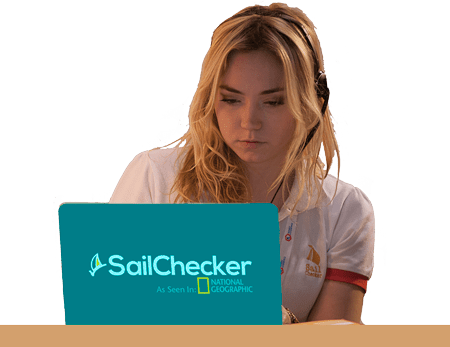
Founder Member IFCYA
Yacht Charter & Sailing.

Start typing and press Enter to search


What Is The Difference Between A Yacht And A Catamaran?
- Post Written By: Boater Jer
- Published: July 14, 2022
- Updated: July 22, 2022

Disclaimer: You might notice that we recommend products in some articles. We may earn a commission for referring you if you click the link and buy a product.
We only recommend products we’ve tried/tested/own (that’s why you won’t find thousands of affiliate links on my site). If you have experience with one of the products we’ve mentioned, please share your experiences in the comments at the end.
What’s the difference between a yacht and a catamaran? Let’s dive in and find out!
Yachts are classically assumed to be medium-sized sailing ships. Today we assume a yacht is a large, luxurious, monohull vessel. Alternatively, catamarans are designated by having two hulls. Catamarans can also be large and luxurious, classifying them as a yacht. Therefore a catamaran can also be a yacht, but a yacht may not necessarily be a catamaran.
This article is just what you need if you’re new to the sailing scene and can’t seem to decide which of the vessels mentioned above to hit the open ocean.
Although technically a catamaran may be a yacht, in popular culture, a yacht is assumed as a monohull. Below is a detailed breakdown of the difference between a yacht and a catamaran. ( source )
Differences Between A Yacht And A Catamaran
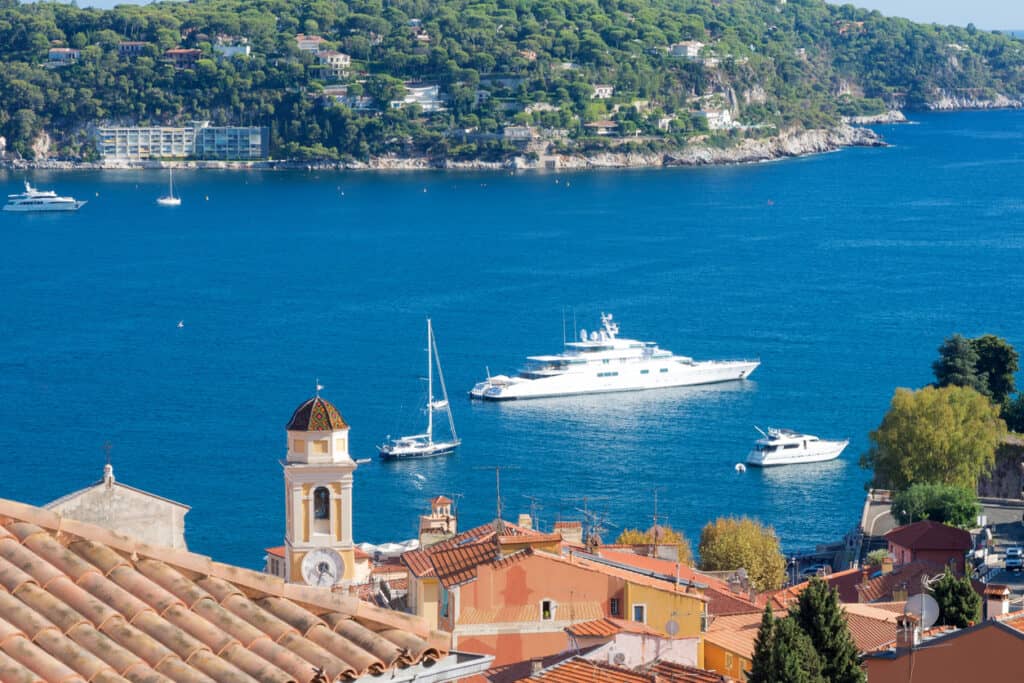
Number Of Hulls
The hull of a sailing vessel is simply the part of the vessel that sits in the water. Yachts have one hull, while catamarans have two hulls.
A sailing vessel with multiple hulls can explore more ocean depths than one with a single hull. It is because very little of the boat is underwater.
Due to this distinctive feature, yachts heel over more than catamarans, making them unsuitable for new sailors, children, or older people.
With that said, let’s look at the difference between a yacht and a catamaran regarding maneuverability.
Level Of Stability, Safety, Efficiency, And Displacement
The primary distinction, as noted, is that a catamaran has two hulls compared to a monohull yacht. These two hulls allow excellent stability for the watercraft with a much lower chance of capsizing and half the chance of sinking compared to a single hull.
Although, a sailing catamaran can always blow over in the incorrect use of sails in windy conditions, just like a sailing monohull can. The difference is that a catamaran is much more challenging to right itself if it goes over. Therefore, it’s best to understand all the principles of sailing before taking out a sailing vessel, regardless of whether or not it’s a catamaran or a monohull.
Unlike yachts, catamarans generally have a minimum of two engines. These motors enhance the level of maneuverability of the vessel.
In other words, catamarans are easier to pilot or maneuver than yachts of the same length.
Furthermore, the presence of a second engine on a catamaran makes it noticeably more potent than a yacht. And they are faster boats, too, because they don’t need to sit as deep in the water due to two hulls sharing the overall weight of the vessel.
A monohull carries all the weight on a single hull, causing the hull to sink deeper into the water. Given that water has greater friction than air, a hull deeper in the water will have greater resistance. Therefore, by nature of design, the more hulls, the faster a craft can go and the less power it consumes to go at a similar speed as a monohull, meaning it is also more efficient.
Size Of Space
You can quickly tell the difference between a yacht and a catamaran by size or space. Yachts are not as roomy or sizeable as catamarans of the same length.
You get bigger cabins, sitting areas, ample bathrooms, and wide galleys with catamarans.
The downside to the size or spaciousness of a catamaran is that it’d cost you a lot more to book an overnight berth.
When choosing between a yacht and a catamaran, consider the number of people you’d like to bring on board.
Sailing Experience
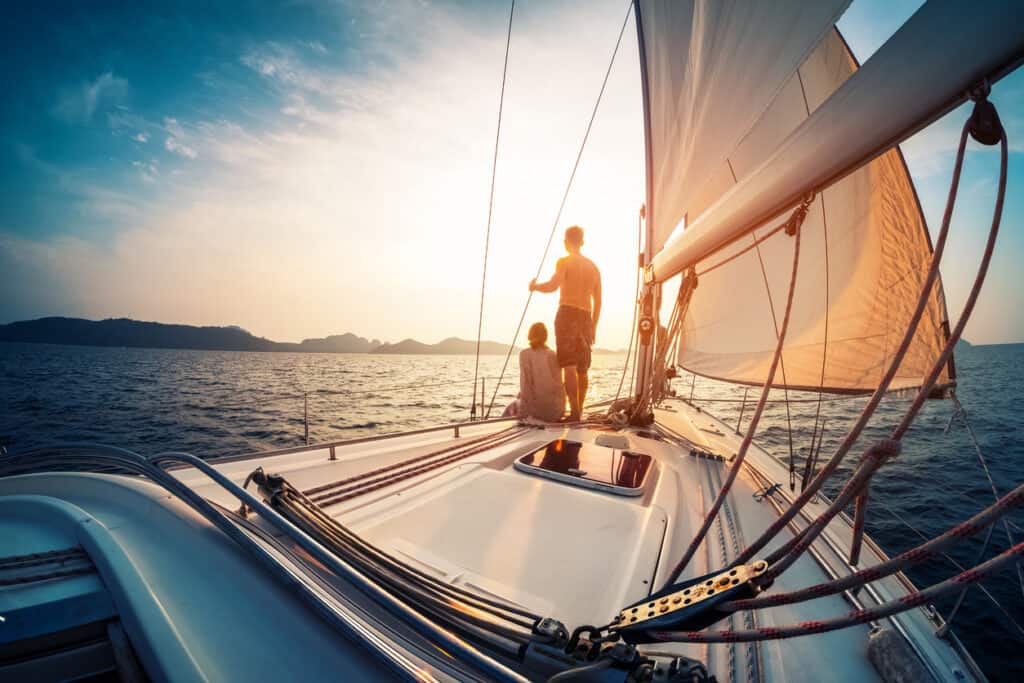
Yachts and catamarans do not provide the same sailing experience. Many people believe that yachts are more exhilarating to pilot than catamarans.
It is pretty simple; catamarans don’t give as much feedback as yachts do when you manipulate their helm.
Additionally, the design of catamarans makes it nearly impossible to sail them upwind. So, a yacht is your best bet if you’re looking to enjoy a thrilling upwind sail.
As you may know, the cost is a critical criterion in identifying the difference between a yacht and a catamaran.
The amount you pay to own or charter one of these vessels depends on the size and type of vessel you choose.
Generally, catamarans are more expensive than yachts of the same length, which is not surprising given that two hulls and a bridge will be more work to build than a single hull.
- Latest Articles
- Articles Sources
- Crab Island by Pontoon: A Fun Watery Boating Guide Destination in 2024
- Upgrade Your Boating Experience: Adding a Third Pontoon Made Easy!
- How Long Does It Take A Canoe To Go… (Canoe Calculator Here)
- In-Depth Review of the Pelican Sentinel 100X Fishing Kayak: Pros, Cons, and Performance
- How To Put A Kayak In The Water – The Ultimate Guide For New Kayakers
Catamaran vs. yacht: How to find the right vessel for your travels https://www.traveldailynews.com/post/catamaran-vs-yacht-how-to-find-the-right-vessel-for-your-travels
perfectrolex.sr
Share this post with your friends, subscribe to our newsletter.
Join us in our love for all things water. And Adventure.

The Amazing Rise Of Catamaran Sailboats (3 Points You Didn’t Expect)
Let’s talk catamaran sailboats. Many people ask me about them, and I’ve even had some ask what a catamaran is. So I wrote this article to dispel some of the myths and get all of us on the same page regarding what is one of my favorite boat designs, the catamaran sailboat. Rather than having
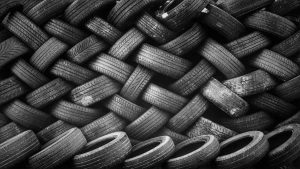
Boat Trailer Tire Guide
A boat trailer tire is something that is neglected by most everyday people. In other words, a tire is an underrated part. However, the main question arises that is a tire underrated, or is it just a myth? This section deals with the factors and facts that are related to the boat trailer tire. It’s

Boat Repair- The Truth About Eisenglass Vs. Vinyl
If you’re a boat owner, you must have come across eisenglass vs. vinyl. Yes, they’re world-famous materials used to make clear glass windows. Since they’re thin strips and durable, they don’t take up much space in the boat. However, when repairing the vessel, you might want to reconsider whether to install eisenglass or vinyl. Wondering
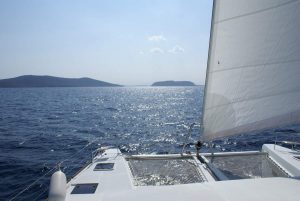
Staying Safe On A Catamaran: 24 Essential Tips
When you’re heading out on the water, having a good time is usually the first goal. I mean, let’s be realistic, most people who plan on going out on a boat are thinking first of the fun time, and second about safety. And if you’re intending to go out on a catamaran, depending on what type and size of the cat, there’s going to be some different circumstances that you’ll want to pay attention to for your own safety and the safety of those you have with you on board.

Does Marine Grade Plywood Warp and Rot? Is it Waterproof Plywood?
Updated April 27, 2021. Working on a boat build is a great and time-consuming endeavor. The last thing a boat builder wants is to use materials that will not be conducive to a wet environment. Moreover, one is likely asking the question, “Does marine grade plywood warp and rot?”. Although marine plywood avoids warping and

Comparison Between Trawler Vs Catamaran Boats
Looking for answers about trawler vs catamaran boats? You’re in the right place. Trawlers and catamarans are ideal sailing vessels for various use in terms of commercial transport, fisheries, sea patrols, research, and more. The distinct feature between the two boats is the hull composition. Trawlers consist of a single hull or monohull, while catamarans

Boat Information By Type
© 2023 Boating.Guide, A Hyperwave Media Group Ltd. Publication.
Privacy Overview
- Yacht V Catamaran
Find a Boat
Why book with us.
Competitive prices, Exceptional Service
ONLY Professional Charter Fleets
Rated 4.9/5 on Feefo
Super-low 25% deposit
Yacht v Catamaran
What are the main differences between sailing a yacht and a catamaran?
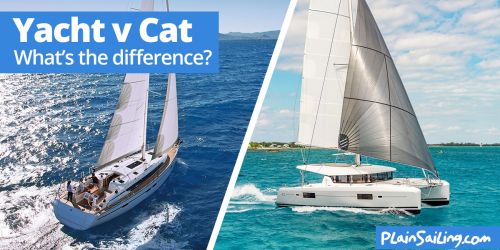
If you’re new to sailing (or even if you’re not) then you might be wondering what the main differences are between sailing a yacht or a catamaran – here’s a quick summary, from the obvious to the nuanced:
Shape / Number of hulls
The main difference is the shape of the boat: a yacht or traditional sailing boat has one hull (the bottom of the boat) which sits in the water, but a catamaran is a ‘multi-hull’ so has two hulls or points of contact with the sea, with a platform across the top which joins the two hulls together into one boat shape. The fact there are more hulls on a catamaran is the key difference between the boats, and everything else below derives from this.
The two hulls also mean that less of the catamaran is below the water, meaning that they can sail in shallower waters – as a result, in some parts of the Caribbean, they pretty much only charter catamarans.
Sailing Experience
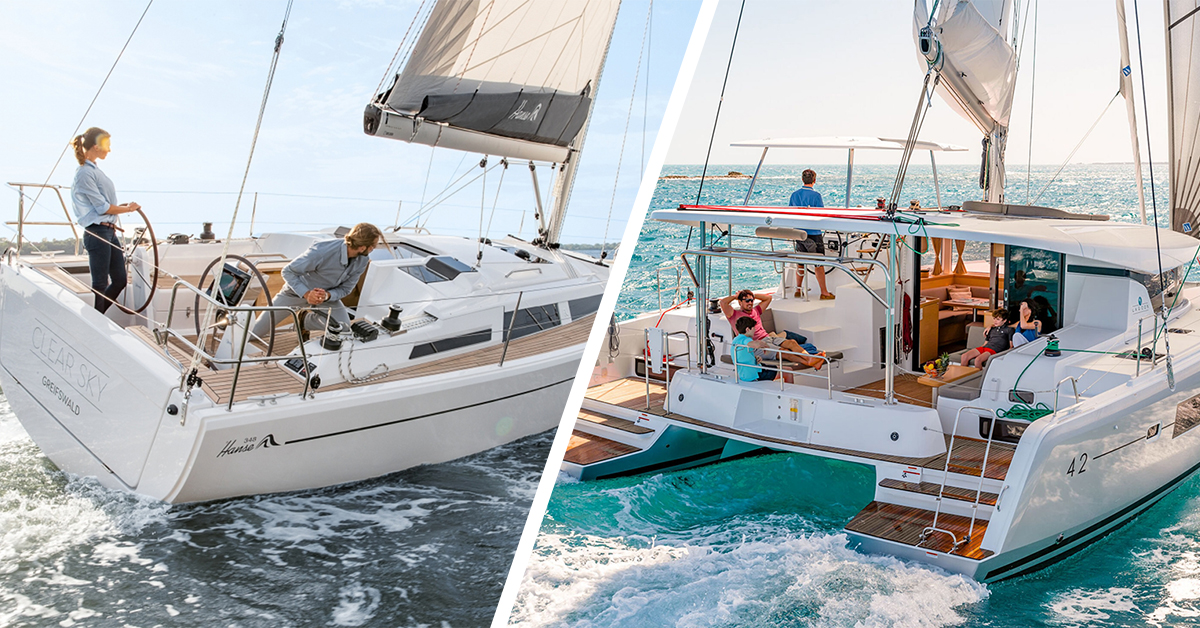
Whilst you’ll get more adrenaline on a yacht, the flip side of the sailing experience is that a catamaran, precisely because it has two hulls, is better balanced – so it is a lot more stable to sail on. It will move a little with the water, but it won’t heel over in the same way as a yacht, which makes it more predictable and better suited to beginners and for e.g. kids to find their balance and to walk around on deck when you are at sea.
So a catamaran is less exhilarating for the actual sailing bit, but you might decide that the pros more than outweigh this.
Manoeuvrability (in the marina)
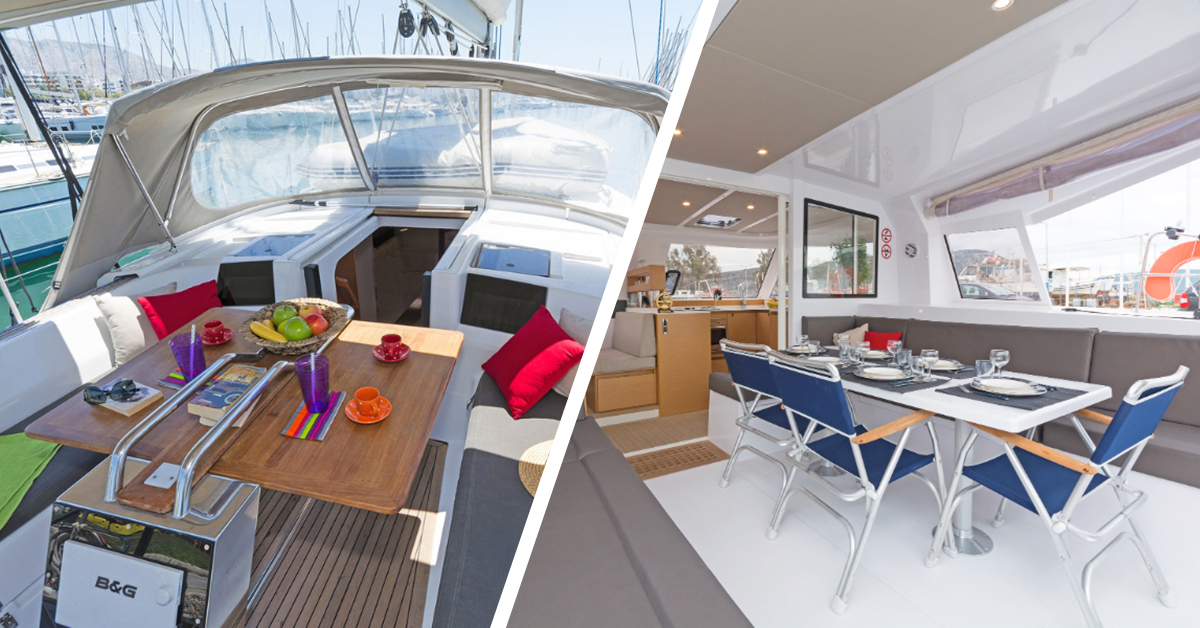
In addition, because there are two hulls, then the wind speed and direction have less of an impact on a catamaran (though the wind hits the windward hull the same as a yacht, the second hull helps to steady the ship, so it has a lot less effect).
A yacht, with a single motor to control speed and direction, and a single hull being blasted by the wind, is trickier to navigate at close quarters with other boats, and requires some experience or fore-thought (or both!) to moor up in a marina, particularly when conditions pick up.
Space on board and in the cabins / Comfort / Luxury
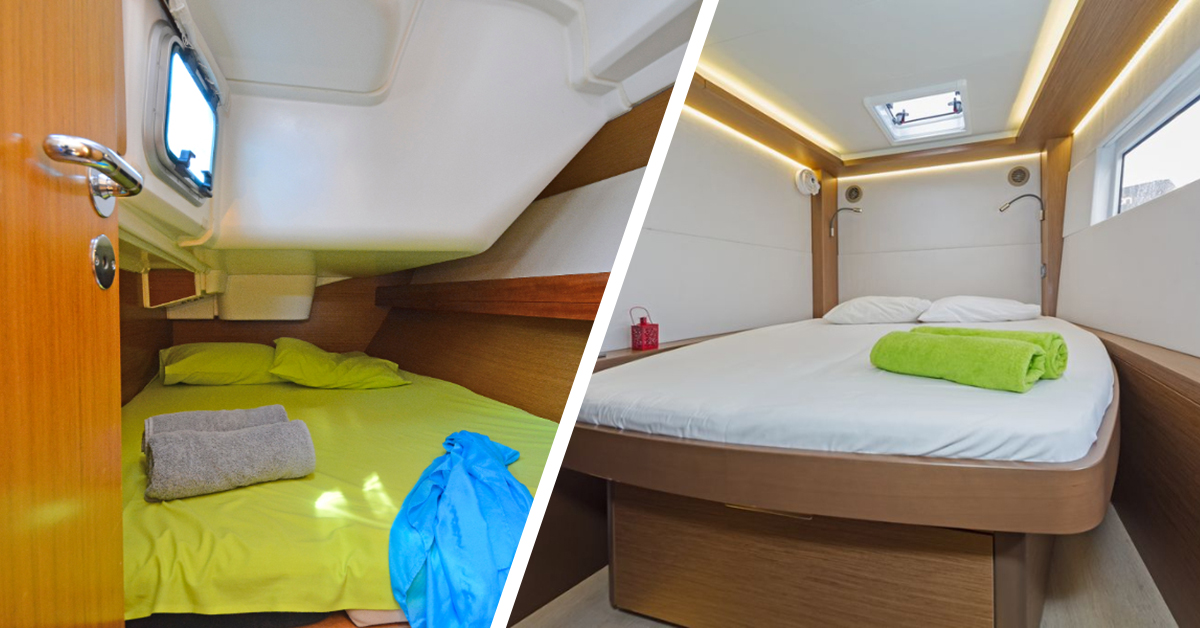
The extra width is used to create larger seating areas on a catamaran, more spaces to sit and socialise in (as opposed to just the cockpit or saloon area on a yacht), bigger cabins (and beds), more bathrooms (or ‘heads’) – often most cabins on a catamaran are en-suite, whereas on a yacht, you will likely be sharing two or three toilets between everyone on board.
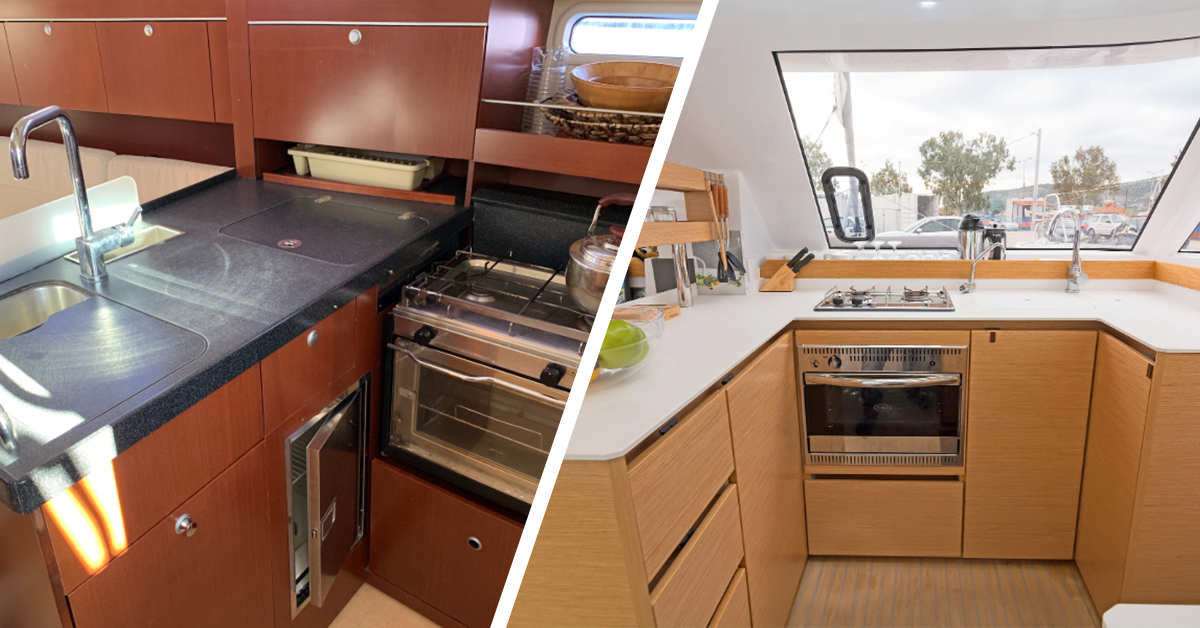
However, a yacht has been specifically designed to be the right size for the number of people on board - so they don’t feel cramped, and they have all the kit you need to enjoy a week away at sea. And one issue with all that space on a catamaran is that it’s possible to lose the closeness that comes from a week of forced shared time and togetherness spent in the heart of a yacht.
Price
As they are bigger and more expensive to buy, it costs more to charter a catamaran than a yacht – if you use the pink box and search ‘all’ then you’ll get a list of available boats for your week and PlainSailing.com base, which now shows both yachts and catamarans, and it’s easy to see the price difference (usually about 50% to 100% more).
Catamarans also attract larger marina fees (since they take up more space in the marina) for the nights you spend in a marina, and, with two engines, you’ll use twice as much fuel in a catamaran as you do in a yacht – which you will also have to factor into your costs.
PlainSailing.com recommends!
We can help you arrange a charter yacht or catamaran in Croatia, Greece, Italy, the Med, and in the Caribbean. What we'd recommend depends upon what type of sailor you are, and what sort of holiday you are after:
Catamarans are great for people considering a skippered charter, for people new to sailing, and for anyone sailing with kids (of any age) as they offer more space and luxury, and it is more like an exciting floating holiday home.
Yachts are fantastic for people who are on a sailing holiday for the thrill of the sailing, who like to ride the waves, and enjoy exploring and life at sea for a reasonable price.

Catamarans: A Complete Guide to Multihull Boats
Catamarans have been a part of sailing history for centuries and continue to be popular for their stability, spaciousness, and performance. Developed by various cultures around the world, the principles of catamaran design have evolved over time to become optimized for both pleasure cruising and racing. This complete guide will help you understand the essentials of catamarans, their unique characteristics, and how to choose the right one for your needs.

From the basic concepts of multihull design, performance, and handling, we will explore the advantages and benefits of a catamaran in terms of safety and comfort on board.
Along the way, we will discuss maintenance considerations, distinctive catamaran brands and models, and how a catamaran lifestyle can compare to more traditional sailing options .
Finally, we will provide learning resources and frequently asked questions tailored to both seasoned sailors and newcomers to the world of catamarans.
Key Takeaways
- Catamarans are known for their stability, spaciousness, and performance
- This guide covers aspects like design, handling, safety, and choosing the right catamaran
- Resources and frequently asked questions provide additional insights for potential catamaran owners
Understanding Catamarans
Design Characteristics
Catamarans are known for their unique design, which features two parallel hulls connected by a deck. This design provides several advantages over traditional monohull boats, such as stability and speed.
With their wide beam, catamarans have a reduced risk of capsizing and can access shallow waters due to their shallow drafts 1 .
One of the notable aspects of a catamaran is its twin hulls, which offer increased living space and comfort compared to a monohull. Additionally, catamarans are often favored by recreational and competitive sailors for their excellent maneuverability 2 .
The materials used for constructing catamarans range from wood to fiberglass, and even aluminum for high-performance vessels. Aluminum catamarans are known for their strength, lightweight structure, and resistance to corrosion 3 .
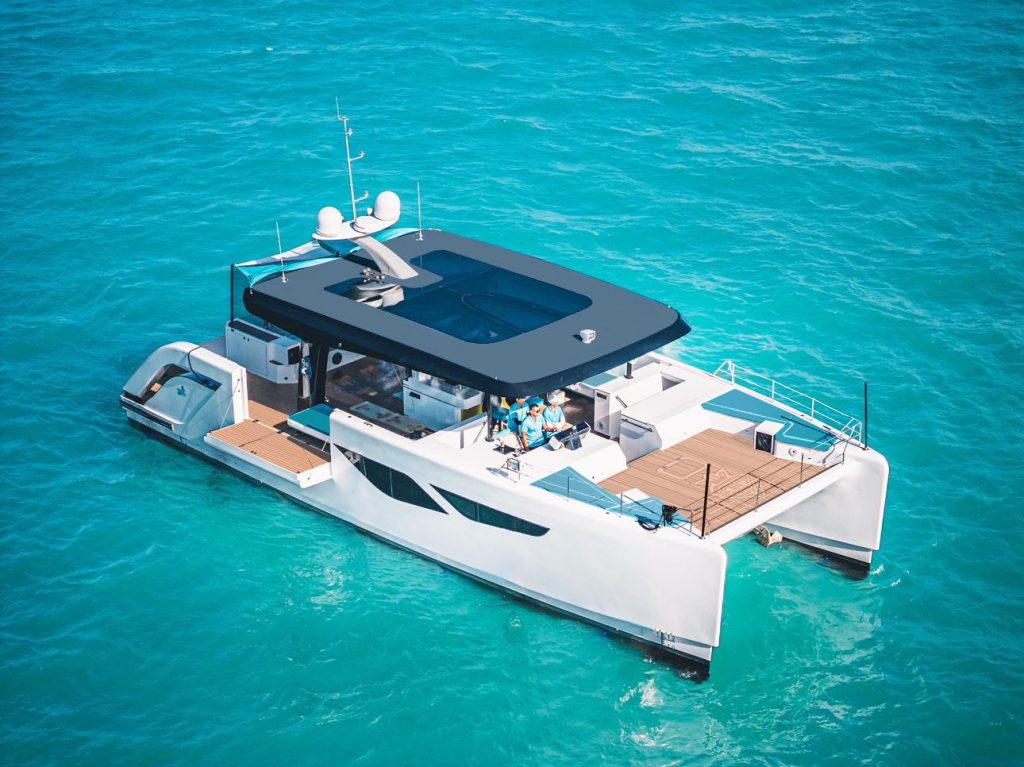
Hulls and Construction
The hulls in a catamaran are crucial to its stability and performance. These hulls help distribute the weight evenly across the water surface, minimizing drag and allowing for smoother sailing.
In general, the hulls can be categorized into two types:
- Symmetrical Hulls : The hull shape is similar on both sides, which enhances balance and stability in various sailing conditions.
- Asymmetrical Hulls : One side of the hull is designed differently than the other, which can be advantageous when sailing upwind.
The construction materials used in building catamaran hulls also play a vital role in the boat's performance and durability. Common materials include:
- Fiberglass : A popular choice due to its lightweight, strength, and ease of maintenance.
- Wood : Traditional material that offers a classic look, but requires more maintenance than fiberglass or aluminum.
- Aluminum : Lightweight and strong, aluminum is an excellent choice for high-performance catamarans 4 .
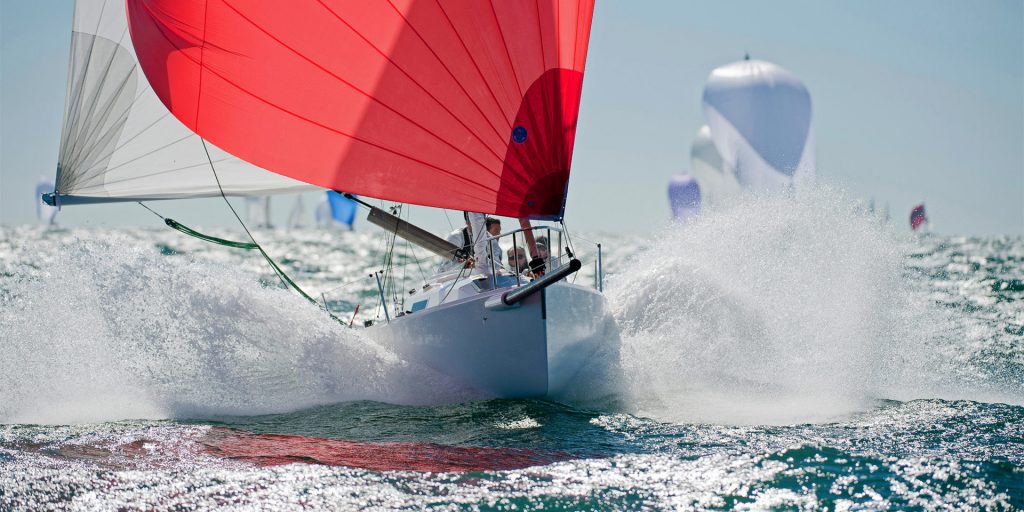
Multihulls vs Monohulls
There's often a debate between the benefits of multihull boats, such as catamarans or trimarans, and monohull boats. Here are some key differences between the two:
- Stability : Due to their wide beam and reduced heeling, catamarans offer improved stability compared to monohulls. This makes them an attractive option for those who want to avoid seasickness or feel more comfortable on the water 5 .
- Speed : Multihull boats are known for their speed, which results from their ability to minimize drag and maintain a level sail.
- Living Space : Catamarans and other multihulls generally have more living space, as both the hulls and the connecting deck can be utilized for accommodation and storage.
- Maneuverability : While monohulls are known for their agility and ability to point close to the wind, catamarans can still offer exceptional maneuverability when properly sailed 6 .
Performance and Handling
Speed and Efficiency
Power catamarans have gained popularity for offering a unique combination of speed, efficiency, and stability. Their dual-hull design allows for less water resistance, which directly translates to higher speeds and better fuel efficiency compared to traditional monohull boats.
In addition, the wide beam provided by the two hulls ensures a stable ride even at higher speeds. This makes power catamarans ideal for cruising, fishing, and watersports ( Boating Beast ).
Sailing Dynamics
When it comes to sailing catamarans , the performance is affected by factors such as keel, rudders, mast, and sails.
Their wide beam and dual-hull design provide inherent stability and reduced heeling effect, making them less likely to capsize compared to monohulls.
I should also note that catamarans have a shallow draft, which gives them the ability to access shallow waters that may be off-limits to other boats ( Navigating the Waters ).
In my experience, the lighter weight of a catamaran and its aerodynamic design can contribute to remarkable sailing performance under different wind conditions.
The larger sail area relative to hull weight allows them to harness more wind power, further enhancing their speed and agility on the water.
Maneuvering and Docking
Maneuvering and docking a power catamaran involves understanding its unique handling characteristics.
The presence of two engines in separate hulls allows for more precise control in confined spaces such as marinas.
The maneuverability of these boats is typically improved by the use of dual rudders that are located close to each powered hull for efficient steering ( BoatUS ).
When docking under power, I find it helpful to carefully assess the wind and current conditions beforehand.
This is because catamarans can be more sensitive to windage due to their larger surface area above the waterline.
By understanding how these forces may affect the boat, I can make adjustments to my approach and successfully dock the catamaran without any incidents.
Safety and Comfort on Board
Safety Features
Safety is a top priority when sailing any type of vessel, including catamarans. A well-built catamaran offers several features aimed at ensuring the safety of those onboard.
First, catamarans have inherent stability due to their wide beam and twin hull design . This makes them less prone to capsizing than monohull boats. This stability allows me to confidently navigate various water conditions .
In addition to stability, catamarans are designed with positive buoyancy, making them almost unsinkable . Of course, safety equipment such as lifejackets, flares, and first aid kits should always be onboard and well-maintained.
Furthermore, you should also stay updated on weather conditions, avoid sailing in high-risk areas, and learn your boat's safe sail limits.
Living Spaces and Comfort
When it comes to living spaces, I value comfort and practicality as essential features for my time on the water. Catamarans offer a unique advantage in this regard, as their dual hulls create spacious living areas.
Most catamarans are designed with separate cabins in each hull, allowing for privacy and comfort when sleeping. Additionally, these boats typically feature shallow drafts , which means I can access shallow waters and anchor close to shore.
The main living area, or salon, is situated on the bridge deck between the hulls. It usually includes a seating area, a dining table, and a galley (kitchen). Large windows provide ample natural light and panoramic views, making the space feel open and bright. Some catamarans even have the option for an additional living area on the upper deck where you can enjoy the sun and breeze.
One aspect of catamaran living I truly appreciate is the ample storage available. Each cabin typically has built-in storage spaces for clothes, gear, and personal items. There are also designated areas for equipment such as spare sails, tools, and water toys. This makes it easy for me to keep my belongings organized and make the most of my time on the water.
Maintaining a Catamaran
Routine Maintenance
In order to keep my catamaran in the best possible shape, I make sure to perform routine maintenance tasks. These tasks are essential to extend the life of the components and ensure smooth sailing:
- Cleaning : Regularly cleaning the deck, hulls, and sails prevents buildup of dirt, algae, and other debris that could affect performance.
- Inspection : Periodically inspecting my catamaran allows me to detect any potential issues before they become significant problems. I pay close attention to the rigging, sails, and lines on my boat.
- Lubrication : Keeping all moving parts lubricated is vital to prevent friction and wear on components such as winches and pulleys.
- Antifouling : Applying antifouling paint to the hulls of my catamaran helps prevent the growth of marine organisms that can damage the boat and reduce its speed. Make sure to do this at least once a year.
Dealing with Wear and Tear
Despite my best efforts to keep my catamaran well-maintained, wear and tear is inevitable. Here's how I deal with common issues that could arise from regular use:
- Repairs : When I notice signs of wear on sails, lines, or rigging components, I make it a priority to repair or replace them promptly. Neglecting these issues can lead to more significant problems and affect the boat's performance.
- Hull maintenance : If I find dents, scratches, or stiff rudders on my catamaran's hulls, I address them immediately. Repairing any damage not only ensures smooth sailing but also prevents further issues from developing.
- Sail care : Over time, my sails can become stretched, torn, or damaged due to exposure to sun, wind, and saltwater. Regularly inspecting them for signs of wear and making any necessary repairs or replacements helps maintain optimal performance.
- Rust and corrosion prevention : Since my catamaran is made of various metal components, I need to protect them from rust and corrosion. I routinely check for signs of corrosion and apply anti-corrosive treatments when needed.
Catamaran Brands and Models
High-Performance Models
In recent years, there has been a growing interest in high-performance catamarans. I have seen a variety of brands and models that have impressed me with their performance capabilities. One notable brand is Fountaine Pajot , which has a long history of producing a range of sailing catamarans and power catamarans. Some of their popular models include the Tanna 47 and the Bali 4.4 .
Another high-performance catamaran I've come across is the Leopard 40 . Known for their speed and exceptional handling in various conditions, the Leopard brand started with sailing catamarans and has since expanded to include power catamarans. Their models range from 40 to 53 feet long, offering both power and luxury for those looking for a thrilling experience on the water.
Cruising Catamarans
When it comes to cruising catamarans, the Lagoon brand is synonymous with luxury and comfort. With a range of sailing catamarans from 40 to 70 feet long, Lagoon offers spacious catamarans for extended bluewater cruising. Their 60- and 70-foot power catamarans are equally impressive, providing ample living space and smooth sailing experiences.
I've also found the Aquila 42 PC to be a remarkable cruising catamaran. With a focus on design and innovation, Aquila has produced catamarans perfect for exploring the open sea with friends and family. Their spacious, stable designs allow for a more enjoyable and serene journey, ensuring you arrive at your destination comfortably.
The Catamaran Lifestyle
Anchoring and Cruising
I find catamarans to be a fantastic choice for cruising and anchoring , which is a critical part of living the catamaran lifestyle . Catamarans have several advantages when it comes to anchoring and cruising, such as:
- Stability : Due to their wide beam and twin hulls, catamarans remain stable during anchoring, which reduces the risk of seasickness.
- Shallow draft : Thanks to their shallow draft , catamarans can anchor close to shore, enabling better access to protected coves and more beautiful beaches.
- Speed : Despite their large size for cruising vessels , catamarans are generally faster than monohulls. This is a result of their slim hulls and reduced water resistance.
When it comes to anchoring, catamarans can make use of their shallow draft to anchor in locations that other boats cannot. This allows for a greater range of cruising spots, which makes the overall experience much more enjoyable and unique.
Living on a Catamaran Full-time
For many catamaran enthusiasts, the dream of living full-time on a catamaran is entirely possible. While not without challenges, there are several factors that make living aboard a catamaran an enjoyable experience:
- Spacious living areas : Catamarans generally have more living area compared to monohulls, providing ample space for the whole crew.
- Privacy : The separate hulls allow for private cabins, ensuring that everyone on board has their space.
- Stability : As mentioned earlier, catamarans are stable vessels, making living on them more comfortable than monohulls.
Choosing Your Catamaran
Comparing Models and Features
When I start to look for the perfect catamaran, the first thing I focus on is comparing various models and features .
I determine the key factors that are essential for my needs, such as size, passenger comfort, and performance. By doing so, I can identify which catamaran models are most suitable for me.
For example, if I plan to sail with a large group, I would look for a catamaran that offers ample space both inside and out.
To help me with my comparisons, I usually create a table or list of the different models and their features:
| Model | Size | Comfort | Performance |
|---|---|---|---|
| A | 40ft | Spacious | High |
| B | 35ft | Average | Average |
| C | 45ft | Luxury | High |
This visual aid makes it easier for me to sort the options and prioritize my considerations, such as price, yacht type, and brand.
New vs. Second-Hand
Another critical aspect of choosing a catamaran is deciding between a new or second-hand boat.
Both options have their pros and cons, and ultimately it depends on my preferences and budget.
If I can afford a new catamaran, I get the advantage of the latest design , features, and technology. Plus, I typically receive better warranty coverage and support from the manufacturer.
However, new catamarans are more expensive and can have long wait times due to high demand.
On the other hand, purchasing a second-hand catamaran can save me a significant amount of money, and I might find a high-quality boat with low mileage or well-maintained by the previous owner.
However, this option carries more risks, as I need to be knowledgeable about potential maintenance issues and conduct a thorough inspection before purchase.
Learning Resources
Books and Manuals
When it comes to learning about catamarans, there are plenty of books and manuals available.
One of the highly recommended books is Multihull Voyaging by Thomas Firth Jones. This book provides a comprehensive understanding of multihulls, including catamarans, and is an essential guide for any beginner sailor.
Another great book to check out is Catamarans: The Complete Guide for Cruising Sailors by Gregor Tarjan.
With a foreword by Charles K. Chiodi, publisher of Multihulls Magazine, this book covers all aspects of cruising catamarans. It includes detailed information on design, construction, and maintenance, as well as tips and tricks for sailing a catamaran.
Here are a few more books that I find valuable:
- The Catamaran Book by Tim Bartlett, an excellent resource for both beginners and experienced sailors
- Catamaran Sailing: From Start to Finish by Phil Berman and Lenny Rudow, a comprehensive guide to both catamaran racing and cruising
Online Content and Photography
In addition to books, you can find plenty of online content and photography about catamarans.
Websites like Sailaway Blog and Boating Guide offer tips, techniques, and how-to articles for sailing catamarans.
Many of these sites also include stunning photography, showcasing these beautiful vessels in action.
For those who prefer Kindle or e-books, many of these resources are available in digital format.
This makes it easier for you to access them anytime, anywhere, allowing you to keep learning and improving your catamaran sailing skills.
To further enhance your knowledge, you can also join online forums and communities dedicated to catamarans.
These platforms provide invaluable advice and first-hand experiences shared by fellow sailors, as well as recommendations for additional learning resources.
Frequently Asked Questions
What factors should be considered when choosing a catamaran for full-time living?
When choosing a catamaran for full-time living, consider its space and layout , as it will become your home.
Look for a design with a comfortable living area , ample storage, and sufficient berths for the number of people living aboard.
Also, consider fuel efficiency , ease of maintenance, and the catamaran's cruising range .
Lastly, the overall cost of ownership , including insurance and mooring fees, should be considered.
How do catamarans perform in rough sea conditions?
In general, catamarans are known for their stability, which is primarily due to their wide beams. This makes them less prone to capsizing when compared to monohulls.
However, their performance in rough sea conditions will depend on the specific model and design of the catamaran. Some may perform better in certain conditions than others, so researching and selecting the right design is essential.
What are the key differences between sailing a catamaran and a monohull?
One of the main differences between catamarans and monohulls is stability.
Catamarans have a wider beam , which makes them more stable and minimizes the risk of capsizing.
They also have shallower drafts, which allow them to access more shallow waters compared to monohulls.
Additionally, catamarans often have larger living spaces, making them more comfortable and suitable for cruising and full-time living.
What are the advantages of catamarans for long-distance cruising?
Catamarans offer several advantages for long-distance cruising.
Their wide, stable design provides a comfortable ride and reduces the risk of seasickness.
They can also attain higher speeds due to their reduced drag and generally sail faster than monohulls on certain points of sail.
The shallow draft allows them to explore more coastal areas and anchor closer to shore. Lastly, their spacious interiors make them ideal for extended cruises and living aboard.
How does one assess the value of a used catamaran on the market?
Assessing the value of a used catamaran requires thorough research and inspection.
Start by comparing the age, model, and condition of the catamaran to similar listings on the market.
Take note of any upgrades or additions made to the boat, as these can affect the price.
It's essential to inspect the boat in person or hire a professional surveyor to ensure there are no hidden issues that could affect its value.
What essential features should be looked for in a catamaran intended for ocean voyages?
For ocean voyages, look for a catamaran with a strong, well-built hull designed to handle rough conditions.
Safety features such as liferafts, adequate flotation, and sturdy deck hardware are crucial.
A reliable engine and well-maintained rigging and sails are also essential.
In terms of living space, opt for a catamaran with a comfortable, spacious interior and ample storage.
Last but not least, good navigation and communication systems are necessary for long-distance ocean voyages.
Related Articles

What is the Main Advantage of a Type IV PFD: Essential Benefits Explained
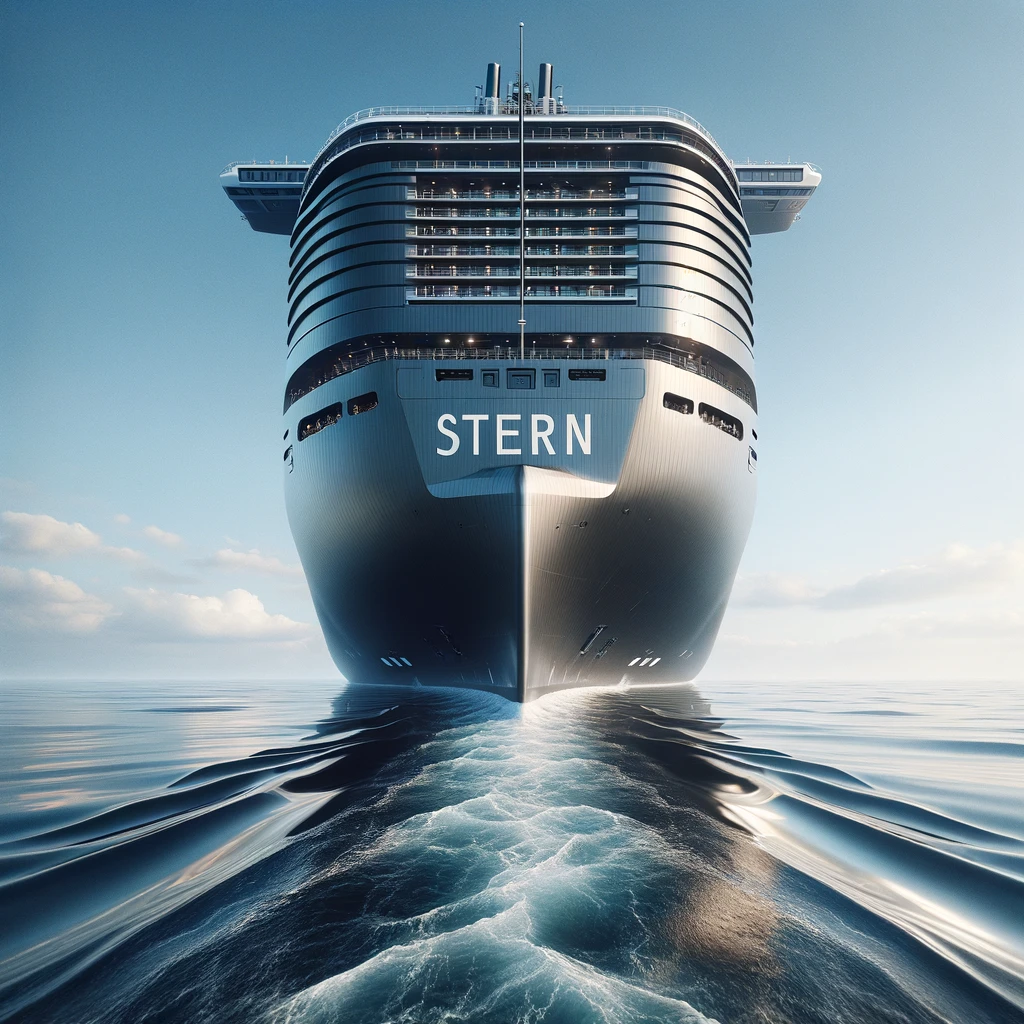
Stern Ship Design: Innovations and Modern Applications
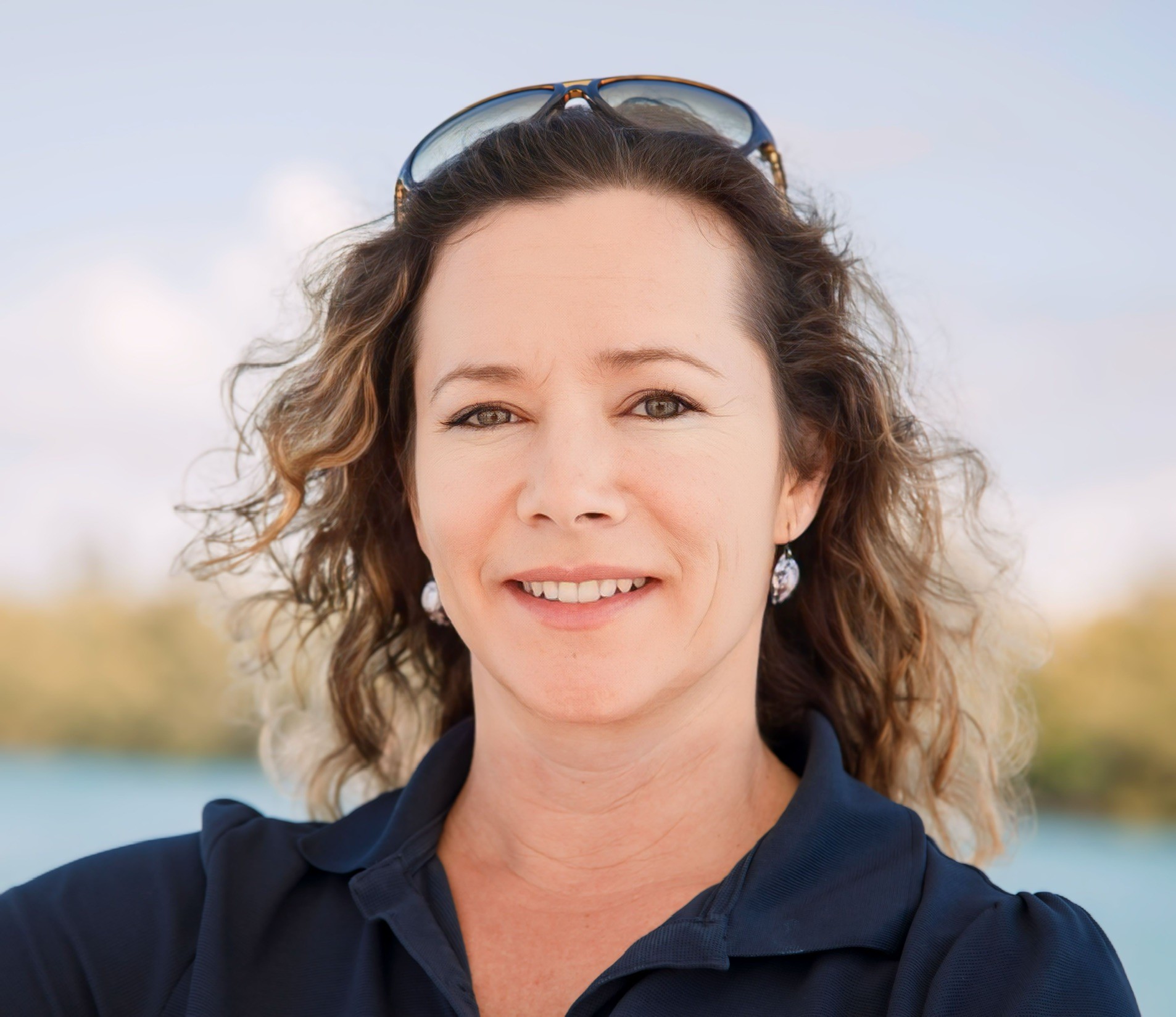
Rightboat Appoint Josie Tucci as VP of Marketing & GM for North America

African Pompano: The Ultimate Guide to This Exotic Fish

Top 10 Boat Trailers for Sale: Best Options and Features

Marina 27 Lake Lotawana Complete Guide: Essential Tips and Information

Which of These Causes the Most Boating Collisions? Top Factors Explained

How Much Do Sailboats Cost? A Comprehensive Guide

Catamaran vs Yacht

When getting into sailing, there are so many types of boats you can choose from—pontoons, tritoons, catamarans, yachts, sailboats, fishing boats, deck boats—and all of them have different advantages and disadvantages when getting out into the water. But when it comes to a catamaran or a yacht, which is better, and what are the costs to calling one your own?
Table of Contents
What is a catamaran?
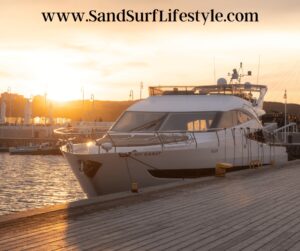
Catamarans come from the peoples of the Indian and Pacific Oceans, who used this form of boat to expand from island to island. The word itself is derived from the Tamil word “kattumaram” which means “logs bound together.”
Because of their construction, they usually have less hull volume, which means they have a shallower draft and a smaller displacement. They are also more hydrodynamic comparatively and require less power than another monohulled boat of the same size. The wide hull of the catamaran also reduces the likelihood that it will heel, or start to roll, in the wind. The wide stance also reduces the wake that the boat gives off.
It is possible to race with catamarans, especially if you are looking for both speed and stability overcapacity. Catamarans built for recreation and sport can be launched and landed from a beach and usually contain a crew of two.
What is a yacht?
A yacht is a blanket term for a boat that uses either sails or power for cruising, racing, or pleasure. While there is no real definition for a yacht, they are typically any sort of boat that has a cabin for overnight use and is a pleasure vessel over 30 feet in length.
There are different sizes of yachts under certain designations—any yacht over 79 feet is considered large, while any yacht over 131 feet is considered a superyacht or megayacht.
The word yacht comes from the Dutch language, which means “hunt.” It started as the name of the fast-sailing ships that the Dutch used to hunt for pirates in the 18th Century. The concept of pleasure boats, though, started early in the world’s history in Egyptian times and only increased in popularity as time went on.
There are several types of propulsion for yachts—sailing, which is when they use sails to catch the air and power. Yachts first started with steam power before turning to the internal combustion engine.
Most yachts, if large enough to accommodate, have a main salon and a forward stateroom in terms of cabins. The larger the yacht, the more rooms it may have.
Catamaran vs. Yacht: Structural Differences
If you are looking for a cruising catamaran, you will need a larger boat than the monohull counterparts. While a monohull can be small, usually around 30 feet, if you want the same sort of carrying capacity out of a catamaran, you will need a boat upwards of 40 feet.
Because of their larger size and width, catamarans will take up more space in your marina, but they are also more spacious than other boats—that width is not put to waste on the deck or underneath.
The double-hulled catamaran also gives more privacy when it comes to the living spaces—the cabins are conveniently separated, keeping the living quarters and sleeping quarters apart on most catamarans.
Looking to purchase a catamaran? Here are the pros and cons of owning one.
Catamaran vs. yacht: performance differences.
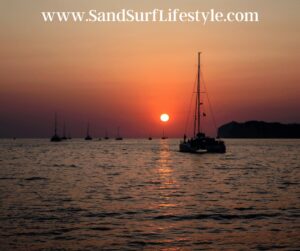
That speed, though, comes at a price—because they have two hulls, you will hear the water slapping against the boat from underneath, which is something you do not get with a monohulled boat.
Because they have two hulls, catamarans are nearly resistant to any sort of heeling, compared to a yacht. They also have extremely high resistance to capsizing, due to their multi-hulled construction. This stability allows for passengers to easily navigate the deck without fear of suffering from wave action. This stability will also let you cook and do any other activities on the deck without fear of displacement.
Catamarans are also easier to handle than another type of boat—one person can singlehandedly sail such a vessel. Because you have two engines and two rudders, it is easier to dock and maneuver compared to a monohulled boat.
Yachts tack much quicker than a catamaran as well—when you turn into the wind so you change which direction the wind blows on the ship—meaning your catamaran will slow down significantly as you turn. A monohull is more maneuverable in the wind.
Catamaran vs. Yacht: Cost Differences
A new, high-quality catamaran larger than 40 feet can run about half a million in cost. Pre-owned catamarans can run as low as $35,000, while larger, new catamarans can exceed $5 million.
Catamarans will also cost more because of the need for two engines and two rudders. The double hull means more equipment, which therefore increases the price. They also use different types of materials, making that cost increase. They also are typically higher quality construction and are safer and easy to sail, pushing the price higher. Because of this equipment increase, your service costs will also be higher.
If you are looking for a smaller yacht, those would put you within the 50 to 70 feet range. Choices also include the engine and optional equipment, along with whether you intend to purchase a new or a pre-owned yacht. New yachts in this size range can run about
Pre-owned yachts of this size can run anywhere between $300,000 for a smaller model to almost $6 million for a larger one. Most around 50 feet are an average of $375,000.
Catamaran vs. Yacht: Which is better?
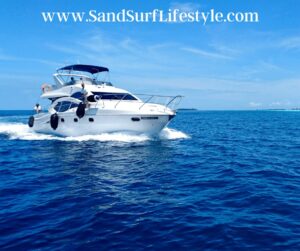
If you want to stay with the traditional sailing experience with more feedback about how your ship is moving, along with keeping a smaller footprint both on the water and in the marina, a yacht is the way to go. They are much more maneuverable than a catamaran in the water. Yachts are also cheaper than a catamaran.
Regardless of what you’re looking for in a boat, the choice remains with you about what you value most in your travels. Whether it’s a catamaran, a yacht, or something entirely different, know what you are looking for in your vessel before going out and looking to buy.
Please note: This blog post is for educational purposes only and does not constitute legal or medical advice. Please consult a legal expert or medical professional to address your specific needs.
Aloha! My name is Shawn and I Love the Beach and Ocean! From surfing to beach sports to boating and fishing I like it all. More importantly, I Love the people I get to meet who also share a passion for the sand and surf. Living and growing up near the ocean my heart has always been connected to the beach and its lifestyle. I wish to share my experience with those around the world. Mahalo (Thank You) for visiting and enjoy your stay here on my site!
Recent Posts
Adaptive Surfing: Overcoming Challenges and Inspiring Stories
Adaptive surfing has truly opened my eyes to the power of resilience and determination. The sport's inclusive nature has broadened my perspective and highlighted how adaptive surfers face and...
Spotlight on Surfing Destinations: Hawaii Edition
Exploring Hawaii's Surfing ParadiseSurfing in Hawaii has been a dream come true for me, as it's where I've discovered some of the most incredible waves and surfing cultures in the world. In this...

Trimaran VS Catamaran – Which Boat Is Best?
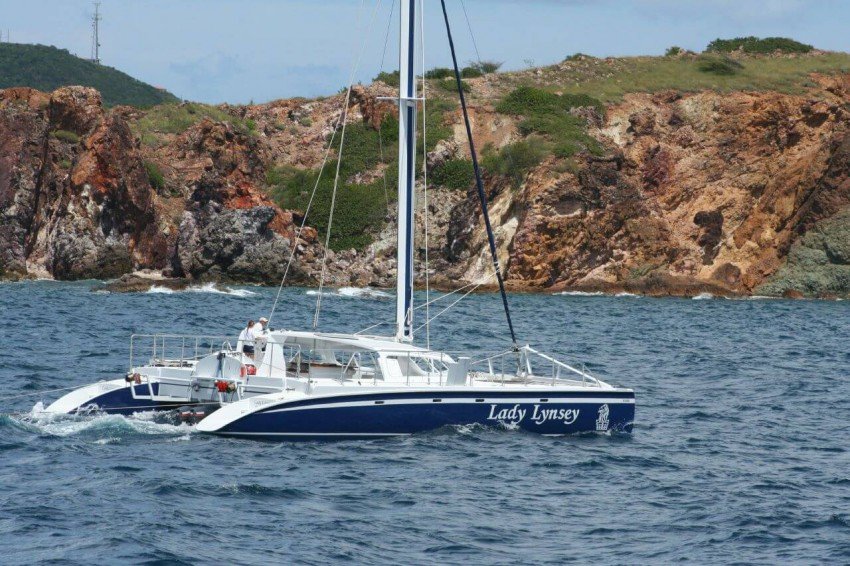
If you’re planning to buy or charter a multihull boat, you might be wondering which one is better: trimaran or catamaran. Both have their pros and cons, and the decision ultimately depends on your needs and preferences. In this article, I’ll explain the differences between these two types of vessels to help you make the best choice for your needs.
Post updated: 10 November 2023
Table of Contents
Differences Between Trimarans and Catamarans?
If you’re in the market for a new vessel or plan a family vacation on the water, you might wonder what the differences are between a catamaran and a trimaran.
Let’s see what they are:
A catamaran is a multihull vessel with two or twin hulls that are parallel to each other and fixed to a wide beam.
This design offers stability and speed, making it a popular choice for cruising long distances comfortably and even racing.
They also provide more interior space than trimarans, allowing for larger cabins and more storage.
When it comes to sailing performance, catamarans are known for their speed and agility.
Their twin hulls allow them to easily glide over the water, making them popular among boaters.
Cats are stable, fast, spacious, and super comfortable and are more stable at anchor than trimarans. However, catamarans tend to perform better in downwind conditions than in upwind conditions.
A trimaran is a multihull vessel that has three hulls. The two smaller outrigger hulls are attached to the center hull, which is larger and used for most of the boat’s functionality.
This design offers even more stability than a catamaran, making it a great choice for those who want to sail in rough waters safely.
The three-hulled design makes them super stable, and as mentioned above, they can easily handle rough waters. They also have a smaller turning radius, making them easier to maneuver in tight spaces.
Another important thing to know about Trimarans is that they provide a decent degree of livability, but they fall short of catamarans in two regards. First, they heel more than cats, making it difficult to do things like cooking on board. Second, they support much less load than catamarans.
Pros and Cons of Catamarans and Trimarans
Before making a decision whether to sail a catamaran or a trimaran, there are pros and cons you must consider. Let’s see what there are:
- Stability: Catamarans have two hulls, which makes them extremely stable. This means that you are less likely to experience seasickness or feel the boat rocking in rough waters.
- Space: Catamarans have a lot of space both inside and outside the boat. This makes them great for large groups or families who want to spend time together without feeling cramped.
- Speed: While not as fast as trimarans, catamarans are still faster than monohulls . They perform better in downwind conditions than trimarans and are great for long-distance cruising in calm waters.
- Shallow Draft: Catamarans have a shallow draft, which allows them to enter shallow waters and anchor closer to shore.
- Cost: Depending on how well the Catamaran is equipped, it can be more expensive than trimarans. Not always, though.
- Harbor Cost: As catamarans have a very large beam, this means that a berth at the marina will be higher.
- Navigation: Catamarans tend to struggle sailing close to the wind .
- Speed: Trimarans are known for being faster than cats and single-hull boats. They can easily reach high speeds and are great for racing or long-distance cruising.
- Stability: Trimarans are more stable than catamarans due to their three hulls.
- Space: Trimarans are wide, but the interior is less spacious than catamarans.
- Safety: Provide exceptional buoyancy. If a trimaran capsizes, there is almost no chance it will sink.
- Navigation: Trimarans can sail in any weather condition and perform much better upwind than cats.
- Berthing: Trimarans are more difficult to maneuver in harbors, making finding a berth in crowded marinas more challenging.
- Maneuverability: Trimarans require more ability from sailors to beach without difficulty than catamarans.
- Loading: Trimarans struggle to carry as much weight as catamarans.
- Sailing: Trimarans require more effort and work on the deck.
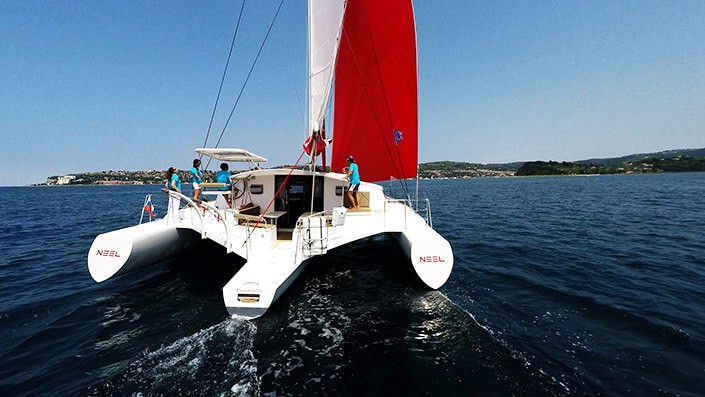
Design and Structure
When it comes to design and structure, there are significant differences between trimarans and catamarans. Below, I’ll walk you through these two multi-hull vessels’ geometry, hydrodynamics, weight, and materials.
Geometry and Hydrodynamics
One of the most significant differences between trimarans and catamarans is their geometry. A trimaran has a central hull with two outriggers connected to a large beam, while a catamaran has two parallel hulls connected by a central platform.
This twin-hull design gives catamarans a unique sense of balance and stability. On the other hand, trimarans offer superior stability and adaptability in various water conditions thanks to their three-hulled design.
The central hull of a trimaran is typically longer and narrower than the hulls of a catamaran, which leads to better hydrodynamic performance.
Both trimarans and catamarans have different hydrodynamic resistance characteristics.
For instance, trimarans have less wetted surface area, which means they experience less drag as they move through the water. This feature makes trimarans faster than catamarans in rough weather conditions and high winds.
Performance and Speed
When it comes to performance and speed, there is a clear winner between trimarans and catamarans . Trimarans are known for their speed and are often faster than catamarans of the same size and weight. This is because of their unique design, which has speed and safety qualities that provide significant advantages over catamarans.
Trimarans have less hydrodynamic resistance than catamarans due to their narrower central hull, which allows them to slice through the water more efficiently in rough seas.
While catamarans are also fast, they often fall short of trimarans in terms of speed and performance. But that’s not always true in downwind conditions because cats are light, and their sails are positioned equivalent to the wind, making them faster than tris in downwind conditions.
Heeling and Capsizing
One of the biggest concerns when it comes to stability is heeling and capsizing. Heeling means the boat leans from one side to one side, while capsizing is when the boat flips over completely.
Both trimarans and catamarans heel, but trimarans provide greater stability and are less likely to capsize due to their three hulls. However, this doesn’t mean a trimaran can’t capsize.
In rough conditions, if a wave gets higher than half the size of the beam, the boat can flip over, but because trimarans have exceptional buoyancy, they float on the surface of the water and can serve as a rescue platform, but they won’t sink!
Comfort and Space
One important factor to consider when choosing between a cat and a tri is comfort and space. So, let’s look at these two types of boat’ accommodation: storage, cockpit, and living quarters.
Accommodation and Storage
One of the main advantages of catamarans over trimarans is the amount of space they offer. Catamarans typically have larger cabins and more storage space than trimarans. This makes them a great choice for longer trips, as you’ll have plenty of room to store all your gear and personal belongings.
Trimarans, on the other hand, have smaller cabins and less storage space. This can make the passengers feel a bit cramped, especially on longer trips.
However, some trimarans do offer creative storage solutions, such as under-bunk storage compartments or overhead storage racks. Note that the latest models of trimarans are extremely spacious and offer as much comfort and space, if not more, than catamarans do.
Another difference between trimarans and catamarans is their weight. While trimarans can potentially be built lighter than some catamarans, catamarans are lighter on average due to having one fewer hull requiring structure and ballast.
The weight distribution of a trimaran is also different from a catamaran, with more weight concentrated in the central hull. This feature provides better stability and performance in rough seas and upwinds.
Catamarans, on the other hand, can support more load than trimarans. This feature makes them ideal for long-distance cruising and liveaboard lifestyles.
Frequently Asked Questions
Q: which has better resale value – trimarans or catamarans.
Resale values for both trimarans and catamarans can depend on factors such as the boat’s age, maintenance, and overall condition. Generally, catamarans have a larger market and may hold their value better due to higher demand, especially among cruisers and charter companies. However, a well-maintained trimaran can still attract buyers who value speed and performance.
Q: Which type of boat is more suitable for long-distance travel: trimaran or catamaran?
Both trimarans and catamarans are fantastic for long-distance travel. Still, catamarans are often preferred among sailors for extended cruising due to their larger living spaces and privacy on board. However, if speed is a critical factor for your journey, a trimaran might be a more attractive option.
Q: What factors should I consider when choosing between a trimaran and a catamaran?
When deciding between a trimaran and a catamaran, some key factors to consider include your intended use, performance expectations, available space, and budget.
You should ask yourself:
- What are your primary sailing goals – speed, comfort, cruising, or racing?
- How much living and storage space do you need for your crew and equipment?
- What kind of stability and performance characteristics do you value most?
- Are you willing to compromise on space or speed for the sake of your preferred multihull design?
Final Words!
So, what’s the best boat? Well, both are great. The choice between a catamaran and a trimaran will depend on your needs and personal preferences. If you are looking for a peaceful trip at a slower pace with plenty of space for the whole group, a catamaran will be your best bet. On the other hand, if you want to zip through the water and get your blood pumping, a trimaran is what you need!
Want More Tips?
Sign up to Cruising Sea newsletter to receive every two weeks the latest post straight to your inbox!
Have you sailed a catamaran or a trimaran? If so, please share your experience in the comments below.

Daniella has been passionate about travel, the sea, and nature for many years. As a child, she frequently traveled throughout the Mediterranean and continued with her journeys throughout her adult life.
Her experiences have created the desire within her to share her love for traveling with other passionate and adventurers who want to discover beautiful horizons and new cultures.
26 thoughts on “Trimaran VS Catamaran – Which Boat Is Best?”
Hey, well I’m definitely the Catamaran girl. I love my space and don’t really need the thrill of the ride as much as I value the relaxation and holiday-type feeling. What’s your personal choice? Well since I’m more the sailor’s wife than the sailor, those other problems don’t really apply to me, do they? hahahaha what’s your personal choice?
We have something in common, because I am not a fan of racing . I love comfort and space, so I would go for a Cat!
Have a great day:)
I would go for the trimaran as it’s more stable in tough conditions as I would like to explore the world, not that I want to race. Catamaran is my go to option if I just want a nice vacation boat or something I agree that that one is better if you don’t want to race. I won’t buy a boat in the near future though, I certainly have not got the money, and I live at the wrong location, not far from the sea but still, I can’t even drive (no license). Great article though and I love boats. Wondered what the difference about these 2 are and now I know.?
Hi Stephanie, Sorry for the late reply. I had a minor technical issue:) Yes, trimarans are extremely stable and are faster than catamarans. However, those beautiful boats are quite expensive and if you plan on sailing around the world, you’ll need a small crew with you to handle the boat:). I am glad this article helped you know what’s the difference between a trimaran and a catamaran. Let me know if you need more info. I am always happy to help. Thank you for the comment and I wish you a lovely day.
This is a very informative comparison of the trimaran vs. catamaran style sailboat. They look similar on the exterior to the untrained eye – but it seems like the differences are pretty dramatic. If someone was looking to charter one for a vacation – do you have a specific experience or preference for one or the other?
It will depend on your personal preferences!
What are your needs? Can you be more precise?
I personally love to sail in comfort, I also need a lot of storage, so a cat is my favorite yacht!
Have a wonderful day:)
I have sailed ON a cat but never sailed one myself. Certainly a wonderful experience unlike a single-hulled vessel that rocks and rolls with the swells. That leads me to ask: if caught in rough weather (large swells and strong winds), how reliable is the trimaran? Does either configuration have limitations in this regard?
For the same size of boat, a trimaran have higher sailing performance ,a better ability to tack and go windward. So to answer to your question, a trimaran will handle better in strong winds and will go faster! But! Bear in mind that no matter if it’s a cat, trimaran, or monohull, the safety will all depend on when the sail will be shortened and how the boat will be handled in bad weather.
I hope it helped and if you have any other question , please feel free to get in touch:)
Have a great day!
Awesome write up on the differences between the two beauties. I have learned something new here. I am more of the adventure like person and your quick analysis of the Trimaran, tells me that I probably would lead to this option when choosing between the two.I will certainly browse around your site to check out other interesting articles you have on offer.Take Care, Roopesh.
Hi Roopesh,
Thank you for the compliment and you are very welcome to stroll around my website.
Take care too and wish you an awesome day!
It’s interesting to see the different opinions shown concerning of a debate. I don’t know about these vessels but I enjoyed reading it.
To me, I’ll go for Trimaran because of the modern interiors. I mean, it’s the modern feel that I’m looking for. That’s my main, personal factor.
Still, overall, I think it’s also suffice to say that these two cannot be compared because it’s not like with like. But that’s just my opinion. Trimaran for the win anyways!
So nice to see you again on my website:)
Yes, the trimaran Neel 45 has a modern look, but not every trimaran. Also, they are much faster than catamarans, sailors usually use them more for racing and catamarans for cruising.
Thank you for the comment, I really appreciate:)
I wish you a wonderful day!
I think now the Neel have brought out the 51 the game has changed somewhat. Lots more room ,walk around bed in master room. Lare shower in main head, the inside outside Cocloon as they now call it. Heaps of space below, fantastic headroom down below in central Hull. Much more classic looking boat on the exterior. Add the speed, stability and affordability compared to similar sized Cats and there really does not appear to be any more to be said. Of course it’s just my opinion and if money was not an option i think the Gunboat 60 would be the final choice, but for around 600k the Neel 51 has definitely set the standard. Take a look https://www.youtube.com/watch?v=1-997AEXfsk
Well, that’s a beautiful trimaran you have here, effectively, this one looks much more comfortable and wider than the Neel 45! I would definitely choose the 51 over the 45! I’ve really enjoyed watching the video, and it would be interesting to write an excellent review on the 51:). I agree with you, the Gunboat is such a beautiful cat, and now it makes it even harder to choose between the two of them:) Thank you for the comment and wish you a wonderful day!
Late arrival here but after reading and watching so many negative reviews about the Neel trimarans and the Neel 45 images of one build showing their train wreck quality, there is absolutely no way you can compare a Gunboat and a Neel. You’d be better off comparing it to the Yugo automobile.
The “Sailing Yacht Ruby Rose” did a recent video review of the newer Neel 47 posted on July 18, 2019 showing very clearly that its build quality is extremely lack luster. Although it was the Neel Trimaran that gave me the sea bug, one probably couldn’t purchase a poorer quality boat at any price. It’s an awesome concept but it’s a manufacturer no individual should consider buying from. I’m hoping one of the premium Cat builders will take on the task of providing a similar concept when I’m ready with my money.
Hello Eso, The beautiful thing in life is that everyone has different taste and opinion. I am glad to have you here and thank you for sharing your experience with the readers, this will certainly be useful to many people. I wish you a fantastic day!
Yes I’ve been looking at the Neel 51, Its turning my attention some what. It would make world cruising just that little bit faster and with room and comfort. PS I like the engine room.
Hi Mercury,
Thank you for the comment! The Neel 51 is a beautiful boat. She is more spacious and comfortable than the 45 Neel, but the 65 is even better! However, the 51 is an ideal cruising trimaran to sail in comfort. She provides everything sailors have ever dreamed of such as speed, stability, space, and luxury. What more to ask for:)
Thank you again for the comment and wish you a wonderful day!
I own a Catana 47 with one owner and two guest cabins. I and my wife want four cabin boat so that We can sail with our two daughters and their family including grand children. Should I buy Catana 53, Outremer 51 or Neel 51?
Thank you for commenting!
I am not a boat seller, but I will be more than happy to answer your question. The Catana 53, Neel 51, and Outremer 51 are fantastic boats. And to be honest, I would personally buy the Neel 51 because she is extremely spacious, lightweight and more stable than any catamaran out there.If you bring children, then you would want the boat to be safe. The other boats are also great but tend to perform less well in strong winds and heavy seas than the Neel 51. So yes, the Neel 51 is unbeatable in all categories! At least to me:)
I hope it helped and, please, feel free to contact me if you need to know further information. I am always happy to assist!
Thank you again for the comment and wish you a lovely day!
It’s really a good Information. I have never been in any one of the rides but I feel personally Cat is better. Do you guys know anything similar to this other then Cat trimaran like Semi-Submersible, drone etc. as I am doing a project that will help you to ride Cat Yourself alone!. Wish me good luck and please help me achieve my goal fastly, by sharing your precious knowledge and time. thank you in advance.
Hi Mohammed,
We would like to help you, but we didn’t really understand your question, could you be more specific, please?
Thank you for the comment!
Hello Daniella, Firstly thank you very much for your kind response. I would like to have some info about the Stability equation of Catamaran and different steering Mechanisms.
You are very welcome!
Please, check out these articles, I am sure you will find all the answers to your questions: file:///C:/Users/gofri/Downloads/6962-1-10720-1-10-20130718.pdf
http://www.sailingcatamarans.com/index.php/faqs/19-sailing-and-performance-questions/109-which-steering-system-should-i-use
I hope it helped! Don’t hesitate to contact me if you need more information, I’ll be more than happy to assist!
Dear Daniela Thankyou very much for your Kind help. Could you please give some Information about the construction guidance of Catamaran. I want to construct my own for my experimental purposes. Thankyou Regards Moulasaheb Md
Hi Mohamed,
I would like to help you, but you are not in the right place for this. If you are looking for sailing holiday, then I’ll be more than happy to help!
If you want to construct your own boat, I highly recommend you to check other websites.
Thank you for the comment and wish you a great day!
Leave a Comment Cancel reply
By using this form you agree with the storage and handling of your data by this website. *
Is a catamaran safer than a yacht?
Sailing enthusiasts often find themselves at the crossroads when choosing between a catamaran and a traditional monohull yacht. While both have their unique set of advantages, the debate on safety is often the most heated. As we set sail on this topic, let’s dive deep into the foundational differences and see which one emerges as the safer option.
Understanding the Core Design
Before jumping into the safety debate, it’s essential to grasp the fundamental designs of both vessels.
Catamarans: The Dual-Hulled Beauty
A catamaran is a watercraft that features two parallel hulls of equal size. This design not only gives catamarans a broad beam but also ensures they sit more on the water surface, rather than in it. Catamarans, due to their design, tend to have more space onboard, often making them a top pick for luxury seekers who’re looking to charter in regions like Italy. With their increasing popularity, a wide range of catamarans are available for charter .

Is A Catamaran Safer Than A Yacht 1
Yachts (Monohulls): The Traditional Elegance
On the other hand, traditional yachts or monohulls have one hull, and they sit deeper in the water, allowing them to slice through waves more effectively. This characteristic often gives them the upper hand in speed, especially when beating upwind.
Stability on Water
One of the most significant points of contention is stability. So, how do both fare in choppy waters?
Catamarans: The Stability Champions
Due to their wide beam and dual-hulled design, catamarans are less prone to heeling (tilting) than their monohull counterparts. This stability ensures that onboard activities can continue even when the sea gets a bit rough, making it a preferred choice for those who’re new to sailing or are prone to seasickness.
Yachts: Keel-Dependent Stability
Yachts rely on their deep keel for stability. While they heel more than catamarans, they are designed to right themselves up after a capsize, a feature catamarans lack. However, it’s worth noting that a modern yacht’s chances of capsizing are minimal.
Safety During Manoeuvres
How do both vessels behave when performing sailing manoeuvres?
Catamarans: A Gentle Glide
Due to their stable design, catamarans offer a smoother experience when tacking or gybing. Their dual engines (one in each hull) provide better maneuverability, especially in tight marinas. For novices, this could translate to fewer errors during critical maneuvers, enhancing safety.
Yachts: Skill-Intensive Manoeuvres
Handling a yacht requires a bit more skill, especially during maneuvers. Their deep keel and single hull mean tacking and gybing can be more intense. However, with experienced hands on deck, yachts can be maneuvered with precision.
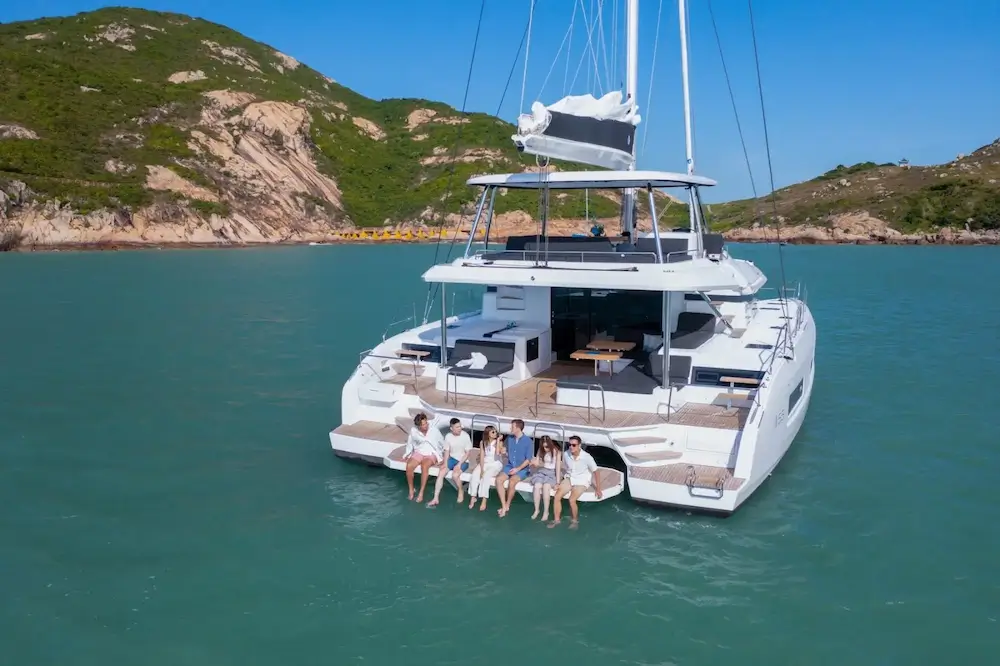
Is A Catamaran Safer Than A Yacht 2
Space and Comfort: A Safety Perspective
Space isn’t just about luxury; it’s also about safety. How do sailors benefit from the design in terms of space?
Catamarans: Spacious & Open
Catamarans are often lauded for their ample deck space. The wide beam ensures that interior spaces are expansive, making movement easier and less restrictive. Moreover, sleeping quarters in catamarans are often located away from the central area, offering more privacy. Those curious about the sleeping arrangements on a catamaran can dive into this comprehensive guide .
Yachts: Compact & Cozy
While yachts might not boast the spacious decks of catamarans, they offer a cozy and intimate setting. The interiors are more compact, which means everything is within arm’s reach, a benefit during rough seas where movement should be minimized.
Performance, Cost, and Draft: The Underlying Safety Aspects
Beyond the obvious design differences, a vessel’s performance, cost, and draft play essential roles in determining safety. Let’s explore these factors for both catamarans and yachts.
Navigating Through the Waves
When sailing in rough seas, the way a vessel interacts with waves can determine its safety.
Catamarans: Riding Over the Waves
Catamarans, with their broad beam, tend to float atop the waves rather than cutting through them. This can offer a smoother experience in light to moderate conditions. However, in stormy weather, this very trait can be a disadvantage, making the boat more susceptible to wave action.
Yachts: Cutting Through with Grace
The monohull design of yachts allows them to slice through waves. In heavy seas, yachts can offer a more predictable ride, ensuring that they can handle stormy conditions better.
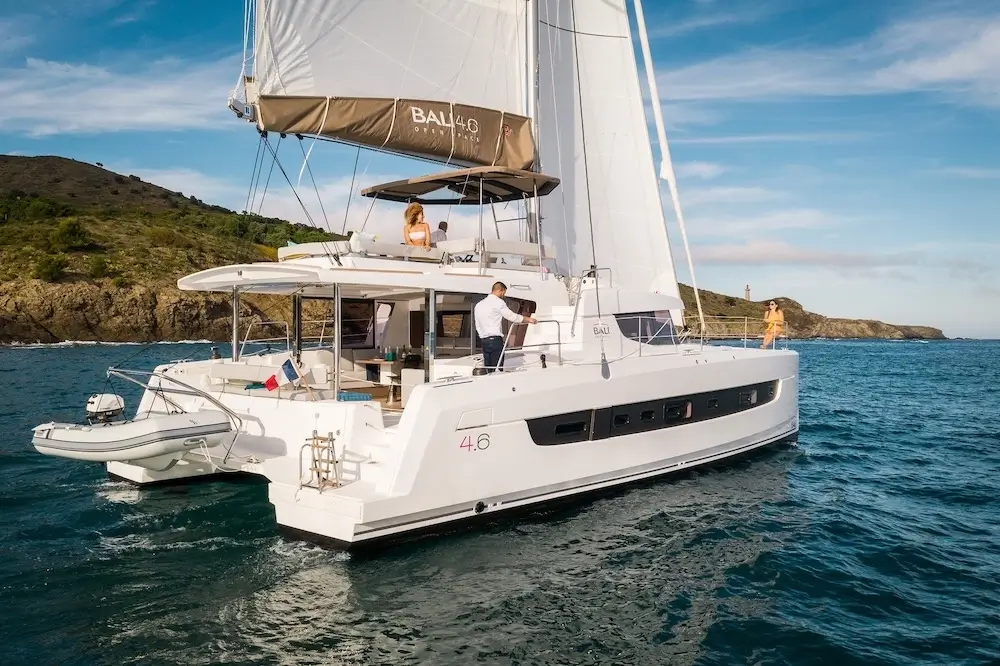
Is A Catamaran Safer Than A Yacht 3
Economic Implications: Maintenance and Cost
The safety of a vessel is directly related to its maintenance. And, often, the cost of upkeep plays a significant role in ensuring routine checks.
Catamarans: Pocket-Friendly Maintenance
Given their increasing popularity, catamarans have seen a surge in production, leading to competitive pricing for parts and maintenance. Their twin-engine setup can be advantageous. If one engine fails, the other can be used, adding an extra layer of safety during voyages.

Yachts: Steeper Costs, But Worth the Price?
Yachts, with their long-standing history, have a well-established maintenance protocol. While their upkeep might be costlier than catamarans, their robust build ensures longevity, justifying the investment.
Draft Considerations: Accessing Secluded Areas
The draft of a vessel determines how close it can get to shorelines or navigate shallow waters.
Catamarans: Shallow Draft Advantages
Catamarans have a shallow draft, which allows them to approach beaches closely and anchor in shallower waters. This trait is especially beneficial when exploring secluded areas or when seeking shelter near the shore during adverse weather.
Yachts: Deep Drafts for Deep Waters
Yachts, with their deeper drafts, are better suited for open waters. While this means they might not access shallow regions as catamarans do, their design ensures better stability in deeper, rougher seas.

Is A Catamaran Safer Than A Yacht 4
Safety Equipment and Amenities
No debate on safety is complete without considering the equipment and amenities on board.
Catamarans: A Modern Touch
Modern catamarans are equipped with the latest safety equipment. Their spacious design also allows for easy storage and access to safety gear. Additionally, amenities like multiple restrooms, vast lounging areas, and more prominent galley spaces contribute to comfort, indirectly enhancing safety by reducing fatigue.
Yachts: Classic Yet Contemporary
Yachts, being the age-old favorites, come equipped with tried and tested safety gear. Their design ensures that equipment is within arm’s reach, crucial during emergencies.
Making an Informed Choice: The Final Verdict on Safety
In the debate between catamarans and yachts, one might wonder if there’s a clear winner in terms of safety. Each vessel brings a unique set of attributes to the table. It’s essential to weigh these attributes against personal preferences, sailing conditions, and the purpose of the voyage.
The Stability Aspect Revisited
We discussed how catamarans, with their dual-hull design, offer incredible stability in calm to moderately rough seas. This stability can significantly reduce seasickness and ensure a comfortable voyage for those on board. However, in extreme weather conditions, this same stability can be a vulnerability. Yachts, on the other hand, might heel more, but their ability to right themselves offers a different kind of safety net.
Size and Space Matters
Catamarans: a roomier option.
One of the significant advantages of catamarans is their spaciousness. This feature isn’t just about luxury. A spacious deck and interiors allow for easier movement, reducing the chances of accidents on board. The ample space also ensures better ventilation, enhancing the overall experience. And, if you’re wondering where to relax during your voyage, here’s a guide on the sleeping options available on a catamaran.
Yachts: Compact but Efficient
Yachts might not offer the same amount of space as catamarans, but their design is streamlined and efficient. Every nook and corner is designed with a purpose, ensuring that sailors have everything they need within arm’s reach.
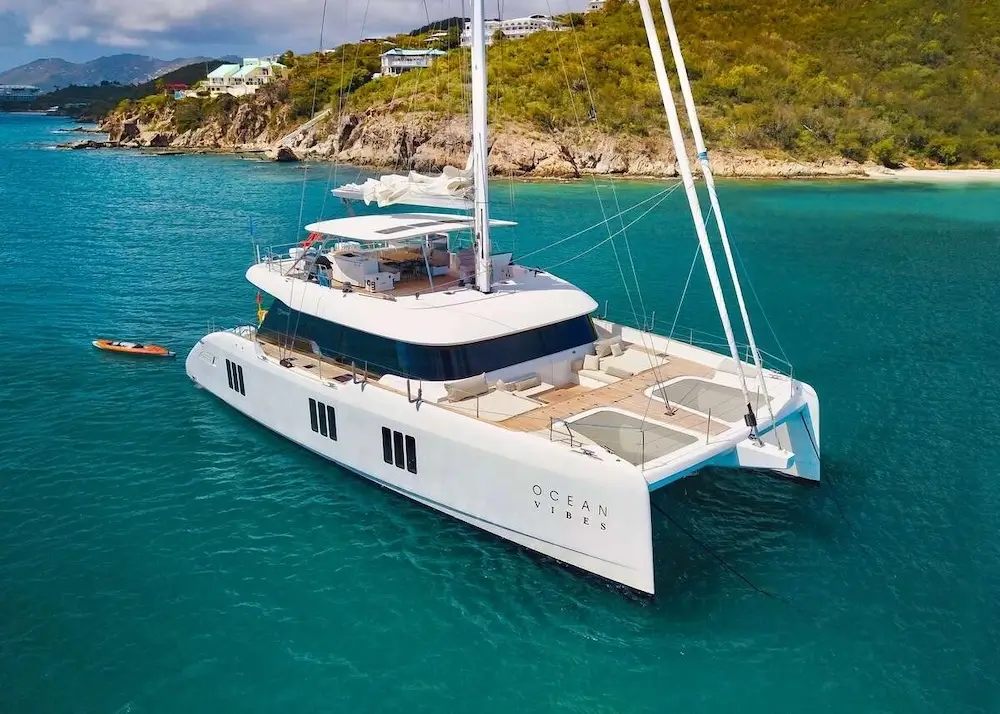
Is A Catamaran Safer Than A Yacht 5
Consider the Crew and Your Expertise
No matter the vessel, safety is often determined by the crew’s expertise and the decisions they make. A well-trained crew can handle emergencies efficiently, regardless of whether they are on a catamaran or yacht. Similarly, if you’re sailing yourself, your experience and judgment play a crucial role in ensuring safety.
What’s the Verdict?
So, is a catamaran safer than a yacht? The answer isn’t black and white. Both vessels have their advantages and challenges. It boils down to personal preferences, the nature of the journey, and the conditions you expect to encounter. Before making a choice, it’s worth exploring the options available, like the diverse fleet offered by Catamaran Charter Italy .
Choosing between a catamaran and a yacht is a personal decision, influenced by various factors. While catamarans offer stability and space, yachts bring with them a legacy of tested safety in diverse conditions. Ultimately, the safety of any vessel is a combination of its design, maintenance, the crew’s expertise, and the decisions made during the voyage. As the saying goes, “A smooth sea never made a skilled sailor.” Regardless of your choice, respecting the sea and understanding your vessel will ensure a safe and memorable sailing experience.
Related Posts
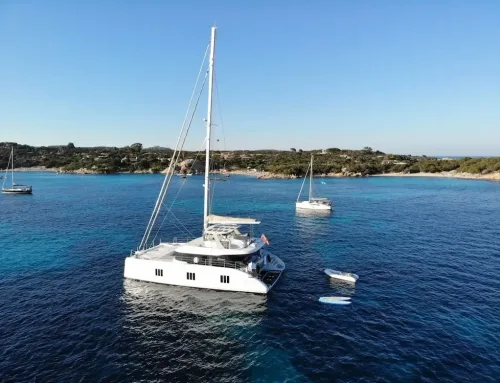
How do I plan a sailing route in Italy?

What are the sailing conditions like in Italy?

What is the cancellation policy for catamaran rentals in Italy?
Yachting World
- Digital Edition

Best catamaran and multihull: We sail the very best yachts on two and three hulls
- Toby Hodges
- March 20, 2024
Toby Hodges takes a look at all the nominees and the winner of the best catamaran and multihull category in the much-anticipated European Yacht of the Year Awards
There are many categories in the European Yacht of the Year awards, from the best luxury yachts and performance yachts to the best yachts for families and event a best specialist yacht category. But with multihulls rapidly increasing in popularity, the best catamaran and multihull category was possibly the most hotly anticipated.
The small number of entrants in this category in no way reflects the rich range or huge demand for multihulls. Many new models were launched by the big yards in the preceding years and they’re struggling to keep up with bulging order books.
However, these three shortlisted represented a choice pick of the latest fast cruisers and each, in their own very different ways, are responding to this insatiable demand for high end space and pace cruising.
Best catamaran and multihull
Best catamaran and multihull winner 2024 – outremer 52.
My highlight test of 2023? Sailing this Outremer 52 for 200 miles over two days and nights! Quite how such a large vessel, one that is capable of doing laps of the planet in true comfort, is also capable of providing such enjoyable sailing is the secret sauce that helps scoop this prize.
And it was pushed hard for this award by the disruptive HH. But the Outremer is such a well rounded, measured and thought out yacht for bluewater cruising at a reliable speed – it’s the full package, a dream boat for family bluewater sailing and arguably the French yard’s best and most refined model to date.
Designer VPLP was tasked with replacing the popular and well proven 51 with more comfort and stowage, while maintaining the performance. It says it took the best of the 55 (which won this award two years ago), and the best of the 51’s deck plan to create this 52. The result means too many good features to point out here, from the variety of helm positions, including a completely protected position inboard using the swing pedestal, to the well conceived spaces. I’d therefore recommend reading our full test report online or in YW’s June 2023 issue!
Neel continues to enjoy its cruising trimaran niche, using the wow factor of bridgedeck accommodation combined with the type of sailing enjoyment and feedback monohull sailors appreciate.
The impressive lightwind performance and direct feel of a Neel I am used to. But I don’t think I’ve ever been so surprised by the amount of cabins or space as I was on this 52. It’s available with four to six cabins plus the option for two crew cabins aft! Some of this maze works well, other areas, such as the forward cabins in the main hull not quite so well. Horizon and rig sightlines and some finishing also leaves room for improvement.
The HH44 seemingly manages to achieve the space and pace balance in a compact 45ft package, while also being one of the most innovative and exciting new production yachts I have sailed. From its looks to layout, to practical on deck solutions such as swing pedestals, side gates through the bulwarks and transom gates that double as swim platforms and boost cockpit security, it’s packed with fresh thinking.
And on the subject of ‘fresh’, the natural ventilation encouraged into the yacht through those massive forward facing coachroof windows which open – a feat made possible thanks to a stiff carbon composite structure – negates any aircon requirements.
With its deep carbon boards and tall carbon rig the HH44 is a powerful, reactive animal to sail. However, it’s the incorporation of the first parallel hybrid electric drive units which really makes this high tech high performance cat stand out. The electric motors are attached to the aft end of conventional diesel engines, not only providing silent power, but renewable energy through regenerative drives while sailing.
Best catamaran and multihull 2023
Best catamaran winner – nautitech 44.
If the very best catamaran delivers the ideal comfort to performance compromise, here’s a catamaran that seems to strike the perfect balance.
For those who cite a lack of visibility and protection as reasons not to choose this aft helm route, try sailing this first – direct steering brings so much more helming pleasure that you get the enjoyable feeling and communication more associated with a monohull. The attention to keeping weight low and central, vacuum infused vinylester build and a low coachroof and boom all aid this performance. The fine entry Lombard-designed hulls allowed us to properly point upwind at 8 knots (in 13), but it was the hands-on steering sensation that really stayed with me.
While there’s no real inside/outside boundary – the saloon bridges both – the Chedal-Anglay interior design works well. It is not as voluminous as some, but is certainly enough to be smugly comfortable at anchor, finished to a good quality, with walnut Alpi trim as standard. The layout option for a ‘smart room’ office/laundry/bunk room or stowage cabin is indeed really smart.
Out of all the multihulls nominated or sailed last year, this cat impressed me the most under sail. It’s the ideal size to go distance sailing, with good performance, low draught and space for family and friends. It had me dreaming.
Balance 482
I was drawn to the Balance 482, thanks to the combination of good looking modern design, high average speeds and, chiefly, the profusion of clever thinking and practical ideas that it brings. The South African build uses a foam core with E-glass laminate and cored furniture for a light weight of 11.3 tonnes, but also with the ability to take a generous payload.
An electric furler option combined with screecher sail helps offer effortless handling and fun sailing, although the 482 prefers a breeze in the double figures. Smart options such as load cells on the rigging, a bowsprit camera to monitor the anchor chain, plus engine room and mast cams all help for maintaining vigilance. Other features we like include the solar panels properly installed on raised brackets, raincatchers built into the coachroof, and how all sheets and lines are led to the helm station. But the prize solution is the VersaHelm, which allows you to swing the wheel inboard, close off the helm station, and stand watch and steer from a fully protected position.
Catana Ocean Class
The Catana Ocean Class is a bulky model which is geared more towards creature comforts than the higher performance of its predecessors. That said, it uses carbon in the structure and roof, foam cored furniture, the tanks are mounted low in the hulls and it has daggerboards and fine entry bows. The weight savings help it offer a massive 5.5 tonne cruising payload, plus there’s capacious stowage and large tank, refrigeration and laundry capacity.
Positioned between Lagoon and Outremer, the Catana echoes a bit of its sister brand Bali’s concept with its internal cockpit-cum-saloon layout while providing good ventilation via large sliding doors and opening windows. We liked how it’s easy to handle solo from one helm station, including the electric remote control of the boards, plus the layout of the galley and navstation.
Those chasing speed and helming pleasure should perhaps look to the C-Cat 48, as it’s as close to helming a fast monohull as a cruising cat is likely to get and one of the rare times we enjoyed sailing upwind in light breezes on a multihull! This is largely thanks to a lightweight, stiff build – the Comar yard has managed to save 1.7 tonnes over the first boat (9.5 tonnes light) and increased the draught of the curved daggerboards to 2.95m.
A carbon roof and rig comes as standard, as well as an epoxy hull, full carbon deck, bulkheads and compression beam. It is a little quirky with comparatively small volumes, but this François Perus design will outperform most other performance cats and monohulls of a similar length.
The Excess 14 shares that direct sensation you get from aft helms and some of the performance of the C-Cat, but in a more balanced, voluminous layout for cruising. The Excess 14 benefits from the research of VPLP’s Vannes racing office, where attention was focused on weight reduction, with savings particularly in furniture, on improved stiffness (PET foam cored sandwich for main structural bulkheads), and the efficiency of deeper fixed keels.
The result is telling on the water, as it should be for any best catamaran contender, where you can log easy miles: we clocked late 7s upwind, reached in the late 8s and regularly averaged 9 knots with gennaker in 12-15 knots. Clear glass windows give acceptable visibility from the helms through the coachroof and the comparatively minimalist interior. In short it offers a good mix of volume, reasonable performance and enjoyable sailing – see our full review last month.
Sailing performance was another key facet in the battle of the big cats from the big cat yards, Lagoon and Fountaine Pajot. Both models offer luxurious amounts of space for home from home comfort, as watersports bases for long term cruising.
The decision to push the mast to the front of the coachroof to allow for a larger genoa than its recent preference for self-tacking jibs has paid off on the Lagoon 51. It helped us sail efficiently into the waves (albeit not pointing too high) before clocking double figures reaching with the code sail in 15 knots.
The Lagoon’s large flybridge with dual access is a USP at this size that will be a hit or miss deal breaker for many. The 51 offers unrivalled accommodation volume in three, four or six cabins, and relaxation zones, and good circulation through these big spaces. Once again the jury applauds Lagoon for thoroughly testing the prototype model during a six month tour. Over 100 have already sold.
We saw in our December issue how the experienced owners of the Fountaine Pajot test boat choose to live and work full time aboard their Aura 51. It’s a design that promotes space, enough to take friends, family and crucially for them, all the toys to enjoy at anchor. Its capability of averaging 8-10 knots also appeals, although the single side helm and hydraulic steering result in scant connection to the sailing in light winds (the same applies to the Lagoon).
The fact the yard already offers this in a hybrid version and has an electric and hydrogen model in the pipeline could sway some, but the decision between the FP and the Lagoon will likely come down to preference between a central flybridge or offset bulkhead helm together with interior design and layout.
If you enjoyed this….
Yachting World is the world’s leading magazine for bluewater cruisers and offshore sailors. Every month we have inspirational adventures and practical features to help you realise your sailing dreams. Build your knowledge with a subscription delivered to your door. See our latest offers and save at least 30% off the cover price.

Catamaran VS Sailboat, 9 Important Differences You Should Know!
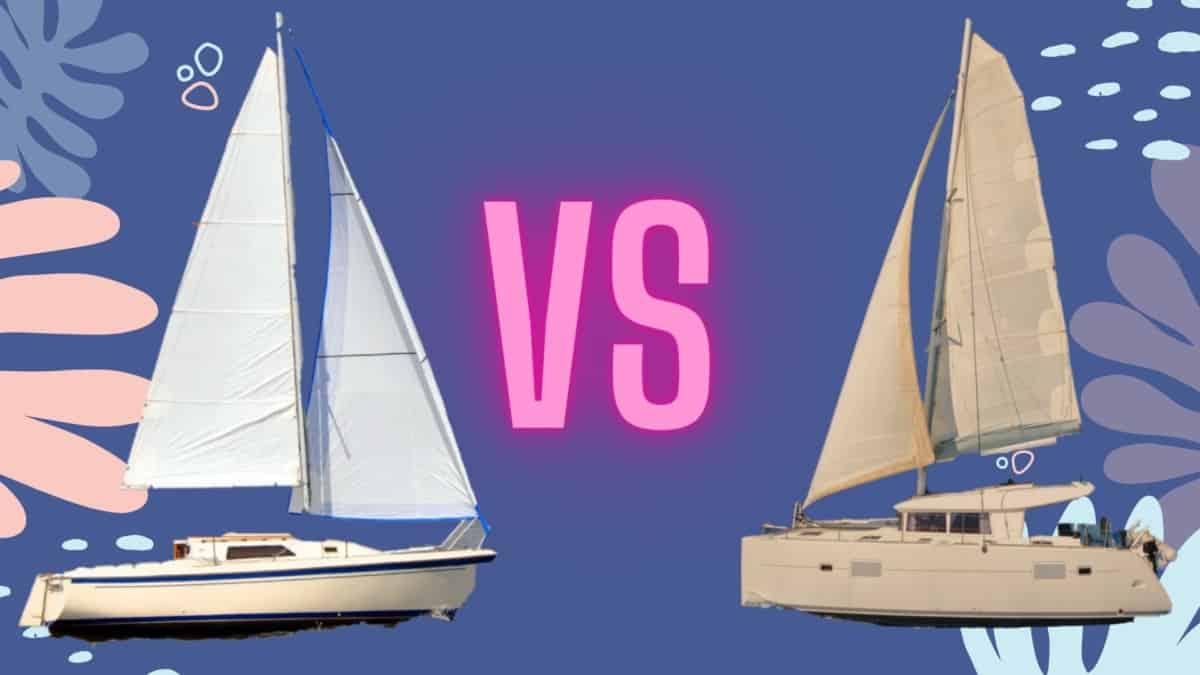
As an Amazon Associate, we earn from qualifying purchases. We may also earn commissions if you purchase products from other retailers after clicking on a link from our site.
This is one of the never-ending questions out there, catamarans vs. monohulls (also known by some just as sailboats). The discussions are wild and are, many times, really hard to follow unless you’re already a vivid sailor. By then, you probably already have your own opinion on what the differences are.
In this post, I’m trying to take a little more pragmatic approach to describe the 9 most important differences that I think you should know about.
Table of Contents
1. Catamarans Have Two Hulls, Sailboats or Monohulls Have One
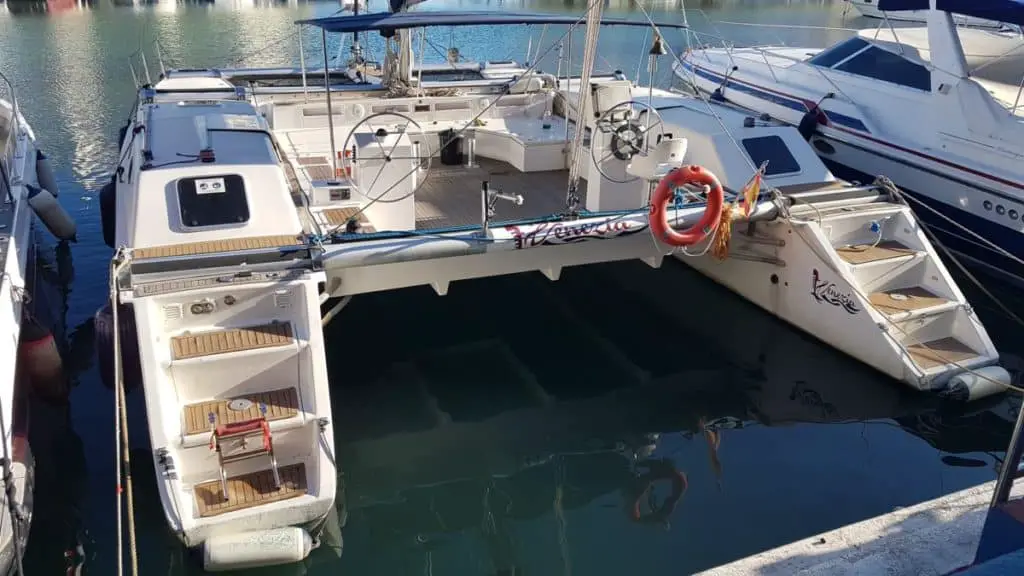
This is the most apparent feature that strikes you when you look at the two boats next to each other; one has two hulls, and the other only one. Mono, as you might know, means one (1).
Having two hulls also implies you need something that connects them, making the boat look a little bit like a manta ray, or is that only me?
2. Monohulls Will Rock From Side to Side
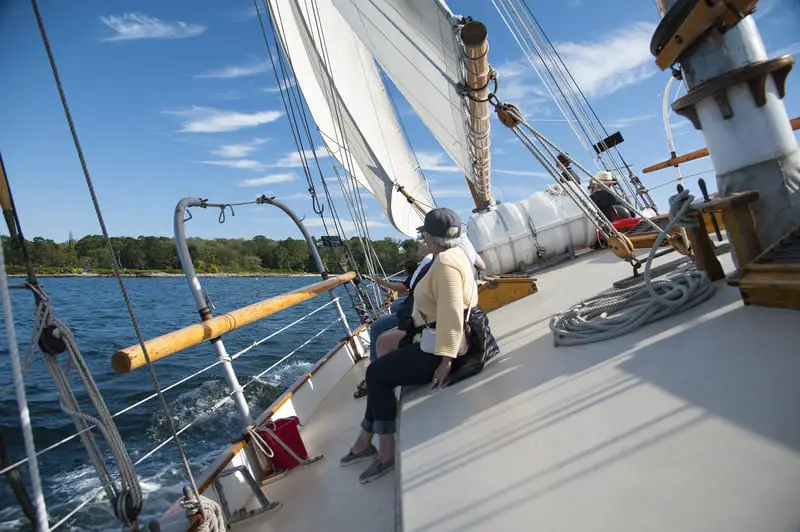
Catamarans don’t heel (leaning to its side in boat language). Therefore, they offer a very different sailing experience, which is more stable and usually more comfortable; this also applies when staying at anchor. The catamaran will move around with the wind, always staying flat, while the sailboat will rock from side to side and might even get you seasick .
This is especially noticeable when the wind is opposing the waves, making the boat have the wind pushing it from one side and the waves banging it from the other side. This makes for a very uncomfortable anchorage on a monohull. Basically, you are the iron, and the wind and wave are your hammer and anvil, not a perfect place to be.
3. Catamarans Offer More Space for the Same Length
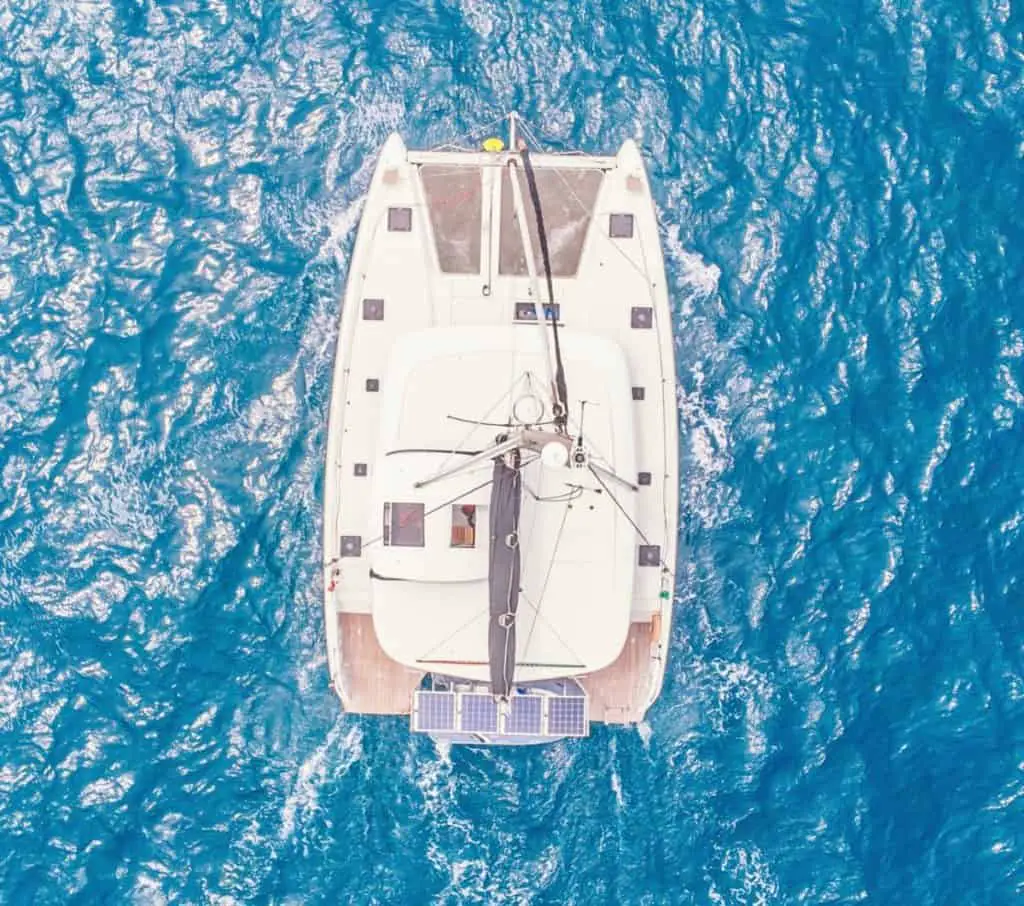
For the same length of boat, let’s say 40ft, you’re getting a lot more space on a catamaran. This is due to the two hulls, but also the big deck that attaches the hulls. There will also be even more space on the outside of the boat, both fore and aft of the mast. In between the bows, you will have either a solid deck or trampolines , which will greatly increase the space.
4. Catamarans Make Horrible Noises While Sailing Upwind
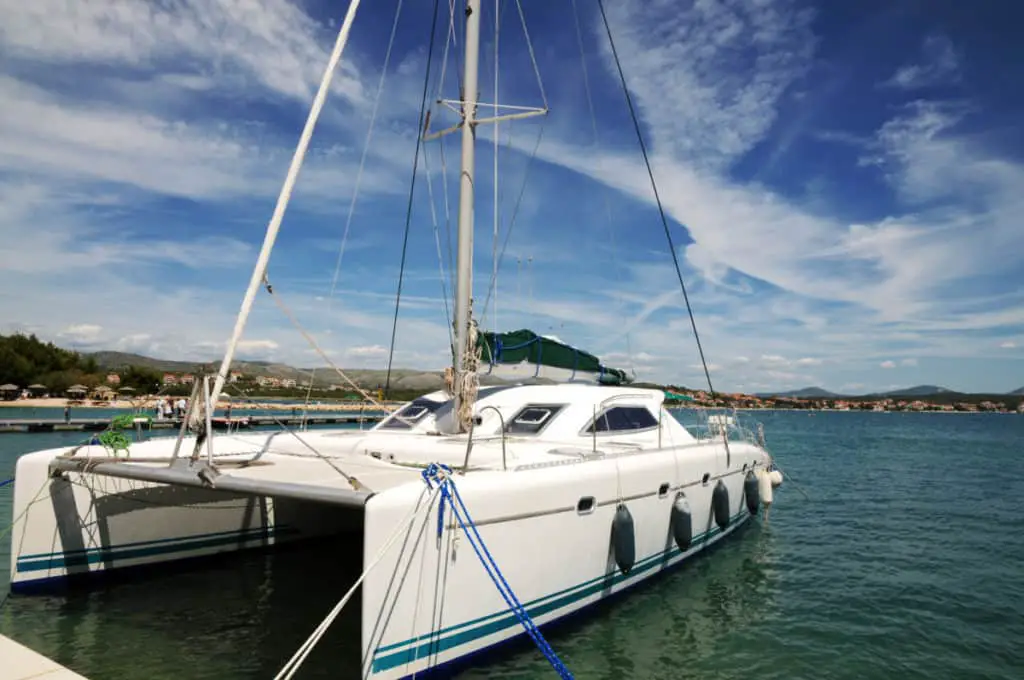
The distance between the water surface and the deck’s underside is called bridge deck clearance ; if it is not big enough, even small waves will start smashing into the underside.
This repeated cycle of waves hitting the boat does induce not only great noise but also a lot of vibrations and discomfort to the crew.
This problem is something that just doesn’t exist on monohulls (only one hull) and also is a strong argument from those who prefer monohulls.
The noise might not be a big deal when traveling coastal waters for a few hours a day, but consider going days on end straight into the wind, hearing that banging noise, ad a little motion sickness, and you will pretty soon wish you were on a monohull 🙂
5. Monohulls Are Slower Than Catamarans
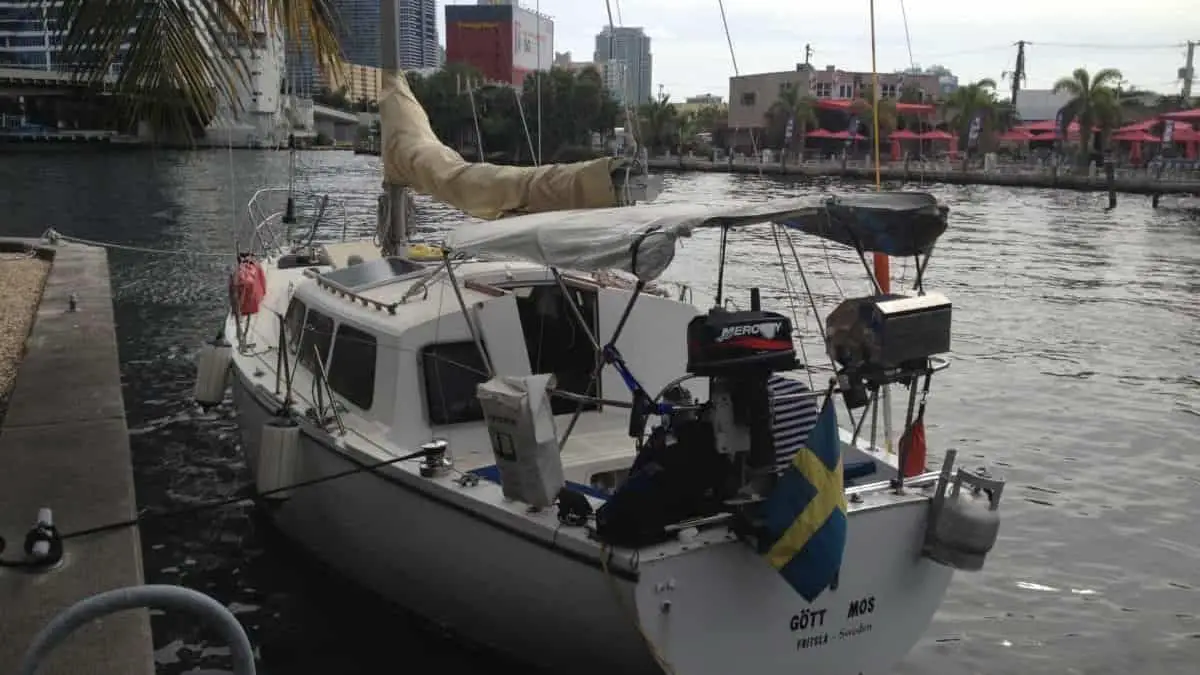
At least that is the short answer, this applies if we only compare the length of the boat, but if we compare the total length in the water, it’s a different story. Much of this speed comes from the decreased drag, bigger sails, and a catamaran’s lesser weight.
Here are some articles when you want to better understand catamaran speed:
- Cruising catamaran speed
- Fastest cruising catamarans
- Catamaran hull speed calculator
- Are trimarans even faster than catamarans?
- 20 Performance cruising catamarans
6. Catamarans Offer Less Helm Feedback
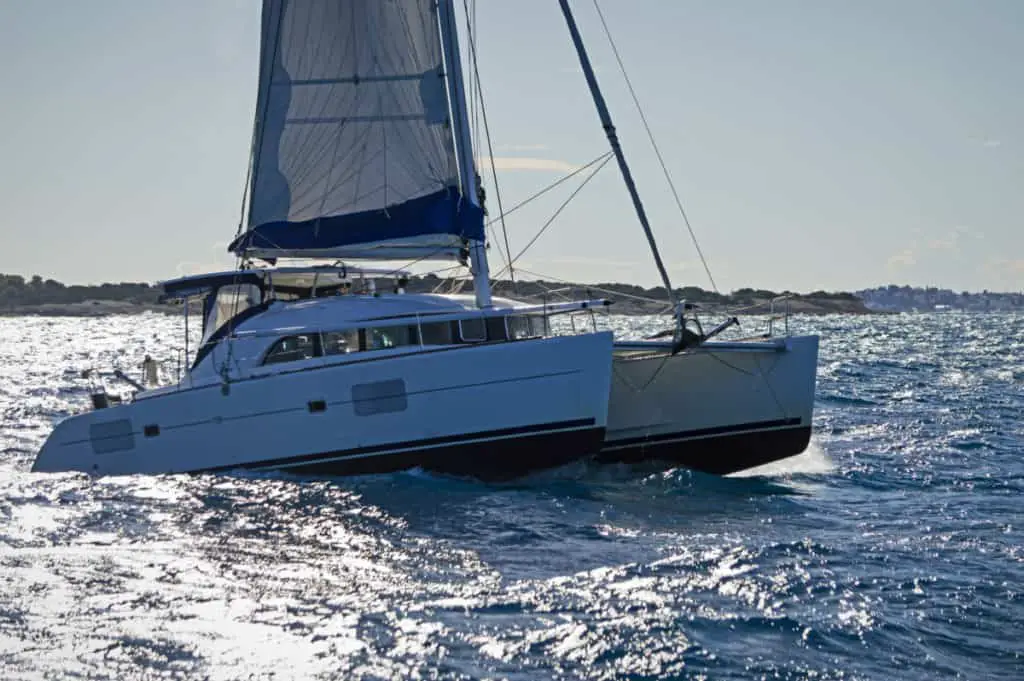
One big benefit of having a boat that heels is that it’s a great way to get feedback on whether or not the boat is overpowered. Since a catamaran stays flat, it is harder for a new captain to understand when to reef.
This could be a safety issue for those transitioning from monohulls to catamarans, which I believe is the most common way people acquire a catamaran.
7. Monohulls Are Harder to Dock
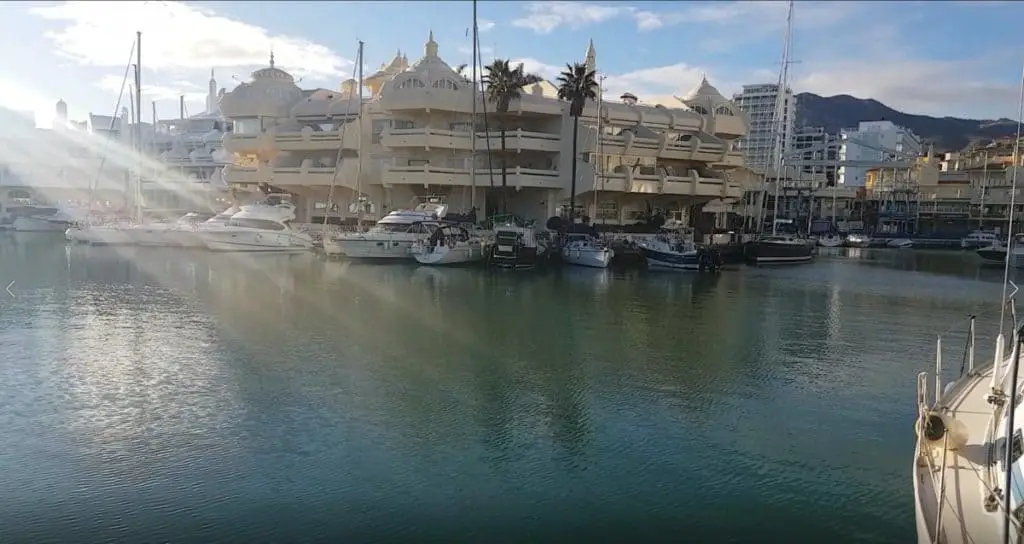
For a monohull to turn, it needs enough water passing around the rudder; for enough water to pass around the rudder, the boat needs to be moving. So this means once you stop your boat, you can’t turn; the things that move you are the wind and the current. This is the tricky part with a monohull, the timing needs to be perfect, or you’ll either go too fast and hit the dock, or you’ll go too slow and drift away.
On a catamaran, that’s different, you see; now you have two engines, much like a battle tank, you can now make a 360 turn on the spot. This means you can do a full stop, put one engine in forward and one in reverse, making the boat spin on its axis. That’s great! I wish my car would do that.
8. Catamarans Are More Fuel-Efficient
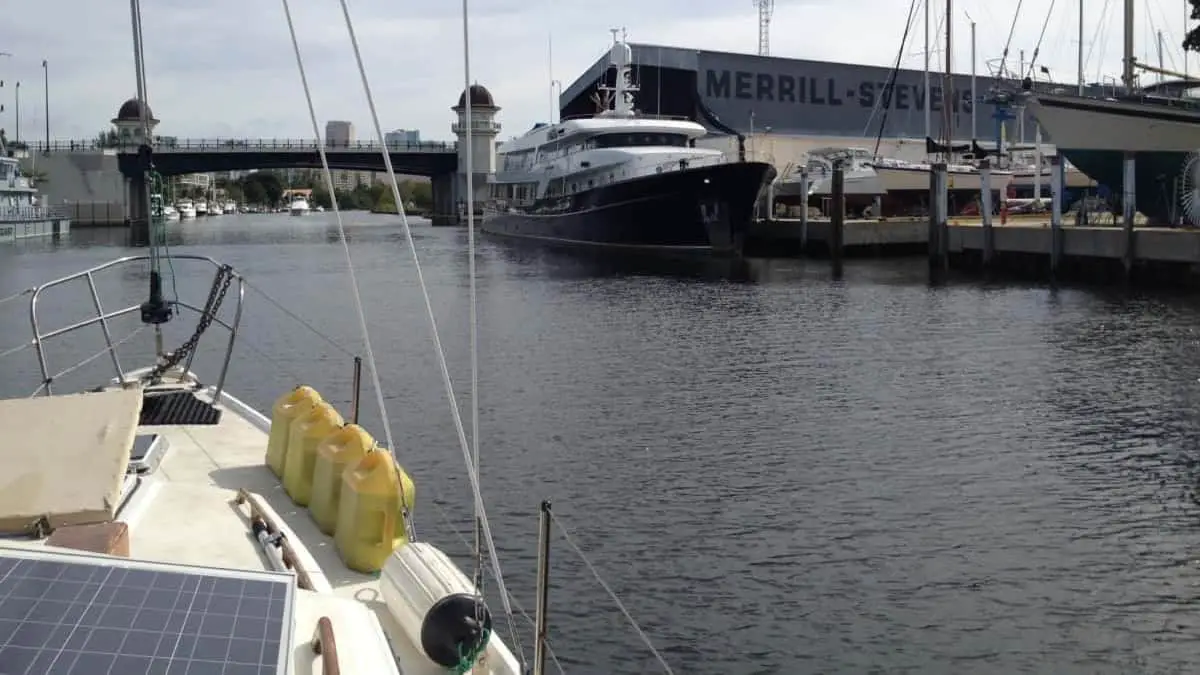
Saying a catamaran is fuel-efficient is like saying your Ford F150 truck is fuel-efficient. But, in comparison to its one-hull brother, it’s true, this really needs a lot more explanation for it to be a fair comparison, but only considering the lengths of the boat, the catamaran will consume less fuel.
This is mostly a consequence of the less drag a catamaran has since the weight is distributed over a greater area.
- Catamaran fuel efficiency data contributed by owners
- Electric vs gas: outboard engines. Which is the best?
9. Catamarans Offer More Comfort
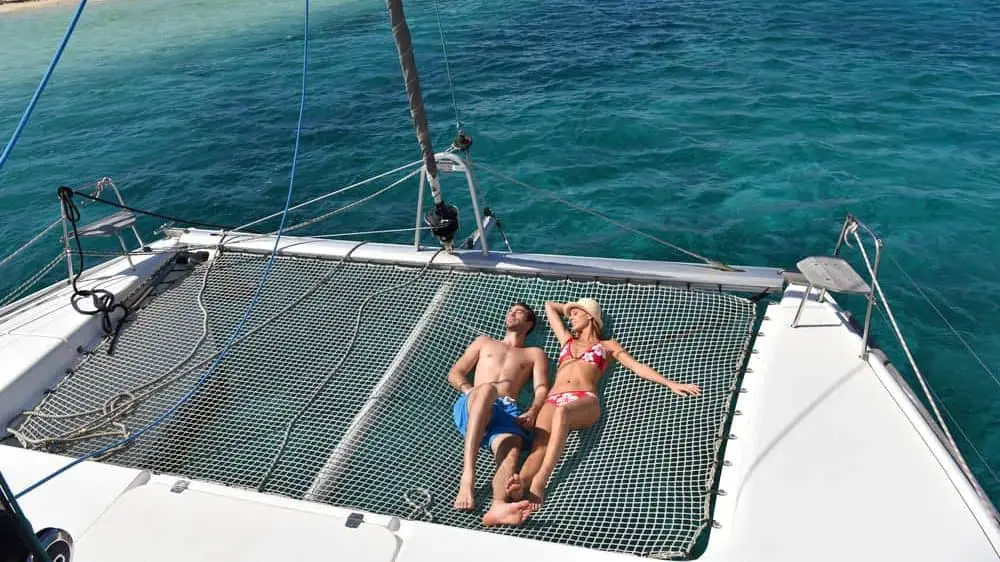
Since catamarans have more space and don’t heel as much, they offer a more comfortable experience. One beautiful aspect of having a big deck is that you can hang out in the trampolines; they are basically two big hammocks, and since hammocks already are great, putting them on a boat makes them awesome.
And since it doesn’t heel, you can also freely move around on the boat without spilling your drink or being at risk of falling overboard. This also means that going inside to cook is a treat since you don’t have to cook while trying not to fall over.
Looks and Other Factors
All in all, catamarans are great, but so are monohulls; there are also many other factors that I haven’t mentioned yet; these are mainly factors of the heart.
Many people feel that it isn’t real sailing if it isn’t done like it was in the good old days, heeling over and all. And to some extent, I can totally agree with that, but on the other hand, enjoying those two trampolines while on a sunny weather cruise down the bay is something I can’t forget.
And also the looks, catamarans look great; I think they look and almost move like those manta rays you can see down in the Bahamas. On the other hand, there is not much cooler than seeing a solid old monohull dig deep into the waves and go almost straight into the wind; what a feeling!
What do you think?
Owner of CatamaranFreedom.com. A minimalist that has lived in a caravan in Sweden, 35ft Monohull in the Bahamas, and right now in his self-built Van. He just started the next adventure, to circumnavigate the world on a Catamaran!
Leave a Reply Cancel reply
Your email address will not be published. Required fields are marked *
Save my name and email in this browser for the next time I comment.
Recent Posts
Must-Have Boat Gear for Catamaran Sailors!
Sailing is probably the most gear-intensive activity I've ever done; there are so many decisions to be made about what gear to buy now, for tomorrow, and what to definitely never buy. The gear on...
6 Best Trailerable Trimarans For Bluewater and Coastal Sailing
Having a boat costs a lot of money, even when you are not using it, marina fees, etc. And once it is in the water most sailors never go very far from their "home marina" and sailing will be somewhat...

Catamaran vs. Monohull: We Changed, Should You?

There are two schools of thought when it comes to monohull versus catamaran . We have done extensive cruising and lived aboard two monohulls and four catamarans over the past 25+ years . We experienced the good and the bad for both single hull and multihulls first hand. Quite honestly, the pluses for catamarans far outweigh the minuses. There are multiple benefits of catamarans. They are faster, more stable and spacious, and have shallower drafts allowing safer anchorage closer to shore. Being on a stable platform with no heeling cuts down on crew fatigue and seasickness leaving the crew more alert and in control of the vessel. Even novice sailors feel more confident on catamarans.
When we built our monohull Royal Salute in the early 90s, catamarans were not established and were looked upon with extreme suspicion by most cruisers, including ourselves. “Safety and the capsize” issue were always the first things to come up against sailing catamarans. It is a fact that monohulls can get rolled in heavy seas but will right themselves because of the heavy lead keel, and while crew and vessel will be battered, the roll is survivable.

However a catamaran once capsized, will remain upside down (jokingly referring to this state of the catamaran as “reaching its most stable position when upside down”). The inability of a catamaran to self-right was and still is a major bone of contention. However, what is not often discussed is that a monohull has about a 5,000 pound keel of lead that is constantly trying to drag the boat to the bottom of the ocean versus a catamaran that has no ballast and is in most cases with modern catamarans, unsinkable.
So the options are to either sail the world on a boat that, if it springs a leak, will sink like a stone or a vessel that cannot self-right in the event of a capsize but will not sink no matter what. So from a practical point of view, here are our observations over the last 25+ years of living aboard, on the advantages and disadvantages of a catamaran.
ADVANTAGES OF A CATAMARAN
1. speed equals safety.
The speed of a catamaran makes it possible to outrun bad weather. While catamarans do not point as high into the wind as a monohull (or if it does, it makes more leeway or slides sideways), it is about 20% faster than a monohull. This means that even if you sail upwind at a slightly wider angle to the wind than a monohull and have to cover more distance, you will still arrive at your destination long before a monohull.
A modern performance catamaran with daggerboards and good quality sails will point as high as a similar sized monohull. It will point the same as a comparable monohull and sail much faster and therefore arrive at an upwind position much sooner than a the monohull. It is important to note that most of the production catamarans on the market are under-powered and are equipped with standard smaller sails. In lighter breezes many of these designs perform poorly unless fitted with bigger headsails, a Code Zero and a square-top mainsail.
While we believe that more comfortable and safer in rough weather , we have to concede that when the weather gets really bad (60 knots of wind or more) we would personally prefer to be on a monohull from the standpoint of surviving. I would say that a monohull is preferable for serious offshore single-handed sailing because you can more easily hove-to in a monohull. We have been in some extreme weather on a number of catamarans and never really felt that we were in danger, although it takes some nifty seamanship.
A monohull could capsize in extreme weather or even roll in a storm, but they generally come back upright. A catamaran on the other hand, will not right itself. But the cat will generally stay afloat, offering a good place to survive while you wait out the storm or until help comes along. Well-designed modern catamarans are very hard to capsize though.
Having said all that, most catamarans can do 200 to 250 miles a day and with modern technology allowing one to pull down weather at will, there is no good reason why you should get caught in extreme weather. A faster boat is a safer boat as it will in many cases be able to outrun bad weather. With good weather routing information a catamaran can avoid most serious weather and, at worst, place itself in the most favorable position to avoid the brunt of a storm.
2. A Catamaran is a Stable, Safe Platform Underway
Catamarans have no ballast in the keels like monohulls do and therefor it relies on beam and buoyancy for stability. Typically cruising catamarans will have a beam to length ratio of roughly 50%, although many designs nowadays exceed the 50% rule of thumb. So, a 45-ft long catamaran will be about 22-ft wide, providing a very stable platform when sailing. Unlike catamarans, monohulls cannot overcome the rolling and pitching with their narrow beam and the lead ballast for stability.
This rolling and pitching makes the deck on a monohull very unsafe whereas on walking around on the deck of a catamaran while underway is far easier since the boat is much more stable, and it doesn’t heel. This makes sail changes and reefing much easier and a lot safer for the crew. Without the rolling and pitching motion, the danger of falling overboard on a catamaran is considerably less than on a monohull.
3. Crew Fatigue Reduces on a Catamaran
Because a catamaran does not heel over like a monohull, it offers far more comfort underway because the motion is mostly fore and aft pitching and very little beam-to-beam rolling. On all points of sail, a catamaran tracks upright and significantly reduces crew fatigue and seasickness. Seasickness is usually caused by things like anxiety, fatigue, hunger and cold, which all add to a sense of disorientation. This leads the crew to making bad decisions and seamanship errors that could be fatal to the crew and vessel. The more stable platform of the catamaran will hugely keep those issues at bay, making the crew more alert and energized.
Every action and chore including cooking is much easier on a catamaran when underway. It is much more pleasant to be on the deck level looking out rather than being stuck “down below.” It is also much nicer to sleep on a boat that doesn’t heel. I remember nights at sea in our monohull when I was rolling around in my bunk unless I was properly wedge in a little corner. That is simply not the case on catamarans.
All these factors ensure that your crew will not expend unnecessary energy to simply try and stay upright, onboard and safe on a long passage. Your crew on a catamaran will be well rested and alert and will be able to function well if a stressful situation arises.
4. Comfort at Anchor
Catamarans provide a wide platform and therefore offer lovely spaces to relax at anchor without the rolling motion that monohulls have a tendency to do in a swell. During our 15 years of cruising on a monohull, we have often had to leave anchorages that we really were not finished exploring because of a rolly, uncomfortable anchorage. Big rollers or swells coming into an anchorage can make conditions in an anchorage very uncomfortable and unsafe.
We were anchored off Funchal on the island of Madeira in our monohull Royal Salute once, when we were forced to leave our anchorage. The rolling became so bad, we were rolling from gunnel to gunnel. The anchorage became untenable to remain anchored, forcing us to go out to sea in foul weather in the middle of the night. This is an extreme case but believe me, we have left many an idyllic anchorage because of a rolling swell into the anchorage. Catamarans, on the other hand, do not roll from like monohulls have a tendency to do and are far more comfortable at anchor.
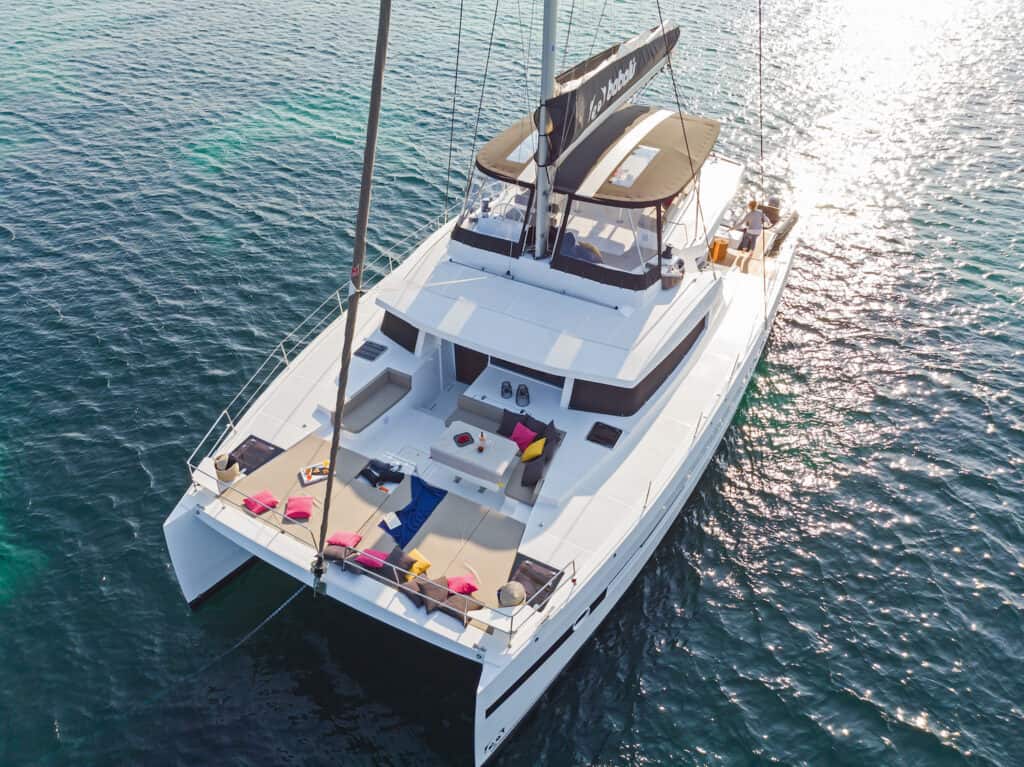
5. Anchor Bridal Setup

Catamarans are fitted with a bridle, attached to both bows and down to the anchor chain, resulting in a very stable position at anchor. What we found with our monohull was that because the bow acts as a sail (because of the high freeboard), the boat tended to sail at anchor in high winds. It sailed in one direction until the chain snatched and tacked over and sailed in the other direction, feeling like it might dislodge the anchor altogether. The catamaran on the other hand sits at anchor a lot more stable and doesn’t sail around as much.
6. Ease of Boarding on a Catamaran
Thank goodness we were much younger and more agile during our monohull days. Royal Salute and most monohulls of her generation or older, have high free-boards, making it quite a feat to get onto the boat from the dinghy. It was one of the most challenging things to do because unlike the more modern monohulls that have a scoop at the back, we had to climb up on the side of the boat to get on and off. We, of course rigged steps, etc. but it was always a hassle compared to the ease of getting on and off a catamaran from a dingy or from the water.
7. Shallow Draft Equals Better Anchorages
Catamarans have significantly shallower drafts than monohulls, allowing for safer anchorages closer to shore. Most catamarans in the 40-ft to 50-ft range draw between 3-ft to 4.5-ft, so they can anchor in places that a monohulls can not even consider. In the shallow waters of the Bahamas for example, the catamarans have a big advantage. We often anchor our own catamaran just a few feet away from a beach. It definitely allows one to be able to explore areas where the water is shallow without the fear of running aground.
The shallow draft also allows for emergency repairs in shallow water and even doing the bottom job when the tide goes out as we have done in places like Mtwapa Creek in Kenya, East Africa. The catamaran easily rests on her keels on the sand without help making it a breeze to do the “annual haul out” even in remote locations.
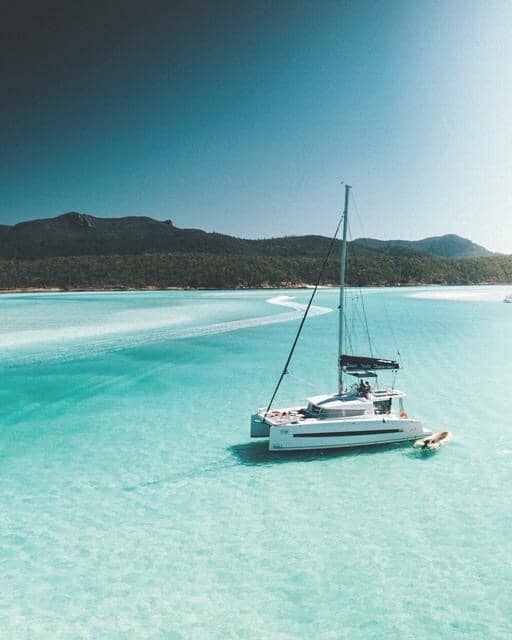
8. Dinghy Davits & Dinghy Size
All catamarans have a set of davits that make it very easy to raise and lower the dingy. Our monohull and most cruising monohulls do not have an efficient or easily accessible set of davits. This makes raising and lowering the dingy an elaborate production. Catamarans on the other hand, has davits systems easily accessible and some even have platforms to rest the dinghy on.
The lack of beam and difficulty of lifting the dinghy also limits the size and type of dingy that one can reasonably carry on a monohull. As we all know, the dingy is your transport to and from shore and diving or fishing spots, so the bigger and faster the dingy, the better off you are. A catamaran can carry both a heavier and bigger dinghy which makes the popular center consul dinghy so much more possible.

9. Interior Space and Comfort on a Catamaran
We sailed 32,000 NM on our 45-ft monohull, happy as clams, not realizing that sailing does not have to be done lying on your ear 24/7 while on passage or sitting knee-to-knee in the cockpit at anchor with your two other guests at the dinner table! One can liken sitting in a monohull cockpit to sitting in an empty Jacuzzi, you are always nice and close to the other folks.
Now that we are on our fourth catamaran, there are a few things that have become more evident to us than the incredible space and comfort of a catamaran, not only at anchor but also underway. The cockpit and living space in general are huge compared to a monohull, making for very comfortable and spacious living conditions. It feels more like you are at home, rather than just on a camping trip.
Knowing that one spends at least 90% of one’s cruising life at anchor, it’s important to have good open living space, which most modern cats nowadays offer. A lot of cats have walk around beds, lots of storage, every modern appliance including washer/dryer, etc. However, one has to fight the urge to fill the space if you want to keep the cat light and fast.

Sailing with guests onboard for extended periods of time, in close quarters can become claustrophobic but on a catamaran people are spread out and separated. With guests sleeping in one hull and the owners in another, catamarans offer much more privacy and separation. Some cats even have privacy doors that will close off the entire hull and has a separate entrance onto the deck, which really separates you from the guests completely.
There is very little heeling on a catamaran, so there is no need for hand grips and safety harnesses inside the boat. There is nothing better (and safer) than being able to walk from the cockpit into the living room (saloon) on one level or one step down at most. In a monohull, when heeling at a severe angle, you would have to claw your way from the companionway steps down to the living area, while fighting to stay upright, significantly tapping your energy.
Unless you hit extreme conditions, everything stays put on a catamaran reducing the anxiety before doing passages of having to stow and secure everything. This very issue makes a lot of cruisers reluctant to weigh anchor and explore more often. It is just too much effort to pack away all your stuff once comfortable in an anchorage!
One thing you will notice is that the stove on catamarans are not gimbaled like it is on monohulls and this should tell the story in itself. The stability and comfort on a catamaran is far superior. Cooking is easy and safer. I often open a nice cold beer, put it down to do something and forget about it only to find a warm beer later in the same place I left it. This is not something that happens on a monohull.
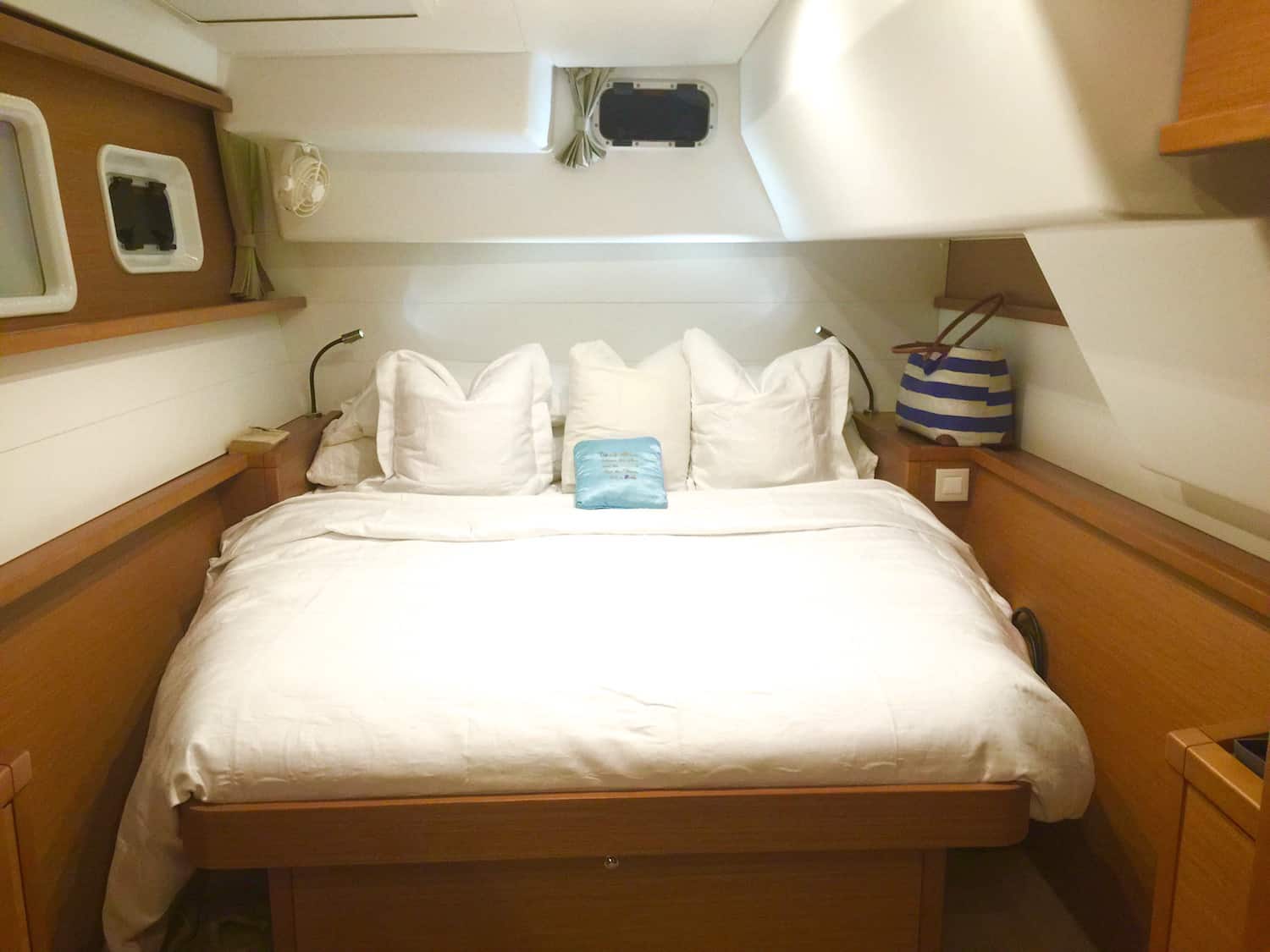
10. Redundancy on a Catamaran
Unlike monohulls, catamarans have a lot of critical redundancies. That of course means two hulls to clean and anti-foul, double the engine maintenance, etc. but having two of the critical equipment like engines for instance, outweighs the downside.
With two engines, if one fails you still have adequate propulsion to go anywhere. If by some fluke the second engine also fails, you have a full set of spares to fix at least one of them. Our friends once hit a sleeping whale off Tanzania, and when it dove, it hit the prop, bending it. They limped into the narrow channel on the one engine but at least they could make it to a safe harbor where we surveyed and repaired their damage.
We often only use one engine when motoring while making passage in order to conserve our fuel. The one engine is totally capable of moving the boat along at a good speed unless you are in heavy seas and you may need more power. Other than that we only use two engines to dock or maneuver the boat in close quarters.
Because there are two engines there are also two independent charging systems via the alternator on each engine. If one alternator goes out, there is still another complete charging system. There are two rudders and if one fails or falls off (as has happened to our friends on a monohull off Columbia, where they almost lost their boat) you have a second rudder that is completely capable of steering the boat by itself indefinitely. That holds true for several things on a catamaran!
11. Maneuverability
The engines are spaced far apart on a catamaran and it makes maneuvering much easier and more precise than monohulls, unless the monohull has a bow thruster. We did not have a bow thruster (not many monohulls do) and had to rely on prop-walk and using prop wash on the rudder. A modern catamaran can do a 360 turn on her own axis. A monohull cannot do this and have a bigger turning circle. However, a monohull under sail is much more maneuverable and certainly will tack a lot faster than a catamaran. The ease in maneuverability under engine on a catamaran in close quarters specifically, is vastly superior comparatively.
12. Rigging
Because of the beam on a catamaran the spinnaker pole has become unnecessary equipment. Hallelujah, I say. That pole on our monohull was a pain the behind and I always hated having to use it. On a catamaran, one can fly an asymmetrical cruising chute or spinnaker, using the bows to tack the clew or run a guy through a block so it is very much simplified, easier and safer.We also sail wing-on-wing with twin headsails when we sail downwind. We use our furling jib and furling Code Zero. It is as easy as one, two, three.
DISADVANTAGES OF A CATAMARAN
1. bridgedeck slamming.
One advantage most monohulls do have when underway is that they don’t slam. Catamarans with a low bridgedeck clearance can experience significant slamming in confused seas sailing upwind. This slamming can be quite disconcerting when you first experience it as we did on a Shuttleworth 44 design, our first ever catamaran experience, 20+ years ago. At times, it felt as though the boat was falling apart. Of course the boat was fine but nevertheless, the stress on the crew from the constant noise and discomfort was significant.
Monohulls don’t have a bridgedeck which means no slamming and are therefore a bit more comfortable than l ow bridgedeck catamarans when beating into severe confused conditions or “washing machine” conditions as we call it. Modern catamarans mostly have better bridgedeck clearance and the slamming is significantly less. However, not all cats have a good clear tunnel under the bridgedeck. Some manufacturers build beds into the bridge deck in order to make more space in the chest of the catamaran where the slamming occurs. These protuberances into the bridgedeck tunnel will likely increase slamming. So be mindful of that when selecting a catamaran. We currently own a Bali 5.4 and the bridgedeck clearance on this boat is more than adequate and the tunnel is clear. We therefor experience very little slamming compared to our Prout 45 that we previously owned (picture of sister ship below) with a much lower bridgedeck.
We Explain Bridgedeck Clearance
In the pictures below, the Bali 5.4 has very good clearance from the water to the bridgedeck and has a nice clean tunnel versus the very low bridgedeck of the Sunreef 50.

2. Sailing Downwind
Monohull spreaders are set at 90 degrees to the mast whereas a catamaran has to have backswept spreaders. The reason is that, on a monohull, there is a backstay and using this, plus the intermediates you can get a nice pre-bend in the mast (the pre-bend is to flatten out the main sail and allow for better performance).
On a catamaran with no back stay, you need to use the back swept spreaders and the diamonds to pre-bend the mast. The reason I point this out is because on a catamaran, if you want to broad reach or run, the mainsail cannot be let out all the way because the backswept spreader tips could punch holes in the fabric.
On a monohull, the spreaders are at 90 degrees so you can let the main and the boom out much further which is, of course, much more effective. This is one of the reasons it is better to broad reach and tack downwind on a catamaran.
Whether a monohull or multihull, sailing dead downwind doesn’t usually make great VMG. Therefor a regular cruising cat, much like a monohull, needs a lot of sail area and has to sail deep downwind if it is to achieve a decent speed made good (VMG). This video demonstrates how we achieve this by sailing wing-on-wing downwind.

It is more difficult to find a dock either as a transient or a permanent slip for a catamaran in general because of the wide beam. But this is changing fast and will soon not be too much of an issue. In the USA dockage is charged by the length of the boat in feet, so there is no disadvantage there but, in some places, (the Mediterranean for example), dockage is charged at length times one and a half because of the additional beam.
Since the catamaran is stable at anchor, we mostly anchor out. We have more privacy, a better breeze and usually a stunning view.We have a nice dinghy with a good outboard engine and is big and comfortable enough to get to shore fast and together with the modern conveniences like the generator, watermaker and washer/dryer, docking becomes a non-issue.
It is definitely more difficult to find a travel lift with enough beam for a catamaran for a haulout, while, for a monohull, there are absolutely no problems anywhere. The wide beam of cats also greatly limits the number of shipyards that can haul them out. Most catamarans over 40-ft must be hauled out with a 50-ton travel lift. This not only increases the cost of the haulout, but greatly limits the choice of the shipyards for repairs and maintenance. With limited choice, prices are high for shipyard services.
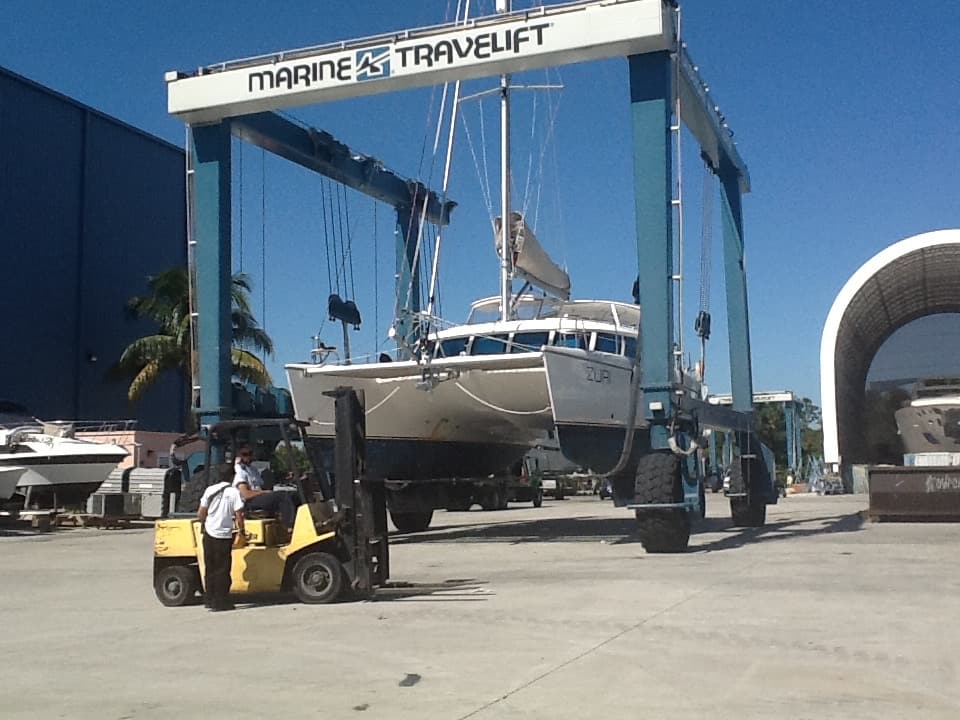
Catamarans do tend to have a lot more windage than monohulls. This can be an issue especially when maneuvering in close quarters with a strong wind. But I have found that, provided the engines are powerful enough for the size of catamaran, that twin engines negate this problem. Also, many modern large catamarans now have a bow thruster fitted. It is super easy to dock.
The cost of getting into a catamaran is much higher than that of monohulls. That could put a serious dent in your cruising kitty or require you to put your dream on hold a little longer. Pre-owned monohulls on the other hand are very cheap to buy comparatively, because the supply presently far outweighs the demand.
Catamarans are in high demand and they typically hold their value much better and longer and the trend is now heavily in favor of the catamaran market. When prospective buyers contact us for catamarans under $250,000 the choices are very limited and catamarans under $100,000 is near impossible to buy. In this case, your best bet is to go with a monohull unless you go with much older boats like the Prouts or the less expensive Geminis.
Our Own Catamarans & Monohulls
FYI: Royal Salute , a Bruce Roberts 45 monohull, was the first boat we owned and sailed approx. 30,000NM on. Mythral, a Seafarer 30, was our “toy boat” while we were waiting for our catamaran to be built. Even though this classic little monohull sailed around the world, it didn’t have much in modern conveniences like running water. Siyaya was an Island Spirit 40 catamaran that we sailed from Cape Town to Florida on and then taught live-aboard sailing classes for several years. Zuri I was a Prout 45, a beautifully crafted catamaran but by today’s standards is considered old technology. Our Lagoon 450 SporTop ( Zuri II ) is a fantastic live-aboard catamaran. We lived and taught aboard her for three years but sold her last year and we currently own a Bali 5.4 ( Zuri III or Z3 as we call her now). Read about our various boats .

CONCLUSION: CATAMARAN vs MONOHULL
We were dyed in the wool monohull sailors for 15+ years. We loved the pretty lines of monohulls, the sailing ability and what we believed at the time to be much safer vessels. However, now that we have been avid catamaran enthusiasts, we simply can never go back to monohulls. Catamarans have come of age and with modern technology have overcome most objections that sailors of old had against them. They are well designed and built, are safe, and we simply love that they sail fast and upright. There is not a whole lot to dislike about a catamaran when you live aboard. We have weighed all the pros and cons of catamarans and found that the pros far exceed the cons. We made the change to a catamaran and do not regret it one bit!
We hope that this article will clear things up for all the prospective catamaran owners out there.
Contact us if you have any questions regarding catamarans, Fractional Yacht Ownership or our Charter Management Programs .
Estelle Cockcroft
Join our community.
Get the latest on catamaran news, sailing events, buying and selling tips, community happenings, webinars & seminars, and much more!
4 thoughts on “Catamaran vs. Monohull: We Changed, Should You?”
I read that the engineering on the catamarans were improved over the years. Whats the oldest year would you recommend designwise?
Scott, my apologies for the late reply. We’ve been traveling in Africa. Anyway, catamarans have come a long way and improvements in technology is happening at lightning speed. I reckon that even the older model catamarans are good. It depends on what your needs are. If you want something a little better performance wise, I would go for something no older than 15 years.
After buying a catamaran what is the difference in expense of a catamaran vs a monohull. Many articles state that not only the initial cost of a catamaran is more it the operating cost as well.
Hi Todd, it is more expensive. The annual dockage and haul out as well as maintenance will be more expensive. You obviously have two engines to maintain and various other pieces of equipment to service in both hulls. While there is more equipment there is also more redundancy and of course you have the comfort factor. So, depending on your situation, it’s probably worth it.
Leave a Comment Cancel Reply
Your email address will not be published. Required fields are marked *
Save my name, email, and website in this browser for the next time I comment.
Recent Posts

Top 10 Reasons to Sell (and Sail) Your Catamaran in Annapolis, MD
We have a new home in Annapolis! The office is located in Annapolis, Maryland

Top 10 Reasons to Sell (and Sail) Your Catamaran in Texas
Our Texas Office is located in the Watergate Marina Center in Clear Lake Shores,
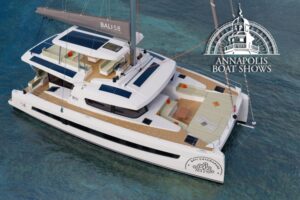
Annapolis Boat Show 2024
Meet with our team! Want to learn more about the Bali and Catana

Exploring the Catana OC 50 Catamaran: A Comprehensive Overview
The Catana OC 50 Catamaran, the latest addition to the Catana Ocean Class series,

For more than 30 years, we have been a part of the catamaran community and created Catamaran Guru™ to encourage and educate all the aspiring sailing out there. We understand the dream of traveling the world by catamaran and created a one-stop-shop to make that dream a reality for you.

- Stephen & Estelle
- Testimonials
Get Started
- Yacht Sales
- Used Yachts
- Charter Management
- Boat as Business Programs
- Seminars & Events
Yachting Monthly
- Digital edition

Monohull or multihull: which is best for blue water?
- Chris Beeson
- March 29, 2016
As former editor of Yachting World, David Glenn has plenty of experience of both monohull and multihull cruising. Here he weighs up the pros and cons

One hull, or two? Your choice will define your life afloat Credit: David Glenn
Through the binoculars I could see masts off Basil’s Bar on Mustique. Their lack of movement suggested a fine anchorage, sheltered from the tradewind-driven swell that builds up in the channel between Mustique and Bequia. It soon became apparent that most belonged to cats, immune from the rolling monohulls like ours would endure if we were to stop in this otherwise enticing bay.
More anchorages in a multi

Cats galore off the Soggy Dollar Bar, Jost van Dyke: too shallow for a fixed keel monohull of similar size
Stability is one of the truly great advantages of a cruising multihull. Not just at sea where the tiresome business of heeling is something that simply doesn’t – or shouldn’t – happen to any great extent, but at anchor too. It dramatically widens one’s choice of anchorages to include those affected by swell – not uncommon in the Caribbean, for instance, where a subtle change in wind direction can make a previously flat calm anchorage unbearable in a monohull. Its comparatively shoal draught widens the choice still further.
I grew up with monohulls, own one, and frankly wouldn’t consider a multihull for the sort of sailing I do. In northern European waters, marina berthing is a regular necessity and completely safe open anchorages are few and far between.

No rolling or heeling, 360° views and one-level living, as here on a Lagoon 52, appeal to many
But if I were to undertake some serious blue water cruising and I wanted family and friends genuinely to enjoy being afloat, particularly those less experienced, a multihull would have to be a consideration. I would have to put aside the question of aesthetics – let’s face it, they’re ugly beasts – and forego that unique and satisfying sensation of a yacht sailing well, because to date I have not experienced it in a cruising multihull. And that’s quite a sacrifice.
More space in a multi
My attitude changed after chartering catamarans in the Caribbean and Mediterranean. The need to accommodate two families comprising largely of teenage children made the choice of a multihull a no-brainer. In a 46-footer we could accommodate a party of 10 in comfort and the paraphernalia demanded by youth, like surfboards, windsurfers, kites and snorkelling kit, without feeling jammed in.

One-level living makes a big difference when sailing as a famly
The cavernous berths in the ends of the hulls, the wide saloon-cum-galley with its panoramic view and the inside/outside lifestyle made possible by the juxtaposition of the big aft deck and the same level saloon, got the entire crew onside instantly.
As an outside living space, with a trampoline at one end and a massive aft deck at the other, there is simply no comparison with a monohull of the same length. So space, linked to stability, makes for an experience that everyone, even the timid and novices, will find hard not to enjoy.
No speed difference

A multihull, like this Moorings 46, has abundant stowage on deck and below, but filling it all will slow her down
Load-carrying ability is a double-edged sword. On the up side there is room for a big crew and its kit, much more fresh water tankage than a monohull, eliminating the need for an expensive, temperamental watermaker, and finding space for a generator should be easy.
On the down side the temptation to overload will probably cancel out any perceived performance advantage. Multihulls can be relatively quick in the right offwind conditions, but if they are heavily laden – as they will be for blue water cruising – there really is no significant speed advantage.

The Gunboat 66 Phaedo 1 piles on the speed, but for blue water cruisers, comfort and stowage is more important than pace
Some new designs such as Gunboat and Outremer have concentrated on performance, but most clients aren’t overly concerned about outright speed and are happy to trade performance for the considerable comfort offered by brands like Lagoon, Broadblue, the Fontaine Pajot stable, Leopard, Catana, Privilege and others.
Mono sails better

Monohulls, like this Amel 55, sail better upwind, and her ballast keel adds displacement, which means comfort when it’s rough. Multihulls can develop an unpleasant motion in a big sea
Upwind, most cruising multihulls won’t point like a monohull with a deeper keel, and when it gets lumpy and fresh, the motion can become distinctly unpleasant. You have to keep a particularly careful eye on sail area too, but more of that in a moment.
In 2011 I was involved in a test of three cruising catamarans and among my fellow judges was multihull design legend Nigel Irens. He pointed out that catamaran buyers have voted for accommodation (which means weight) over performance, so the dilemma of mixing the two has largely disappeared. With it went the spectre of capsize because, relative to their displacement and beam, the modern cruising catamaran is under-canvassed. But that doesn’t mean that sailors can simply set sail and go in any weather.
‘Speed limits’ on a multi

On a multihull, it’s more important to know when to reef. Set speed limits and stick to them
Also on the panel was Brian Thompson, the lone Brit on board the 130ft French trimaran Banque Populaire V that sailed around the world in under 46 days. He told me that the tell-tale signs for knowing when to reef are far more subtle on a multihull. Apart from instinct, Brian suggested monitoring boat speed closely and having a speed limit to trigger reefing. It is easy to overlook a building breeze when bowling along downwind in a multihull, which is going faster and faster. ‘Keep your boat speed within safe limits you should not get into too much trouble,’ he said.
People often ask about anchoring a multihull, which is important as a multihull will spend a lot of time at anchor. Squeezing into a marina can be nigh on impossible, and expensive if you can get in. An essential piece of kit, which should be standard with a new boat, is a bridle that runs from either hull and keeps the anchor cable on the centreline. In many ways this is easier than anchoring a monohull as it prevents the ground tackle from fouling the hulls.
If you do get alongside a marina pontoon you will soon discover another modern cruising multihull issue: excessive freeboard. It’s worth investing in a portable ladder for those marina moments. Of more concern is MOB recovery. There are bathing platforms on both hulls of most new boats, but it’s not the place to be if a yacht is pitching in a heavy sea. So considerable thought needs to be applied to retrieving an MOB if the worst happens.
The recent and dramatic increase in numbers of multihulls going blue water cruising is certainly testament to their appealing ‘lifestyle’ attributes, but one must bear in mind that they are not a fix for all liveaboard cruising challenges. It’s just a different way of doing things. The elements remain the same and can inflict just as much punishment for the unwary on a multihull as they can on a monohull.
Enjoyed reading this?
A subscription to Yachting Monthly magazine costs around 40% less than the cover price .
Print and digital editions are available through Magazines Direct – where you can also find the latest deals .
YM is packed with information to help you get the most from your time on the water.
- Take your seamanship to the next level with tips, advice and skills from our experts
- Impartial in-depth reviews of the latest yachts and equipment
- Cruising guides to help you reach those dream destinations
Follow us on Facebook , Twitter and Instagram.

Catamaran Or Monohull? 27 Important Facts (Explained)
Catamarans and monohull boats are two very different kinds of vessels. Each craft offers distinct advantages and disadvantages that you’ll want to consider before choosing between the two.
In this post, we’ll go over some of the important things to consider when choosing between catamarans and monohull boats:
Table of Contents
Cost & Availability
Both catamarans and monohull boats come in small recreational sailing versions, larger motorboat versions, and larger sailing models. In all cases, the catamarans will cost more and will be harder to find.
The reason catamarans are harder to find because there are not as many of them, and they’re mostly made overseas.
Also, there aren’t as many catamaran manufacturers, so sailors have fewer options when buying them.
On top of this, catamarans have only recently become popular in the United States and other areas of the developed world. This means the used market for boats doesn’t have as many catamarans on it. You might find that you have fewer options when making a used catamaran purchase, which could bring costs up to a premium.
Two Times The Fun with Catamarans

Another reason that catamarans are more expensive than monohulls is the fact that catamaran buyers have to purchase two hulls, two engines, and two of all of the components that help make an engine work.
Traditional sailboats and large powerboats with one engine don’t have this cost issue.
On top of this, a catamaran is much wider than a monohull, and thus you have more space to build and equip.
On the other hand, once you’ve purchased the boat, you do get to enjoy the benefits of having two of everything. We’ll talk about the advantages of this further down in this post.
Maintenance Cost Makes A Difference
The maintenance on a catamaran is also more expensive than the maintenance on a monohull boat. This goes back to the fact that there is twice as much of everything to maintain.
Catamaran owners will need to do preventative maintenance on two different engines, and they’ll have two hulls and a large deck area to clean and maintain as well. If they’re getting the bottom of the boat treated, they’ll have to do this twice (once for each hull).
Even the interior components can usually be found twice.
Each cabin will usually have a head in it, so you’ll have at least two toilets and sinks to maintain, which obviously has its plusses and minuses.
One positive aspect of this is that catamaran owners do have the option of deferring some of their maintenance. For example, if one head is no longer functioning properly, you always have the second one that you can use.
It also adds a bit of safety as well.
This is because while the catamaran does have two engines to maintain, the owner does have power even if one of the engines happens to go down.
Some catamaran owners also like to point out that maintenance may not have to be done as frequently. This is because the engines don’t have to work quite as hard, and other items like additional bathrooms and sinks might only be used half as much.
How Much Space Do You Need?

A catamaran has more space than a monohull. This is because the boat is wider, and it has a much larger deck area. It also has twice as many hulls, so you have more overall space between the two of them.
The additional space is great for people looking to throw parties on their boats.
Most boat owners would agree that the catamaran is usually the party boat of choice at the docks.
Even if you aren’t into throwing parties, the extra space can still be nice for relaxing on the deck or getting a suntan. The wide-open space also makes it easy to use the boat as a fishing platform.
Additionally, you have more space for stuff like surfboards, rafts, and other items that can easily clutter up the deck of a monohull. Even fishing can be easier from a catamaran as the deck provides plenty of space between different anglers.
Catamaran owners also have additional space for carrying fresh water and adding generators and solar panels.
Interior space is generally more plentiful on a catamaran, and luxury catamarans have an easier time fitting large items like washers and dryers inside of them. You can have these on larger monohulls as well, but it will be harder to make them fit than it is in a catamaran.
On the other hand, all of the additional space means the catamaran owner has more space to maintain and clean. Also, all of the additional items that can be brought onto the boat will make it heavier. A heavier boat will use more fuel, and it will travel more slowly.
Living Quarters Vary Between The Two
The living quarters on a catamaran are much different than they are on a monohull. Most people would agree that the berths in a monohull are much more spacious than in a catamaran.
A monohull offers people the opportunity to have a large bed with space on either side to walk around it. This is great for couples who want to get out of bed without waking up their partner.
Catamarans, on the other hand, have the advantage of being able to offer large above-deck salon areas. The galleys, the dining areas, and the living areas can all be above-deck, while the two hulls can provide heads and berths.
Some boat owners say that living in a monohull is akin to living in a basement apartment . Other boat owners prefer the monohull because it brings them closer to the water and gives them the feeling of being at sea.
Privacy Can Be Prioritized On Catamarans
A catamaran offers up many different living areas that people can take advantage of. For example, each hull will typically have its own bathroom and bedroom.
This gives each sleeping area complete privacy from the other.
The living quarters are usually up on the deck, so early risers can wake up and move to these quarters without waking up the others.
The same holds for night owls. A night owl can stay up late without bothering the people who want to retire to their beds earlier.
With two hulls, large catamaran owners can hire a crew and give them their own hull to live in so that there is separation between the cruisers and the crew. This is a wonderful advantage for honeymooners looking to have their own space.
The downside to all of this, of course, is that sometimes a family may not want the additional privacy. For example, a family with small children might not want their children in a different hull than they are.
Additionally, the extra privacy can make it hard for people on the boat to communicate. This could become a big problem in the event of an emergency.
For this reason, it is often recommended that each hull have a radio in it so that the occupants can quickly communicate with each other. Remember, even in inland areas, cell phone reception may not be very good inside the boat hulls.
Recreation In a Monohull vs. a Catamaran
Most sailors agree that sailing a monohull boat is much more exhilarating than sailing a catamaran. Traditional sailboats heel, and sailors get instant feedback while they’re sailing. For the most part, catamarans stay stable, and you don’t get the same feeling with the movement of the wind and the water.
When it comes to monohull powerboats, you have the advantage of being able to pull water skiers, kneeboarders, and tubers with ease, as long as the boat has the power and a planing hull. A power catamaran usually doesn’t have the speed or maneuverability to pull off these recreational opportunities because they are displacement hull designs.
Catamarans excel in more leisurely recreational activities. A catamaran makes a great party deck as well as a great cruising deck. Catamaran owners can comfortably walk around a catamaran without having to worry that the boat might knock them over the next time it decides to heel. This allows boaters to sit and talk with one another comfortably.
A catamaran can also be used as a beaching vessel. This makes it a great platform for people looking to go swimming or fishing around sand bars and other shallow water areas. It also makes it a great boat for sailors looking to sail a larger boat on a river or lake known for having shallow areas.
Swimming and Diving
Swimming and diving off of a catamaran are usually much easier than doing the same from a monohull. The wide stance of the two hulls offers boat designers the option to put in staircases at the back of both hulls.
In between these staircases, some boats will have an additional diving platform and/or a dedicated frame for pieces of equipment and dinghy storage. This makes catamarans great for swimmers, snorkelers, and divers.
On the other hand, modern monohull sailboats can also have good transom stairs for easy access to the dinghy and swimming. Both types of boats can easily travel far out to sea, giving boaters the option of diving in areas that can’t be accessed from beaches and developed areas.
Boat Draft In Shallow Waters
For the uninitiated, the boat’s draft refers to how deep the boat’s hull sits within the water.
A monohull typically sits deep within the water, while a catamaran sits much higher on the water. This is why we stated that a catamaran is good for shallow waters.
The advantage of having a boat that can go into shallow waters isn’t restricted to just recreational activities like swimming and fishing. A boat that can go into shallow water is safer to operate in areas where a boat with a deeper draft might become damaged.
Additionally, a catamaran has more stability on calm waters. This helps make a catamaran more comfortable to relax or sleep on while at anchor or the dock.
The deeper draft of a monohull boat has its advantages as well. A deeper draft provides more stability in rough waters and allows a boat to go further into the sea.
For this reason, many coastal cruisers will prefer catamarans, while many ocean voyagers will prefer monohull boats. In fact, some areas of the Caribbean and the Florida Keys can be off-limits to boats with deep drafts as it simply isn’t safe for the boat to navigate these waters.
This isn’t to say that you can’t navigate these waters in a monohull boat, but you will have to be cautious depending on how deep your monohull’s boat draft is. You wouldn’t have this issue in a catamaran.
Stability On The Sea

A catamaran offers a lot more stability in shallow waters, in calm waters, at the dock, and anchorage. This makes the boat great for cruising and for relaxing in port.
A monohull offers a lot more stability in rough waters.
This makes this boat great for heading out to sea and for navigating vast distances.
Safety Issues To Consider
Both catamarans and monohulls can be built to navigate the waters they were made for safely. This will be determined more by the boat’s category designation rather than the type of boat.
However, each boat deals with unsafe situations in different ways. For instance, a monohull boat is likely to right itself if it is capsized.
This means that even in rough seas, you’re unlikely to find yourself permanently capsized.
The downside to this is that should you become completely swamped from a capsize in a monohull boat, you are much more likely to sink. In fact, if there is a hull breach on a monohull boat, your boat could sink.
Catamarans are said to be unsinkable. This isn’t completely true, but it is very unlikely that a catamaran will sink. Even if a hull is breached, you still have a second hull to keep the catamaran afloat.
However, a catamaran can’t right itself. If you capsize your catamaran, it will stay capsized.
One other safety concern to consider is that a monohull sailboat will heel while a catamaran will not. This increases the chances that someone could fall off the boat or onto the deck in a monohull boat.
Catamarans Are Faster Than Monohull Boats
A catamaran is faster than the average monohull boat.
This is because they face less water resistance, and their narrow hulls don’t have to deal with their own bow waves as a monohull does.
Of course, catamarans aren’t always faster. Old cruising catamarans may not go faster than 8 knots, and modern monohulls can exceed 10 knots.
Monohull boats tend to sail downwind and in choppy seas better than catamarans. This gives them a speed advantage during ocean voyages.
We have a separate post with complete average speeds per type of catemaran . It’s a must read if you are at all concerned about speed!
Fuel Consumption Considerations
Catamarans have two engines to burn fuel, which can drive up fuel costs.
However, a catamaran is lighter on the water, so it usually takes less energy to move a catamaran. This means you’ll end up using less fuel in a catamaran than you would in a monohull.
On top of this, catamarans can decide to use just one engine in low wind areas. This further decreases the amount of fuel that a catamaran consumes.
These rules only apply to calm waters.
A monohull navigates waters with high waves and strong winds much more efficiently than a catamaran. In this case, you’ll use less fuel in a monohull than you would in a catamaran.
Sailing Differences To Notice
Sailing a monohull boat can be exhilarating. These boats can glide through choppy waters, and you get to feel the motion of the boat as the sea rushes by the cockpit and the wind causes you to heel.
This type of sailing also provides instant feedback as you’ll know what you need to do with the sails as you’ll feel what is going on through the boat’s motion.
Sailors all over the world have been using monohull sailboats for years, and you’ll find plenty of outlets for recreational sailing with a monohull sailboat.
Sailing catamarans do not heel like a monohull sailboat.
These boats, therefore, do not provide the sailor with instant feedback. Also, if you incorrectly sail a catamaran, you do risk capsizing the boat more easily.
Training Can Be Quite Hard
Sailing a catamaran and sailing a monohull boat are two different experiences. People looking to sail either should probably get professional training.
Obtaining this training will always be easier with a monohull boat.
This is because monohulls are more popular, so you’ll have more instructors available to you.
Do You (Or Your Friends) Get Seasick?
People who are prone to getting seasick easily might want to consider a catamaran. A catamaran provides much more stability in calm waters, and you get a lot less movement.
On the other hand, people who are not prone to getting seasick might prefer a monohull in choppy waters.
This is because a monohull will deal with deep and choppy waters with high waves much better than a catamaran will.
As a result, a catamarans movement can seem extreme under these types of conditions. People who have never gotten seasick before can end up sick under these conditions.
Here’s a separate article we wrote with everything you should know about seasickness on Catamarans . There are some things you can do and some things you should know!
Docking Is (Usually) Easier With A Monohull Boat
Docking a catamaran can be a difficult endeavor.
This is because catamarans are often too wide to be docked within the slips located in central areas of a marina.
Because of this, they need to be docked at the end of the dock. This leaves them with fewer spots to dock. It also makes docking more expensive.
Catamaran owners traveling through areas that are unlikely to have many catamarans in them may find it difficult to find a dock at all. This is true in areas of the northern Atlantic where monohulls are much more popular than catamarans.
Storage Issues To Consider
Even storing a catamaran can be more difficult. This is because storage facilities often do not have the equipment to get a catamaran out of the water.
The wide width of these boats requires special lifts, and not all boat marinas will have them.
Storage facilities that do get the catamaran out of the water will often charge more money for it. They’ll charge additional fees for taking the catamaran out of the water, and they’ll charge additional fees for the actual storage of the boat as well.
Redundancy And Backup Equipment
We touched upon this earlier, but it is worth repeating that catamarans have many redundancy built into them. This can be a big advantage when it comes to safety.
For example, if one rudder becomes inoperable, the boat can still be steered with the other one. If one engine becomes inoperable, the boat can still be driven with the other one.
In extreme cases, a hull could become damaged, and you could still stay afloat because the other hull will keep the boat safely above water. These safety advantages can save lives and keep people from becoming stranded out at sea.
The primary downside is the maintenance issue that we mentioned earlier. All of these redundant components will need to be maintained. As a result, maintenance costs will be close to twice as expensive in a catamaran.
Cooking Is Easier On Catamarans

Cooking on a catamaran is usually easier than it is on a monohull. The main reason for this is that a catamaran doesn’t heel like a monohull, so you don’t have to worry as much about things falling over.
This not only makes cooking easier, but it makes cooking safer as well.
Additionally, catamaran galleys tend to have more space in them to move around. Also, they are often up on the deck, so you don’t have to climb in and out of the hull with your dinner in hand.
Dinghy Storage
Monohulls and catamarans can both hold dinghies. The larger the boat, the larger the dinghy can be.
However, catamarans have a wide area at the rear of the boat that is perfect for holding dinghies.
This makes getting in and out of the dinghy easier. Also, people can often have larger dinghies on their catamarans because the boat’s stern is so accommodating.
Power Generation Is Easy On A Catamaran
A catamaran has a lot of space for solar panels and wind turbines. Rigid panels can be placed in areas that won’t be walked on, like overtop of the bimini, and flexible panels can be placed in areas where the panels might end up getting stepped on.
The width of a catamaran even gives them more opportunities to put hydro generators into the water.
This means catamarans can generate more power than the average monohull boat can generate.
On the other hand, a monohull usually has less powered items to worry about. Monohulls need less power to operate at full capacity, so you may not need all of the additional space for generating power.
Ventilation Issues To Think About
Some people feel that monohull boats don’t offer enough ventilation. This is especially true in warmer areas of the world.
Catamarans also lack ventilation within their hulls, but fortunately for them, much of the living space is located up on deck. This gives catamarans an edge when it comes to cruising in warm weather.
On the other hand, monohull owners aren’t exposed to the cold winds that you might find up on deck in harsher climates.
This lack of airflow may actually be of benefit in this instance.
Some people find monohulls to be better looking than catamarans and vice versa.
This all comes down to personal preference, so you’ll have to decide for yourself which type of boat has the advantage in this case.
Some people think catamarans are the most elegant thing in the world while others prefer monohull boats as they look more classic.
Resale Value Is An Important Factor
If you read our extensive guide to boat depreciation per boat type , you know that no matter what boat you buy, it will always go down in value. This is just a sad fact of boat ownership that people need to consider before buying a boat.
Many factors go into how much you’ll be able to get for your boat when you resell it. These factors are the condition of the boat, the age of the boat, and the economy in general. For example, people are less likely to want to buy boats during a recession. This is especially true when it comes to smaller boats.
However, one additional factor that catamaran owners need to consider when thinking about resale value is the value of the dollar.
People from the United States don’t have many American catamarans to choose from and will usually need to buy these overseas.
This means that a catamaran will be less expensive to buy when the dollar is strong compared to the Euro and more expensive to buy when the dollar is weaker in comparison. This will affect the used market as well because higher values on new catamarans can help to bring up the value on the used market.
With a monohull boat, you may not have to consider situations like this as there are makers of monohull boats all over the world.
Don’t Let The Length Trick You!
One thought to keep in mind when comparing monohull boats and catamarans is that their different shapes account for different space advantages.
For example, a 40-foot long catamaran will have much more cubic space than a 40-foot long monohull.
Because of this, when comparing boats, you should look at the cubic space rather than the length. In this case, you may be comparing a 48-foot long monohull with a 40-foot long catamaran.
When you compare the two types of boats in this manner, the price differences aren’t quite as large, and the comparison is fairer. It also may make the operating and maintenance costs more similar.
This is an important distinction to make because the length of the boats can trick you!
Consider Trying Both (Before Buying)
Boats can be an expensive purchase, so it makes sense to try them out before you decide to make your purchase.
Rent each type of boat and use it on the types of waters that you intend to cruise on the most.
Try the boat out in different weather conditions as well, and don’t be afraid to do multiple rentals before you make your final choice. The time and money invested into making sure you get the boat you really want will be more than worth it in the end.
Click to share...
- THE PRINCESS PASSPORT
- Email Newsletter
- Yacht Walkthroughs
- Destinations
- Electronics
- Boating Safety
- Ultimate Boating Giveaway

Discover the Top Power Catamarans for 2024
- By Yachting Staff
- Updated: September 10, 2024
Power catamarans have seen a surge in popularity, growing both in size and appeal. These cruise-focused yachts offer homelike comfort, fuel efficiency and user-friendly operation, making them a favorite among avid travelers. Their popularity extends to the bareboat charter market for the same reasons.
In this article, we explore the world’s top power catamarans, ranging from a 36-footer ideal for a cruising couple to a 78-footer perfect for entertaining friends and family. The propulsion options are diverse, including outboards, diesel inboards, hybrids, and even all-solar setups.
Top Luxury Power Catamarans
The following power catamarans are all vessels we’ve reviewed. They are listed in no particular order.
- Fountaine Pajot MY44 : A family-oriented cat suitable for long-range cruising and aimed at owner-operators.
- Silent Yachts 60 : This is a catamaran that can cruise comfortably for long distances using emissions-free solar-electric propulsion.
- Horizon PC74 : With interior and deck space like a much larger vessel, the PC74 is perfect for cruising the Bahamas and Caribbean.
- Aquila 36 : This beefy 36-footer is an outboard-powered, express-cruiser-style catamaran.
- Lagoon Seventy 8 Powercat : A spacious design, this vessel fits the volume of a 130-foot-long monohull into just 78 feet of length overall.
- Horizon PC68 : This cat has a stable ride, long range, volume to spare and intriguing layout options.
- Two Oceans 555 : An elegantly simple yet luxurious 55-foot custom with the space and amenities of a much larger vessel.
- Lagoon 630 : From its open salon to its spacious decks, the Lagoon is a comfortable and luxurious platform.
- Fountaine Pajot MY5 : A midsize cruiser with serious big-boat space for family and friends.
- Prestige Yachts M8 : The voluminous 65-footer lets owners customize onboard spaces.
- Aquila 47 Molokai : Calling all anglers: This cat has 60-plus-knot speed and is set up for serious bluewater adventure.
Fountaine Pajot MY44
The Fountaine Pajot MY44 , a creation of Italian architect Pierangelo Andreani and French designer Daniel Andrieu, has a main deck that’s open from the aft-deck seating all the way forward to the starboard helm station. The sense of spaciousness is significant, for several reasons. First, four glass panels aft can all slide to port, creating an indoor-outdoor space with the aft deck and salon. In the salon, 32-inch-high windows extend for 12 feet down the sides of the yacht, with three sections per side, bringing in natural light along with the three forward panes that comprise the windshield. Finally, 6-foot-6-inch headroom provides vertical clearance, with a 21-foot-7-inch beam that adds interior roominess while keeping the yacht stable.
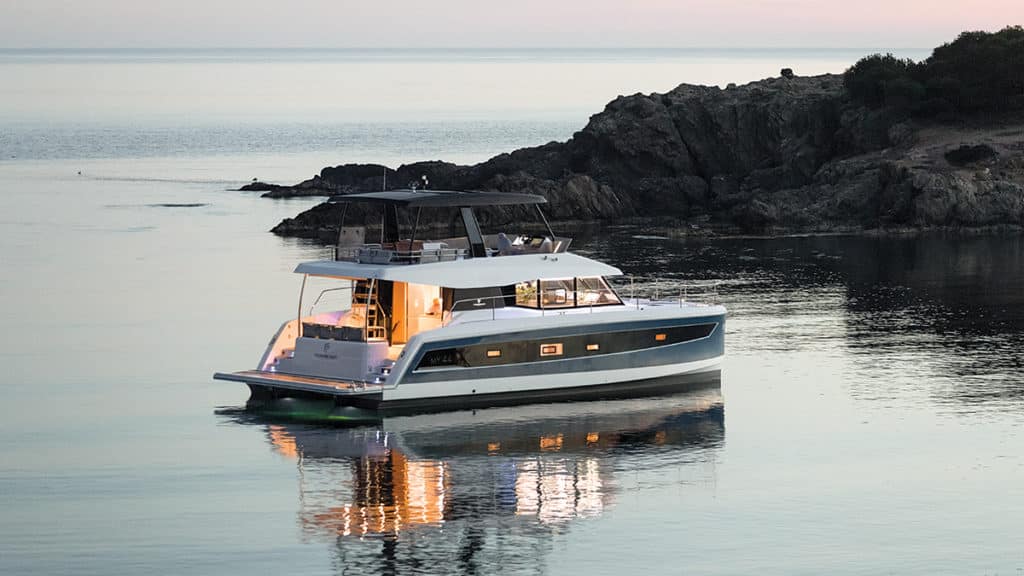
Quick Specifications
| 44’ | |
| 21’5” | |
| 530 gal. | |
| 184 gal. | |
| 6’6” | |
| 32,850 lb. |
Silent Yachts 60
Solar panels, ocean-crossing range and self-sufficiency define the electric Silent-Yachts 60 power catamaran. If there was any question that the “Tesla moment” has arrived in yachting, the Silent 60 clearly provides a positive response. Consider, for a moment, crossing oceans in silence at 5 to 6 knots without consuming a drop of fuel and never needing to plan your course between fuel stops. Imagine sitting at anchor and running the air conditioning all night, not to mention all the galley appliances plus the washer-dryer, without the hum or fumes from a genset.
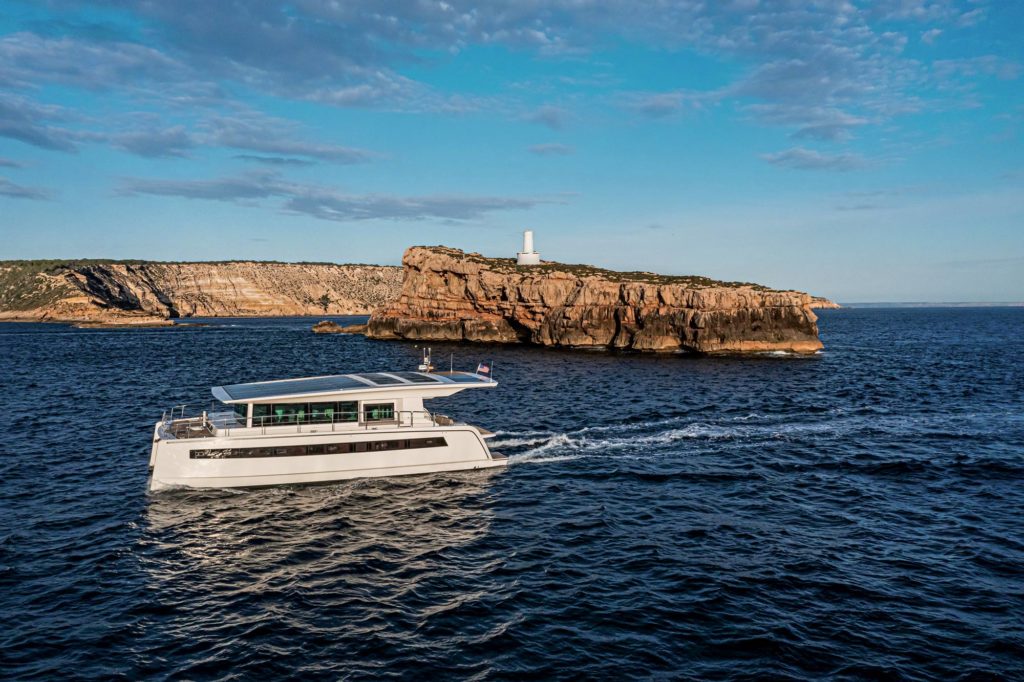
| 62’ | |
| 29’6” | |
| 4’5” | |
| 68,000 lb. |
Horizon PC74
As founder and director of The Powercat Company, a Horizon Power Catamarans distributor, Stuart Hegerstrom had long believed that catamaran builders needed to design their yachts to more stylish standards.
“The boats were very boxy,” he says, based on his years of experience with cats in the charter market. He and his partner, Richard Ford, asked Horizon to produce models that had high-end finishes and looked good inside and out.
The Horizon team brought in mega-yacht designer JC Espinosa to work with its own craftsmen. The result aboard the Horizon PC74 is a catamaran with exterior styling, layout and functionality that should appeal to private and charter owners alike.
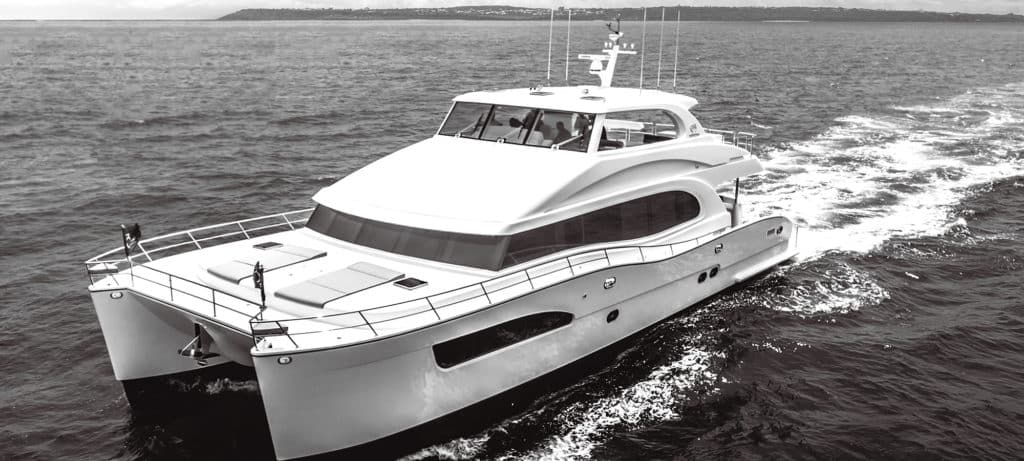
| 73’9” | |
| 28’3” | |
| 2,000 gal. | |
| 400 gal. | |
| 6’ | |
| 163,140 lb. |
The Aquila 36 is a departure from her sisterships in that she is an outboard-powered, express-cruiser-style catamaran, but she also adheres to MarineMax’s philosophies.
With a single main living level from bow to stern and a beam of 14 feet 7 inches, the Aquila 36 is like a bowrider on steroids. She has seating that can handle 20 adults for outings and barbecues, and there are two staterooms below, one in each hull, for family weekending. The staterooms have nearly queen-size berths, en suite heads, stowage and 6-foot-6-inch headroom.
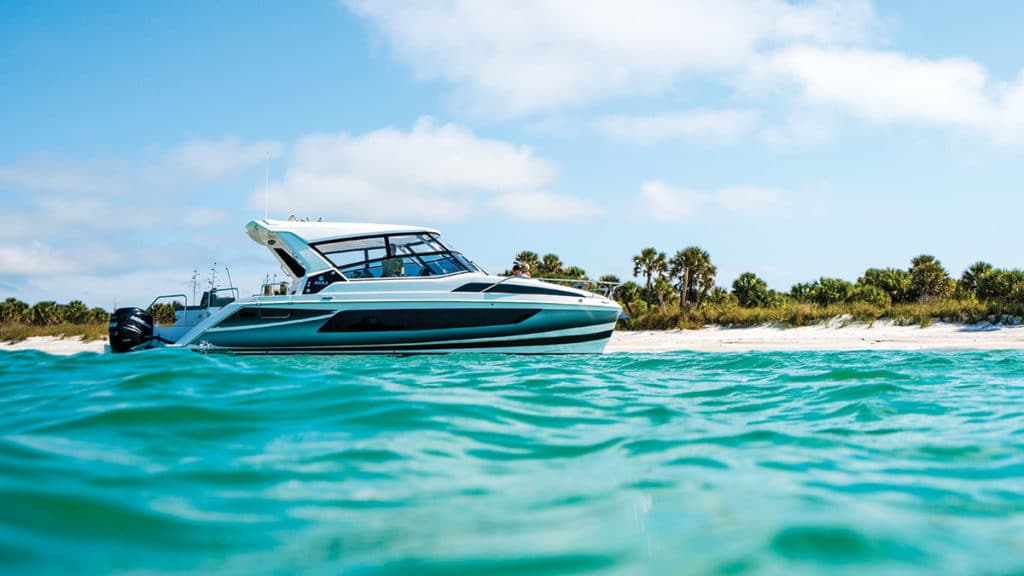
| 36’ | |
| 14’7” | |
| 356 gal. | |
| 200 gal. | |
| 2’ (engines trimmed up) | |
| 21,572 lb. |
Lagoon Seventy 8 Powercat
Lagoon is a division of Groupe Beneteau, the world’s largest builder of sailing yachts, and the Lagoon Seventy 8 Powercat is a developmental sistership of its Seventy 7 super sailing cat. The Seventy series yachts are built at Construction Navale Bordeaux in France, which had to add a new yard to construct these catamarans because they require separate stern molds for the power and sail versions.
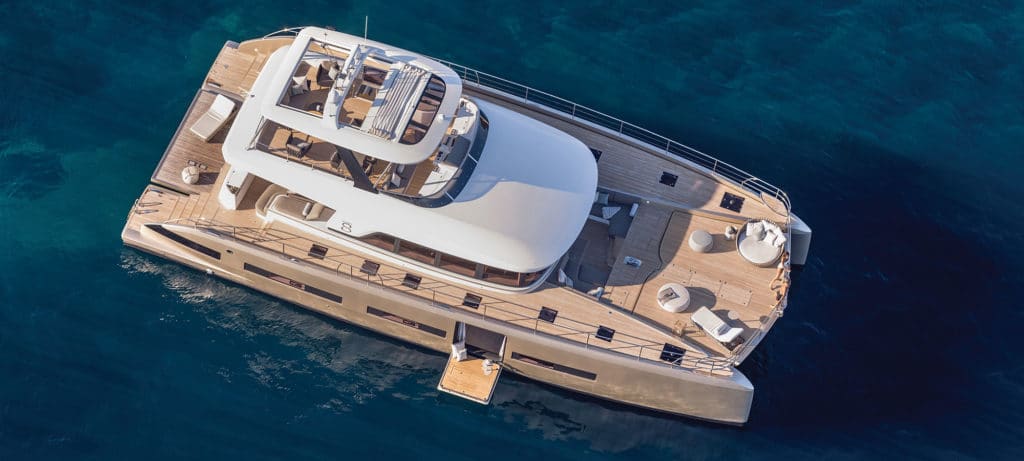
| 78’1” | |
| 36’1” | |
| 2,246 gal. | |
| 422 gal. | |
| 4’2” | |
| 131,153 lb. |
Horizon PC68
Multihull yachts ride differently than monohulls, often counteracting the sea’s motion for a smoother, more stable ride. On the Horizon PC68 , sharp hull entries make head seas seem gentle, and a Humphree stabilization system with blades reduces roll. Horizon uses SCRIMP construction for resin saturation that maximizes strength with an 111,112-pound displacement. And with a 5-foot-4-inch draft, the PC68 invites island cruising.
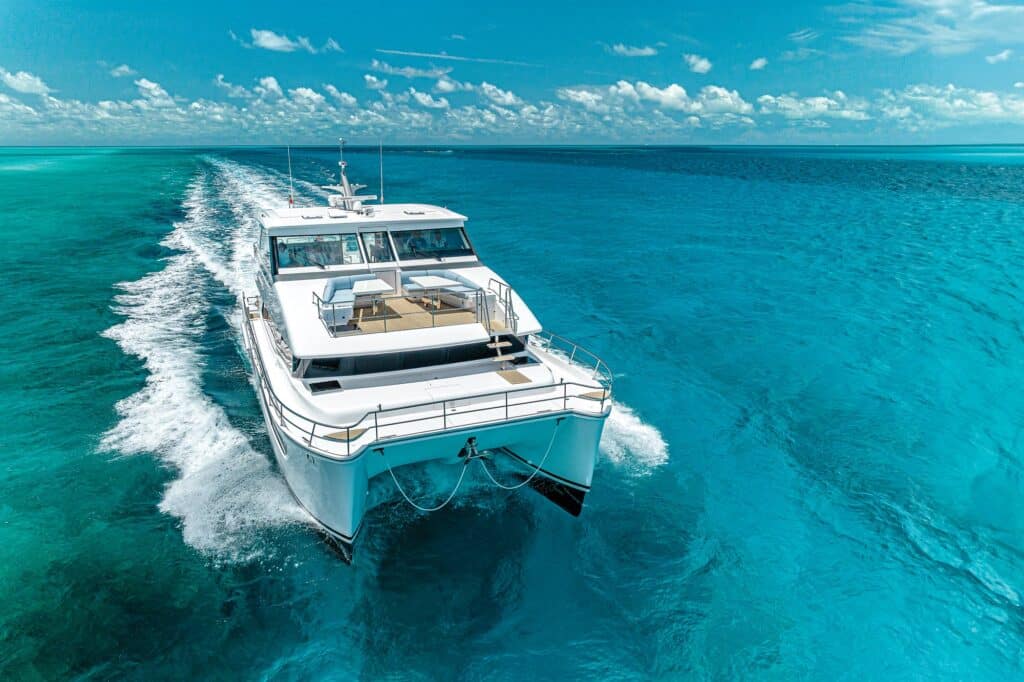
| 60’9” | |
| 24’6” | |
| 1,000 gal. | |
| 250 gal. | |
| 4’9” | |
| 83,467 lb. |
Two Oceans 555
With 27-knot speed, house-like volume, an on-deck master and top-tier tech, the Two Oceans 555 is a formidable power catamaran. Dave Jirikovic of HMY Yachts was on a quest. The sales broker was looking for the meanest, nastiest patch of Gulf Stream he could find to show a potential client what the Two Oceans 555 power cat could handle. And just as he had intended to show us, the broad-shouldered power cat didn’t even notice. He even dropped the single-lever throttles back to idle and left the 25-foot-wide Two Oceans 555 beam-on to another set of square-edged seas. The 55-footer brushed that off too. Jirikovic tried quartering into the seas—never a happy angle for catamarans—and the yacht drowsed through them.
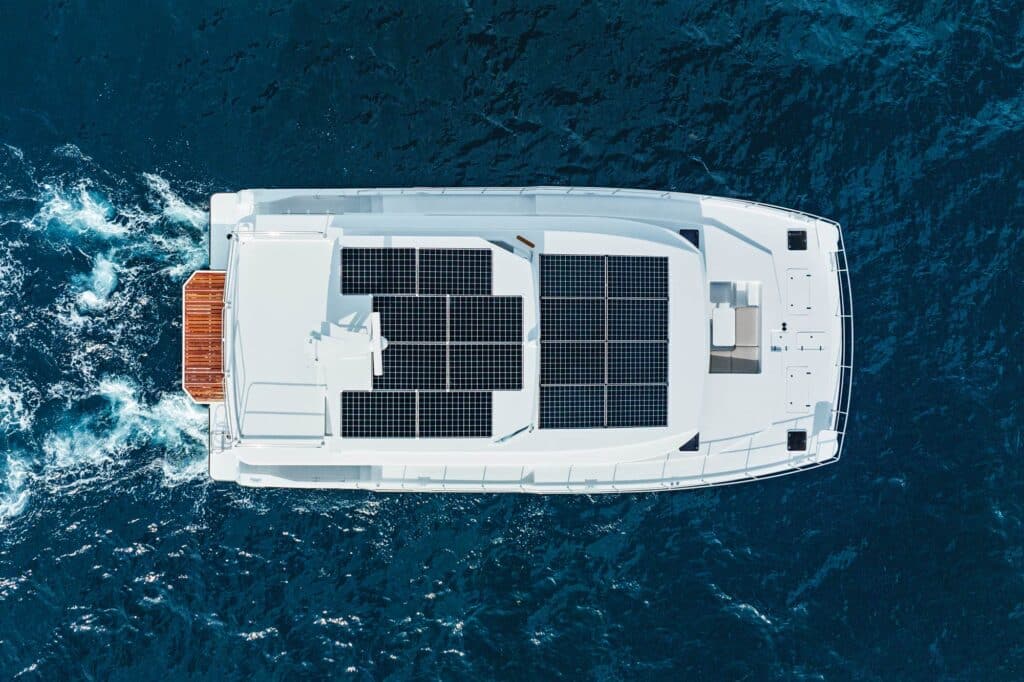
| 55’6” | |
| 25’ | |
| 750 gal. | |
| 200 gal. | |
| 49,600 lb. |
Fitted with the optional twin 300-horsepower Volvo Penta D4 diesels, the Lagoon 630 MY burns only 1.64 gph total at 6 knots, giving a theoretical range of 2,952 nautical miles with standard tankage of 793 gallons. Hull No. 1 had an optional 502-gallon tank, giving it transatlantic range.
Luxury, stability and economy are all hallmarks of Lagoon’s return to luxury motor yachts. If you can take a ride, it will be worth your time.
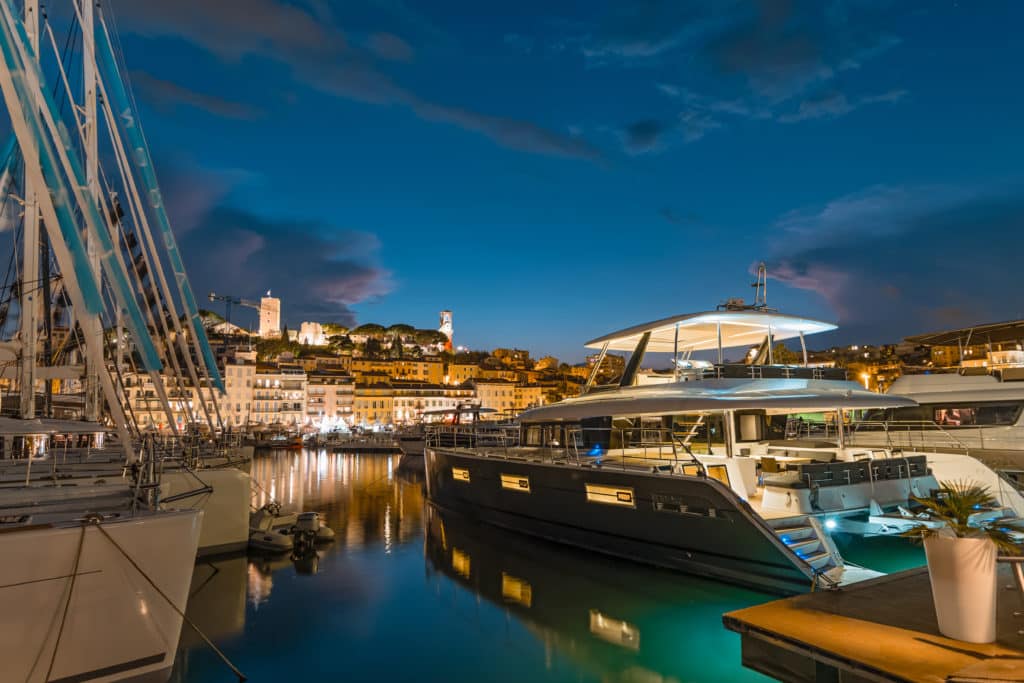
| 64’ | |
| 32’10” | |
| 793 gal. | |
| 254 gal. | |
| 3’11” | |
| 70,097 lb. |
Fountaine Pajot MY5
The flybridge deck on the Fountaine Pajot MY5 is a standout feature, offering virtually unobstructed 360-degree ocean views and an elevated beach club vibe. Aft of the off-center starboard helm is a spacious area perfect for entertaining, complete with a wet bar, refrigeration center, and ample seating. It’s the most popular space aboard according to the builder. And if the weather turns for the worse, a second helm station in the saloon allows the skipper to pilot the MY5 in climate-controlled comfort.
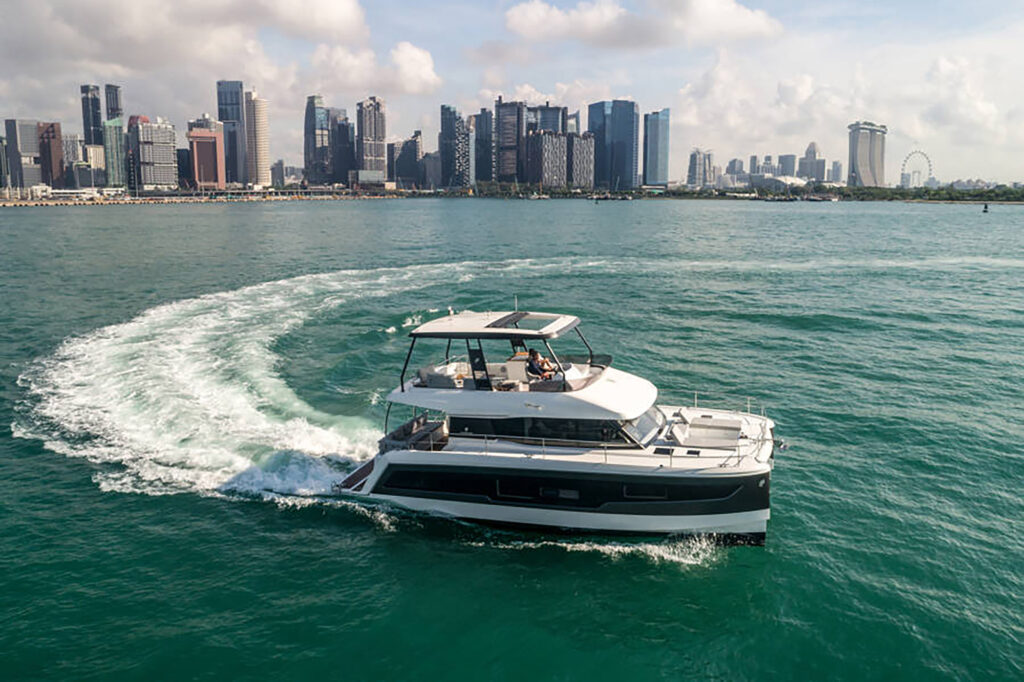
| 42’4” | |
| 19’9” | |
| 372 gal. | |
| 112 gal. | |
| 3’7” | |
| 46,000 lb. |
Prestige Yachts M8
How fitting it was that Prestige Yachts introduced its new M-Line flagship, the M8 , at Portopiccolo, a picturesque yachting village outside Trieste, Italy. Formerly a quarry, the cliff-side area had been chiseled into a clean site rife with eye-catching vistas, much like the French builder’s 65-foot power catamaran and its nearly 3,000 square feet of usable real estate.
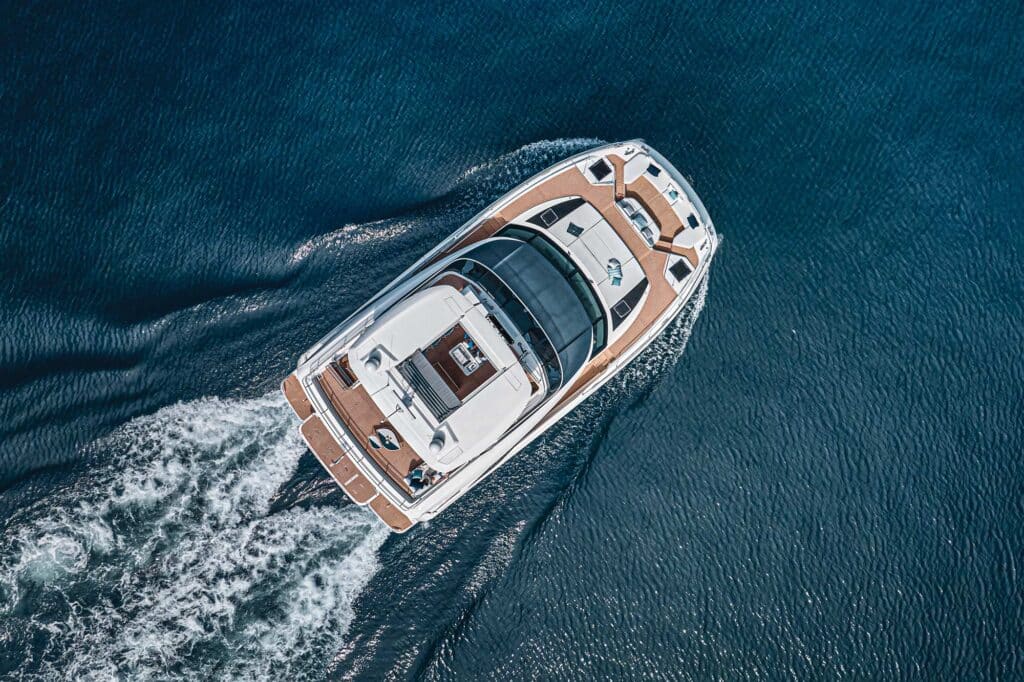
| 65’ | |
| 29’ | |
| 978 gal. | |
| 224 gal. | |
| 5’5” | |
| 98,379 lb. |
Aquila 47 Molokai
With every boat, there’s an origin story. In the case of the Aquila 47 Molokai power catamaran, it starts with MarineMax, which saw people renting boats for bareboat charters. MarineMax Vacations was born. After experimenting with several production yachts, the company decided to build its own: the Aquila line, designed for charter as well as for sale to owner-operators.
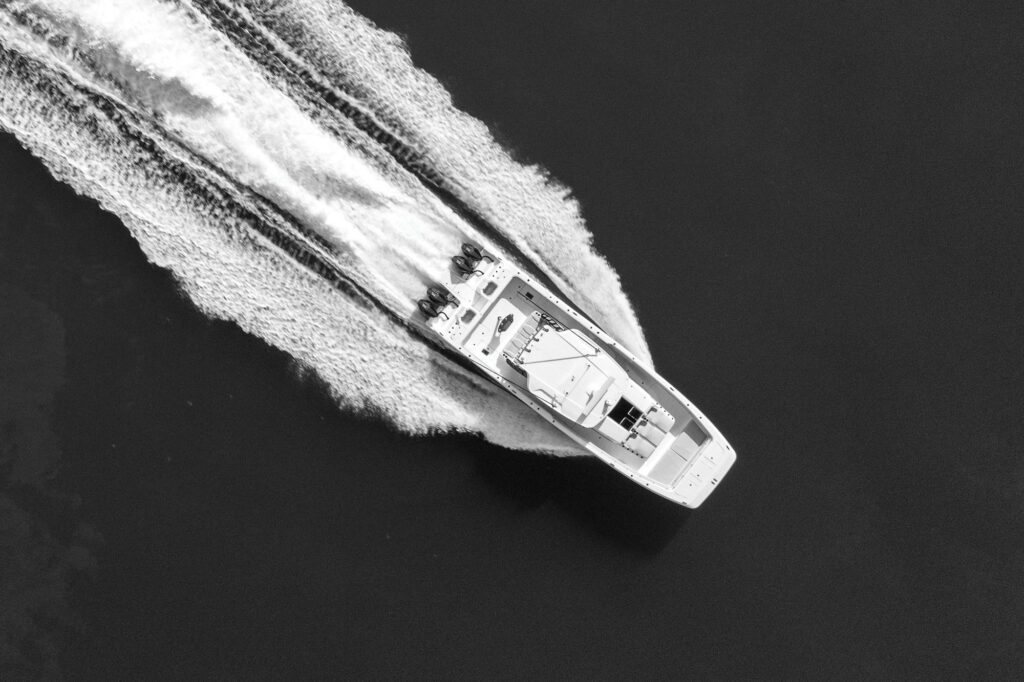
| 49’4” | |
| 14’7” | |
| 1,048 gal. | |
| 2’2” (engines trimmed up) | |
| 22,818 lb. |
- More: Aquila Boats , Fountaine Pajot , Horizon Power Catamarans , Lagoon , Lagoon Catamarans , Power Catamarans , Prestige Yachts , Silent-Yachts , Two Oceans , Yachts
- More Yachts
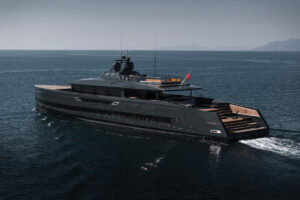
Alia Yachts to Debut SAN Superyacht in Monaco
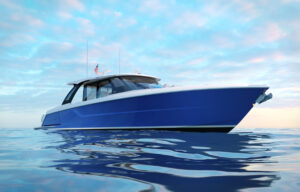
Coming Next Year: Tiara Yachts 56 LS

Top Nine Fishing Tenders For 2024

First Look: Meet the Apreamare 88 Motoryacht Flagship

Sunreef Yachts and North Sails Champion Eco-Friendly Build Materials

Recently-Refit: 100-foot Hatteras Motoryacht For Sale

Simrad Unveils Game-Changing NSX Ultrawide Displays

- Digital Edition
- Customer Service
- Privacy Policy
- Terms of Use
- Email Newsletters
- Cruising World
- Sailing World
- Salt Water Sportsman
- Sport Fishing
- Wakeboarding
672 Wine Club
- Motorcycles
- Car of the Month
- Destinations
- Men’s Fashion
- Watch Collector
- Art & Collectibles
- Vacation Homes
- Celebrity Homes
- New Construction
- Home Design
- Electronics
- Fine Dining
- Benchmark Wines
- Brian Fox Art
- Disneyland Resort
- Ka La’I Wakiki Beach
- Kalamazoo Grill
- Raffles Hotels & Resorts
- Sports & Leisure
- Health & Wellness
- Best of the Best
- The Ultimate Gift Guide
- Austin Parker Unveils Not One but 6 New Yachts at Cannes Fest
The shipyard debuts two new lines, including three catamarans and three navetta yachts.
Rachel cormack.
Digital Editor
Rachel Cormack's Most Recent Stories
- Why Richemont’s CEO Believes Luxury Watchmakers Need to Cut Production
- LVMH Could Become a Major Sponsor of Formula 1
- Share This Article

Austin Parker made quite the splash at the Cannes Yachting Festival this week.
Related Stories
- F1 Racer Lando Norris Just Drove a McLaren P1 Made of Legos
- Ram’s First All-Electric Pickup Truck Will Go Into Production Later This Year
- SpaceX’s Polaris Dawn Crew Just Completed the First Civilian Spacewalk

Both Unica and Iconica blend classic Italian style with modern tech. Drawing inspiration from the CAT56 that was introduced at Cannes last year, the newcomers strike a balance between sporty and chic. The inaugural six vessels showcase sleek, elegant exteriors with aerodynamic profiles and a new, signature A-shaped hardtop support.
The models will incorporate green innovations such as solar panels to minimize environmental impact and state-of-the-art navigation systems to improve the cruising experience. Each will also be outfitted with premium materials and luxurious furnishings. The outdoor decks will be adorned pieces from the Segno collection Pininfarina designed for Reflex, for instance.

The Unica multihulls are designed to offer a “unique,” one-of-a-kind experience on the sea. The cats feature spacious living areas with large windows that illuminate all within. The interior and exterior spaces are seamlessly connected, enabling seafarers to navigate the vessels with ease. Each Unica is also adorned with a lavish, full-beam owner’s suite.
“Austin Parker’s new range of yachts represents our commitment to innovation, luxury, and sustainability,” Austin Parker president Baris Nalcaci said in a statement.
The Unica 58 will be in the water at Cannes from September 10 to 15. Austin Parker will also have a scale model of the new Iconica 100 on display at the show.
Rachel Cormack is a digital editor at Robb Report. She cut her teeth writing for HuffPost, Concrete Playground, and several other online publications in Australia, before moving to New York at the…
Read More On:
- Austin Parker
- Pininfarina
More Marine

What It’s Like to Watch an America’s Cup Race Right From the Water

This New 72-Foot Yacht’s New Hybrid Propulsion System Is the First of Its Kind

Axopar Just Unveiled Two Electric Boats Capable of Reaching Thrilling Speeds

This New Solar-Electric Catamaran Comes With a Massive, Fold-Down Beach Club

Meet the Wine Club That Thinks Differently.
Receive editor-curated reds from boutique California producers four times a year.
Give the Gift of Luxury
Latest Galleries in Marine

The AX/E 22 and AX/E 25 in Photos

Phobos and Deimos Superyachts in Photos
More from our brands, sheer looks are trending at 2024 toronto international film festival red carpet with jamie lee curtis, daisy edgar-jones and more, cristiano ronaldo claims 1 billion social media followers, linkin park rises from the ashes with dark songs, a joyful attitude and a new singer who does primal scream therapy proud: concert review, skarstedt gallery to open in chelsea space formerly owned by cheim & read, the best yoga mats for any practice, according to instructors.

Tasman C43 Just Listed
Used yachts for sale, sail catamarans 40ft > 50ft, tasman boats for sale, tasman c43 boats for sale.
Buy with Confidence
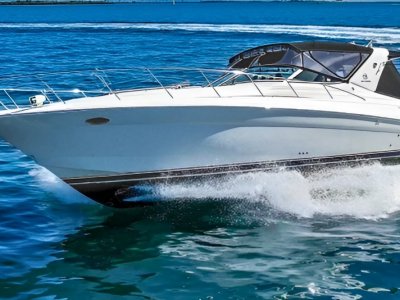

The global authority in superyachting
- NEWSLETTERS
- Yachts Home
- The Superyacht Directory
- Yacht Reports
- Brokerage News
- The largest yachts in the world
- The Register
- Yacht Advice
- Yacht Design
- 12m to 24m yachts
- Monaco Yacht Show
- Builder Directory
- Designer Directory
- Interior Design Directory
- Naval Architect Directory
- Yachts for sale home
- Motor yachts
- Sailing yachts
- Explorer yachts
- Classic yachts
- Sale Broker Directory
- Charter Home
- Yachts for Charter
- Charter Destinations
- Charter Broker Directory
- Destinations Home
- Mediterranean
- South Pacific
- Rest of the World
- Boat Life Home
- Owners' Experiences
- Conservation and Philanthropy
- Interiors Suppliers
- Owners' Club
- Captains' Club
- BOAT Showcase
- Boat Presents
- Events Home
- World Superyacht Awards
- Superyacht Design Festival
- Design and Innovation Awards
- Young Designer of the Year Award
- Artistry and Craft Awards
- Explorer Yachts Summit
- Ocean Talks
- The Ocean Awards
- BOAT Connect
- Between the bays
- Golf Invitational
- BOATPro Home
- Superyacht Insight
- Global Order Book
- Premium Content
- Product Features
- Testimonials
- Pricing Plan
- Tenders & Equipment

Third new build Sunreef 43M Eco catamaran sold to repeat client
Polish catamaran specialist Sunreef Yachts has announced that it has sold a third 43M Eco at this year's Cannes Yachting Festival . The buyer is a repeat client who previously owned a 24.4-metre Sunreef 80 Power.
"We're very proud to have a client go fully eco," said Sunreef CTO and co-founder Nicolas Lapp. "And we are already talking with other customers [about the 43M Eco]. The interest in sustainable yachting is growing. This is the direction that we wanted to go in, so we're happy to see the market agrees."
The first unit was sold in late 2022 and will be the world's largest electric catamaran once delivered.
The hull, superstructure and rigging of the vessel is designed with integrated solar panels that supply the yacht with 250kWh of energy in a 24-hour period. An advanced hydro-generation system will also produce "clean power" for emission-free cruising and "infinite range", according to the shipyard.
Accommodation is for 12 guests, including a master cabin with a private office and direct access to a lounge space at the bow.
Leisure highlights include an "ocean lounge" that connects the aft deck to the swim platform, creating a single space for waterside lounging. This area is heavily customisable, with clients able to instal a massage room, a bar or a fitness area. An invisible aft garage is also nearby for tender and toy storage.
A second sun lounging option can be found up on the flybridge, arranged with a spa pool, sunpads, a bar and dining area and an outdoor cinema.
This follows the reveal of a smaller entry in the shipyard's sailing catamaran series, the 35M Eco.
Sign up to BOAT Briefing email
Latest news, brokerage headlines and yacht exclusives, every weekday
By signing up for BOAT newsletters, you agree to our Terms of Use and our Privacy Policy .
Similar yachts for sale
More stories, most popular, from our partners, sponsored listings.

IMAGES
VIDEO
COMMENTS
Maneuverability - Yachts take more skill to maneuver tight spaces, while catamarans can turn 360 degrees within their own length.; Windward Performance - Yachts point higher into the wind and sail more efficiently upwind.Catamarans excel on reaches and downwind sailing. So for performance-oriented sailing, monohull yachts have some advantages.
Catamaran vs Sailing Yacht. While both catamarans and sailing yachts offer excellent experiences on the water, they differ in design and capabilities. Catamarans provide enhanced stability and a shallow draft, allowing for smooth sailing in various conditions and closer to shore. Sailing yachts, on the other hand, feature a single hull and ...
It's easily arguable that a sailing yacht was more fun to sail, takes up less room when mooring, and is cheaper per berth than a catamaran. Alternatively, a more stable catamaran offers more space and is cheaper per sq. foot of space. Until recently, the advent of catamarans in the America's Cup competitions would show that catamarans are ...
Unlike yachts, catamarans generally have a minimum of two engines. These motors enhance the level of maneuverability of the vessel. In other words, catamarans are easier to pilot or maneuver than yachts of the same length. Furthermore, the presence of a second engine on a catamaran makes it noticeably more potent than a yacht.
Catamarans don't coast well primarily because they don't have a deep keel to track. Relying on coasting to a dock at a shallow angle and then going into reverse and using prop walk to cozy up the stern won't work. It is better to come in at a sharper angle and then pivot the boat into position with the engines.
When sailing downwind, catamarans usually achieve greater speed than sailboats. Sailboats, on the other hand, perform better when sailing upwind. During turns, sailboats are better manoeuvrable and respond to a helm better, while catamarans lose the necessary impulse for a prompt turn faster. Unlike a sailboat, a catamaran is practically ...
Shape / Number of hulls. The main difference is the shape of the boat: a yacht or traditional sailing boat has one hull (the bottom of the boat) which sits in the water, but a catamaran is a 'multi-hull' so has two hulls or points of contact with the sea, with a platform across the top which joins the two hulls together into one boat shape.
Catamarans are known for their unique design, which features two parallel hulls connected by a deck. This design provides several advantages over traditional monohull boats, such as stability and speed. With their wide beam, catamarans have a reduced risk of capsizing and can access shallow waters due to their shallow drafts 1.
Catamaran vs. Yacht: Cost Differences. A new, high-quality catamaran larger than 40 feet can run about half a million in cost. Pre-owned catamarans can run as low as $35,000, while larger, new catamarans can exceed $5 million. Catamarans will also cost more because of the need for two engines and two rudders.
A catamaran (/ ˌkætəməˈræn /) (informally, a "cat") is a watercraft with two parallel hulls of equal size. The distance between a catamaran's hulls imparts resistance to rolling and overturning. Catamarans typically have less hull volume, smaller displacement, and shallower draft (draught) than monohulls of comparable length.
Cost: Depending on how well the Catamaran is equipped, it can be more expensive than trimarans. Not always, though. Harbor Cost: As catamarans have a very large beam, this means that a berth at the marina will be higher. Navigation: Catamarans tend to struggle sailing close to the wind. Trimarans. Pros. Speed: Trimarans are known for being faster than cats and single-hull boats.
Choosing between a catamaran and a yacht is a personal decision, influenced by various factors. While catamarans offer stability and space, yachts bring with them a legacy of tested safety in diverse conditions. Ultimately, the safety of any vessel is a combination of its design, maintenance, the crew's expertise, and the decisions made ...
The Best Catamarans for Sailing Around the World A catamaran is a double-hulled boat with a deck or cabin area in between (bluewater cat definition in this article).The double hull design means that the boat rocks less, sits higher on the water, uses less fuel to sail, and can be sailed in shallower waters than a single-hulled boat without worrying about grounding.
Best catamaran and multihull: We sail the very best yachts on two and three hulls. Toby Hodges takes a look at all the nominees and the winner of the best catamaran and multihull category in the ...
This guide will walk through the basics of catamaran boats to help you understand your options if you're in the market for a vessel like this, or if you're new to boats and just learning boat terminology and design. Catamarans come in all shapes, sizes, and designs. Photos via Atlantic Cruising Yachts, Galati Yacht Sales, Spellman Marine ...
Listed hull types include catamaran, monohull, trimaran, deep vee and other. Built by a wide variety of yacht building companies, YachtWorld presently offers a selection of 1,914 catamaran yachts for sale. Among them, 480 are newly built vessels available for purchase, while the remaining 1,434 comprise used and custom yachts listed for sale.
Photo via World Cat Boats. World Cat is one of the most recognizable brands in the world of power catamarans — in fact, according to the company they're the largest producer of power catamarans in the world. Their line is a mix of center console and dual console fishing and family boats ranging from 23' to 40'.
The catamaran will move around with the wind, always staying flat, while the sailboat will rock from side to side and might even get you seasick. This is especially noticeable when the wind is opposing the waves, making the boat have the wind pushing it from one side and the waves banging it from the other side.
7. Shallow Draft Equals Better Anchorages. Catamarans have significantly shallower drafts than monohulls, allowing for safer anchorages closer to shore. Most catamarans in the 40-ft to 50-ft range draw between 3-ft to 4.5-ft, so they can anchor in places that a monohulls can not even consider.
Aug 17, 2015. Two sailboat experts argue monohull vs. catamaran. Contributed by Denison Yacht Sales. The great debate over which is better—one or two hulls—boils down to several factors, each with distinct advantages and disadvantages. The verdict usually defaults to personal preference and intended use of the vessel, but that didn't stop ...
Multihulls can be relatively quick in the right offwind conditions, but if they are heavily laden - as they will be for blue water cruising - there really is no significant speed advantage. The Gunboat 66 Phaedo 1 piles on the speed, but for blue water cruisers, comfort and stowage is more important than pace.
Catamaran is a yacht brand that currently has 41 yachts for sale on YachtWorld, including 14 new vessels and 27 used yachts, listed by experienced boat and yacht brokers mainly in the following countries: United States, Spain, France, French Polynesia and South Africa. The selection of models featured on YachtWorld spans a spectrum of sizes and ...
One thought to keep in mind when comparing monohull boats and catamarans is that their different shapes account for different space advantages. For example, a 40-foot long catamaran will have much more cubic space than a 40-foot long monohull. Because of this, when comparing boats, you should look at the cubic space rather than the length.
Silent Yachts 60. Solar panels, ocean-crossing range and self-sufficiency define the electric Silent-Yachts 60 power catamaran. If there was any question that the "Tesla moment" has arrived in yachting, the Silent 60 clearly provides a positive response. Consider, for a moment, crossing oceans in silence at 5 to 6 knots without consuming a drop of fuel and never needing to plan your course ...
The Unica range includes three catamarans measuring 58 feet (pictured top), 68 feet, and 78 feet, while the Iconica collection comprises three navetta yachts spanning 77 feet, 88 feet, and 100 ...
Tasman C43. Doesn't Mata is a superb example of the popular, Australian built Tasman C43 catamaran. She is ready for new owners to...Find out more. Tasman C43. Doesn't Mata is a superb example of the popular, Australian built Tasman C43 catamaran. ... Yachts and Boats for Sale Australia - Sell Your Yacht, Boat and Sailing Accessories ...
Find more information and images about the boat and contact the seller or search more boats for sale on YachtWorld. ... 2025 Custom Omaya 50 Power Catamaran. Request price. Seattle, Washington. 2023 Lagoon 55. €2,275,000 (US$2,518,457) Cruising Croatia, Croatia. 2024 HopYacht 30. US$299,000.
Polish catamaran specialist Sunreef Yachts has announced that it has sold a third 43M Eco at this year's Cannes Yachting Festival.The buyer is a repeat client who previously owned a 24.4-metre Sunreef 80 Power. "We're very proud to have a client go fully eco," said Sunreef CTO and co-founder Nicolas Lapp.